This is the second report on the wood structure of Nepal Himalayan woody plants, the first part of which was published in The Himalayan Plants, Volume 1, pp.341-379 (ed. by H. Ohba and S. B. Malla, 1988). Following nearly the same methods and style as the previous paper, we describe here wood structure of 58 species in 15 families: Theaceae (5 species), Stachyuraceae (1), Dipterocarpaceae (1), Aquifoliaceae (4), Hippocastanaceae (1), Aceraceae (7), Rosaceae (17), Cornaceae (4), Alangiaceae (2), Toricelliaceae (1), Symplocaceae (6), Proteaceae (1), Juglandaceae (2), Myricaceae (1), and Betulaceae (5). These families are arranged following 'An enumeration of the flowering plants of Nepal' edited by H. Hara, A. O. Chater and L. H. J. Williams (1982). After publication of the previous paper, the third expedition to Nepal was made from June to September in 1988, and 635 wood samples were newly collected. Some of the new collections are also utilized in this paper.
We made ten sets of microscopic slides for each wood sample. The microscopic slides of the previous paper are deposited in or has been sent to the following nine laboratories: National Herbarium and Plant Laboratories, Department of Forestry and Plant Research (formerly Department of Medicinal Plants), Ministry of Forests and Soil Conservation, H.M.G. Nepal, Kathmandu; Department of Biology, College of Liberal Arts, Kanazawa University, Kanazawa; Department of Botany, University Museum, University of Tokyo, Tokyo; Department of Biology, Faculty of Science, Osaka City University, Osaka; Wood Research Institute, Kyoto University, Kyoto; Forestry and Forest Products Research Institute, Tsukuba; Rijksherbarium, Leiden; Royal Botanic Gardens, Kew, Richmond; and Forest Products Laboratory, U. S. Department of Agriculture, Madison.
The microscopic slides in the present paper will be deposited or sent to nearly same institutes. The voucher herbarium specimens will be deposited in the following three institutes: National Herbarium and Plant Laboratories, Department of Forestry and Plant Research, Ministry of Forests and Soil Conservation, H.M.G. Nepal, Kathmandu; Department of Biology, College of Liberal Arts, Kanazawa University, Kanazawa; and Department of Botany, University Museum, University of Tokyo, Tokyo.
We are grateful to Dr. S. B. Malla, the Director-General, and the staff of the Department of Forestry and Plant Research, members of the National Council for Science and Technology, H.M.G. Nepal, Dr. Hideaki Ohba, the University Museum, University of Tokyo, for their help and hospitality in the course of the study. Thanks are also due to Dr. Takashi Yamazaki, University of Tokyo, Dr. K. R. Rajbhandari, Department of Forestry and Plant Research, H.M.G. Nepal, and Dr. H. Iketani, Fruit Tree Research Station, Tsukuba, for their critical identification of voucher specimens.
* Asterisked specimens are those on which the descriptions and microscopic photographs are mainly based upon.
** For the convenience of description, diameters of pores, in which vessel walls are included, are expressed as the radial measurements always come first followed by tangential measurements as the following example: Pores minute, 25-55 (average 41) × 25-40 (average 34) ; µm; for the diameter of pits, vertical measurements always come first followed by horizontal measurement; for the diameter of ray cells, vertical measurements also come first followed by tangential and radial measurements as follows: Procumbent cells 15-20, 20-30 × 75-125 µm.
THEACEAE (Kiyotsugu YODA and Mitsuo SUZUKI)
Camellia kissi Wall. [Plate 5]

Small evergreen trees in the temperate zone.
SPECIMENS. No. 8540122, d=25 cm, h=4 m, alt. 1850 m: Bagmati Zone, Nuwakot Distr., Gopte (3350m) - Kutumsang (2450 m), M. Suzuki & S. Noshiro, June 4, 1985. No. 8540135, d=15 cm, h=4 m, alt. 1980 m: Bagmati Zone, Dolakha Distr., Jiri (1860 m) - Ratmate (2270 m) - Shivalaya (1800 m), H. Ohba et al., July 4, 1985. No. 8840131*, d=5 cm, h=3 m, alt. 1800 m: Koshi Zone, Sakuwasabha Distr., Mude (2040 m) - Num (1540 m), M.Suzuki et al., July 10, 1988. No. 8840606, d=18 cm, h=4.5 m, alt. 1690 m: Dhawalagiri Zone, Mustang Distr., Lumle (1600 m) - Kande (1740 m), M. Suzuki et al., Sept. 7, 1988.
DESCRIPTION. Wood diffuse porous. Growth rings rather distinct, delineated by radially flattened fiber-tracheids, narrow to slightly wide, 0.2-1.7 mm. Pores evenly distributed, rather numerous, 97-141/mm2, mostly solitary, angular and polygonal in outline, minute, 25-55 (average 41) × 25-40 (average 34) µm, thin-walled.
Vessel elements 600-710 µm long. End walls steeply oblique. Perforation plate scalariform with 12-27 bars. Intervessel pits sometimes observed, scalariform. Helical thickenings not observed. Tyloses or gum-like deposits absent.
Fiber-tracheids constitute ground mass of the wood, triangular, square or polygonal in cross section, 13-18 µm in diameter; walls rather thick, about 4.5 µm; pits circular, about 7 µm in diameter with oblique slit-like apertures, non-septate.
Wood parenchyma diffuse-in-aggregates, triangular, rectangular or polygonal in cross section, in strands; cells 18-28 µm in diameter and 70-140 µm long; vesselparenchyma pits scalariform to opposite, horizontally elongated to elliptical, 10-25 µm in horizontal diameter; crystals not observed.
Rays heterogeneous, narrow and low, 1-3 cells wide. Uniseriate rays composed of upright and square cells, 220-410 µm tall. Multiseriate rays narrow and low, 18-28 µm wide and 260-600 µm tall, with uniseriate wings of 200-410 µm tall composed of upright and square cells, and multiseriate bodies of 160-480 µm tall composed of procumbent cells. Procumbent cells 15-20, 7-18 × 75-125 µm, square and upright cells 25-45, 10-30 × 30-95 µm. Ray-vessel pits scalariform, elliptical to horizontally elongated, 10-25 µm in horizontal diameter. Simple crystals often observed in swollen ray cells.
Eurya acuminata DC.[Plate 6]
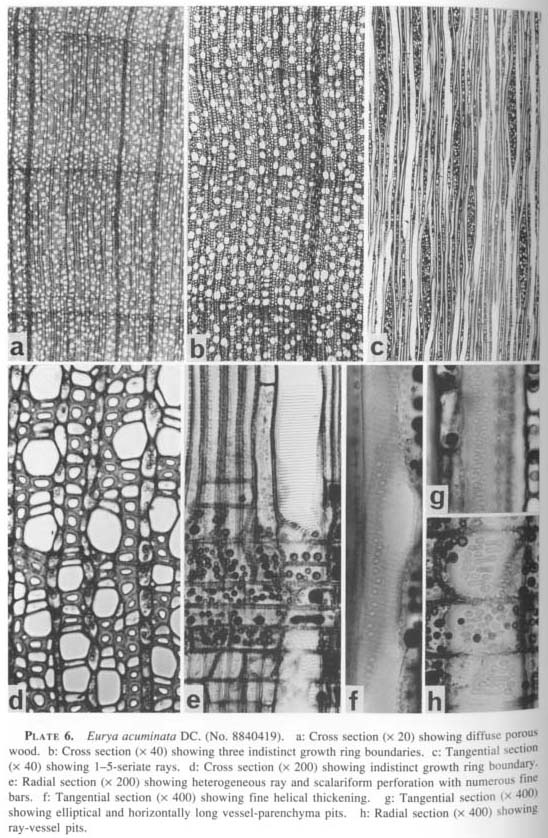
Small or medium-sized evergreen trees in the temperate zone.
SPECIMENS. No. 8340439, d=20 cm, h=6 m, alt. 2200 m: Janakpur Zone, Dolakha Distr., Simigaon (1950m) - Kyalche (2700 m), H. Ohba et al., Aug. 31, 1983. No.8340499, d=25 m, h=7 m, alt. 2130 m: Janakpur Zone, Dolakha Distr., Phedi Kharka (2100 m) - Koplang (2100 m), H. Ohba et al., Sept. 14, 1983. No. 8840099, d=12 cm, h=5 m, alt. 1890 m: Koshi Zone, Sakuwasabha Distr., Chichila (1870 m) - Kuwapani (1940 m), M. Suzuki et al., July 9, 1988. No. 8840419*, d=12 cm, h=3 m, alt. 2060 m: Gandaki Zone, Kaski Distr., Pothana (1970 m) - Tolka (1750 m), M. Suzuki et al., Aug. 20, 1988
DESCRIPTION. Wood diffuse porous. Growth rings rather distinct and sometimes indistinct, delineated by radially flattened fiber-tracheids, narrow to a little wide, 0.2-2.7 mm. Pores evenly distributed, rather numerous, 102-134/mm2, almost solitary, angular and polygonal to square in outline, minute, 25-60 (average 44) × 20-40 (average 35) µm, thin-walled.
Vessel elements 790-940 µm long. End walls steeply oblique. Perforation plates scalariform and sometimes reticulate; bars very numerous, 49-120; intervessel pits rarely observed, scalariform to transitional. Fine helical thickenings observed. Tyloses or gum-like deposits absent.
Fiber-tracheids constitute ground mass of the wood, triangular, square, rectangular to polygonal in cross section, 15-25 µm in diameter, thick-walled (about 4.5 µm), non-septate; pits circular, about 7 µm in diameter, with oblique slit-like apertures.
Wood parenchyma diffuse, triangular, rectangular to polygonal in cross section, in strands; cells 13-25 µm in diameter and 100-190 µm in height. Vessel-parenchyma pits opposite and scalariform, circular, elliptical and horizontally elongated, 5-10 µm in horizontal diameter. Crystals absent.
Rays heterogeneous, narrow uniseriate and wide multiseriate. Uniseriate rays composed of upright and square cells, fairly tall, 350-1200 µm tall, Multiseriate rays wide and tall, 2-7 cells or 25-80 µm wide and 350-1100 µm tall, have uniseriate wings of 280-730 µm tall, composed of upright and square cells, and tall multiseriate bodies of 410-880 µm tall, composed of procumbent cells. Procumbent cells 30-50, 10-22 × 230-320 µm, square and upright cells 40-70, 10-20 × 35-55 µm. Ray-vessel pits tend to be opposite, dense, circular, elliptical or horizontally elongated, 4-18 µm in horizontal diameter. Crystals absent.
Eurya cavinervis Vesque [Plate 7]
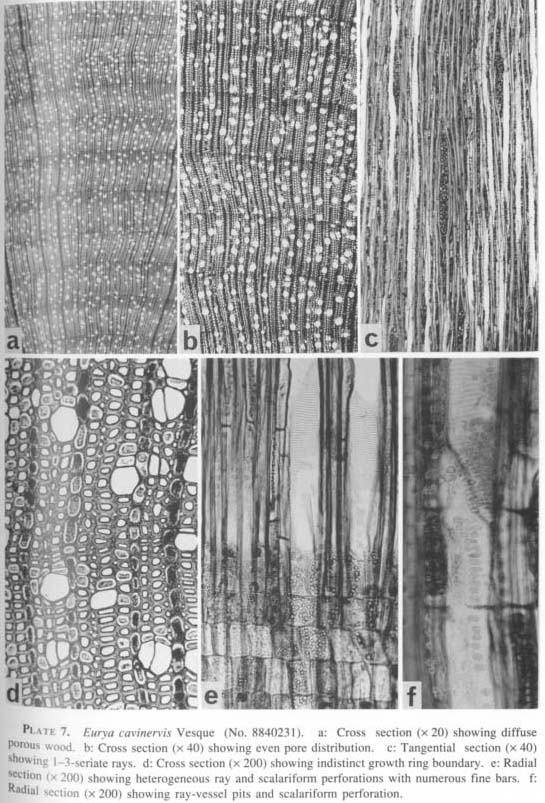
Evergreen shrubs with creeping stems in the upper temperate zone.
SPECIMEN. No. 8840231, d=3 cm, h=l m, alt. 3090 m: Koshi Zone, Sakuwasabha Distr., Danda Kharka (2860 m) - Unshisa Kharka (3150 m) - Khongma (3500 m), M. Suzuki et al., July 15, 1988.
DESCRIPTION. Wood diffuse porous. Growth rings rather distinct, delineated by radially flattened fiber-tracheids, narrow to very narrow, 0.1-0.5 mm ; tissue elements arranged on undulating radial lines. Pores evenly distributed, numerous, 120-146/mm2, almost solitary, angular and polygonal to square in outline, minute, 20-40 (average 31) × 30-35 (average 32) µm, thin-walled.
Vessel elements long, 750-1010 µm. End walls steeply oblique. Perforation plates scalariform to transitional, and sometimes reticulate; bars numerous, 50-88. In
tervessel pits rare, scalariform. Fine helical thickenings observed. Tyioses or gum-like deposits absent.
Fiber-tracheids constitute ground mass of the wood, square, rectangular to polygonal in cross section, 13-20 µm in diameter, rather thick-walled (about 4 µm), nonseptate; pits circular, about 3 µm in diameter.
Wood parenchyma diffuse or scanty paratracheal, triangular, square or rectangular in cross section, in strands; cells 15-20 µm in diameter and 90-190 µm long; crystals not observed.
Rays heterogeneous, 1-4 cells wide. Uniseriate rays composed of upright and square cells, fairly tall, 270-1020 µm tall. Multiseriate rays tall, 30-64 µm wide and 400-1200 µm tall, have uniseriate wings of 180-550 µm tall, composed of upright and square cells, and tall multiseriate bodies of 360-480 µm tall, composed of procumbent cells. Procumbent cells 15-25, 8-25 × 55-80 µm, square and upright cells 25-115, 7-28 × 20-40 µm. Ray-vessel pits dense, elliptical to horizontally elongated, 5-10 µm in horizontal diameter. Crystal not observed.
Eurya cerasifolia (D. Don) Kobuski [Plate 8]
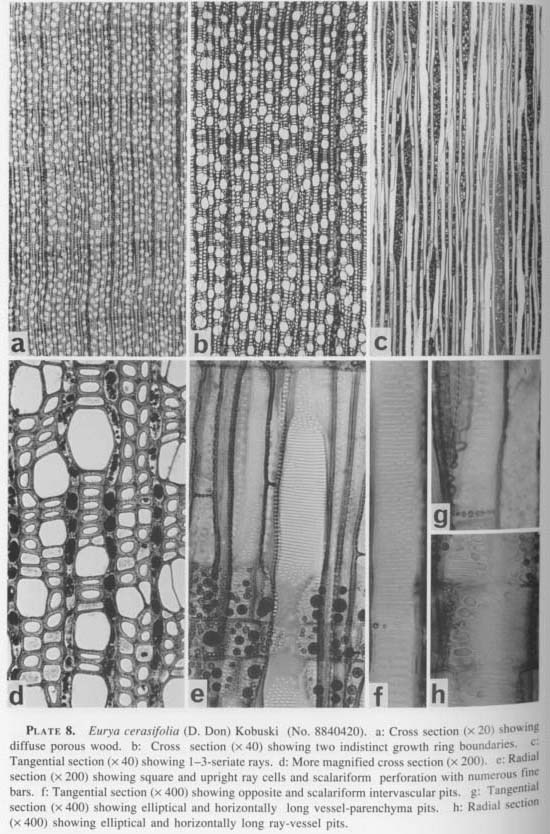
Small evergreen trees in the temperate zone.
SPECIMENS. No. 8340055, alt. 1750 m; No. 8340061, alt. 1810 m: Gandaki Zone, Kaski Distr., Suiket (1230 m)-Pothana (1970 m), H. Ohba et al., July 7, 1983. No. 8340515, d=35 cm, h=10 m, alt. 2000 m: Janakpur Zone, Dolakha Distr., Phedi Kharka (2100 m) - Koplang (2100 m), H. Ohba et al., Sept. 14, 1983. No. 8840081, d=18 cm, h=5 m, alt. 1910 m: Koshi Zone, Sakuwasabha Distr., Bhotebas (1800 m) - Gogane (1870 m) - Chichila (1870 m), M. Suzuki et al., July 8, 1988. No. 8840420*, d=32 cm, h=10 m, alt. 2100 m: Gandaki Zone, Kaski Distr., Pothana (1970 m) - Tolka (1750 m), M. Suzuki et al., Aug. 20, 1988.
DESCRIPTION. Wood diffuse porous. Growth rings indistinct, slightly delineated by radially flattened fiber-tracheids, narrow to a little wide, 0.3-3.1 mm. Pores quite evenly distributed, numerous, 110-135/mm2, almost solitary and sometimes in radial couples, minute to small, 40-75 (average 58) × 40-65 (average 45) µm, thin-walled.
Vessel elements long, 1000-2050 µm. End walls steeply oblique. Perforation plates scalariform and sometimes reticulate; bars numerous, 47-70. Intervessel pits scalariform to opposite, 3-23 µm in horizontal diameter. Fine helical thickenings observed. Tyloses or gum-like deposits absent.
Fiber-tracheids constitute ground mass of the wood, triangular, rectangular to polygonal in cross section, 23-30 µm in diameter, rather thick-walled (about 4 µm), non-septate; pits circular, about 5 µm in diameter, with oblique or vertical slit-like apertures.
Wood parenchyma diffuse or scanty paratracheal, rectangular to polygonal in cross section, in strands; cells 18-35 µm in diameter, 100-240 µm long; vessel-parenchyma pits opposite, circular to horizontally elongated, 5-23 µm in horizontal diameter, with slit-like apertures; crystals not observed.
Rays heterogeneous, 1-4 cells wide. Uniseriate rays composed of upright and square cells, fairly tall, 180-1100 µm tall. Multiseriate rays tall, 32-70 µm wide and 550-2900 µm tall, have very tall uniseriate wings of 320-1060 µm tall, composed of upright and square cells, and tall multiseriate bodies of 320-850 µm tall, composed of procumbent cells. Procumbent cells 20-30,10-25 × 170-200 µm, square and upright cells 40-80,10-22 × 25-60 µm. Ray-vessel pits dense, circular to horizontally elongated, 5-25 µm in horizontal diameter, with slit-like apertures. Crystals absent.
Schima wallichii (DC.) Korth. [Plate 9]

Large evergreen trees dominant in the upper subtropical zone.
SPECIMENS. No. 8340025, alt. 2010 m: Bagmati Zone, Kathmandu Valley, Mt. Pulchoke, H. Ohba et al., June 30, 1983. No. 8340045*, alt. 1250 m: Gandaki Zone, Kaski Distr., Suiket (1230m) - Pothana (1970m), H. Ohba et al., July 7, 1983. No. 8340423, d=35 cm, h=10 m, alt. 980 m: Janakpur Zone, Dolakha Distr., Malephu (900 m) - Pikhuti (950 m), H. Ohba et al., Aug. 27, 1983. No. 8840008, d=10 cm, h=6 m, alt. 1750 m: Koshi Zone, Dhankuta District, Hile (1910 m) - Pakhribas (1700 m), M. Suzuki et al., July 2, 1988.
DESCRIPTION. Wood diffuse porous. Growth rings absent or faintly observed because of a little difference of pore size, narrow to a little wide, 0.5-3.5 mm. Pores quite evenly distributed, 36-43/mm2, almost solitary and sometimes in radial couples, elliptical to circular in outline, slightly angular, 50-160 (average 111) × 60-110 (average 87) µm, rather thin-walled.
Vessel elements long, 740-1110 µm. End walls oblique. Perforation plates scalariform with 8-13 bars. Intervessel pits rarely observed, scalariform. Helical thickenings observed, especially at the tails of vessel elements. Tyloses or gum-like deposits absent.
Fiber-tracheids constitute ground mass of the wood, triangular, square to polygonal in cross section, 18-33 µm in diameter, thick-walled (about 8 µm), non-septate; pitscircular, about 7 µm in diameter, with oblique slit-like apertures.
Wood parenchyma diffuse, square to polygonal in cross section, in strands; cells 20-30 µm in diameter, 8-23 µm long; vessel-parenchyma pits circular to horizontally elongated with slit-like apertures in cross section, 8-23 µm in horizontal diameter. Crystals observed in series of vertically arranged square cells.
Rays heterogeneous, narrow and low, uni- or biseriate, irregular fusiform in outline. Both uniseriate and multiseriate rays composed of procumbent, square and upright cells. Uniseriate rays 190-550 µm tall. Multiseriate rays 32-60 µm wide and 240-520 µm tall. Procumbent cells 15-30, 10-25 × 85-150 µm, square and upright cells 35-75,10-28 × 40-50 µm. Ray-vessel pits circular to horizontally or obliquely elongated with slit-like apertures, about 8-50 µm in longer diameter. Crystals absent.
STACHYURACEAE (Akira TAKAHASHI and Mitsuo SUZUKI)
Stachyurus himalaicus Hook. f. et Thoms. ex Benth. [Plate 10]
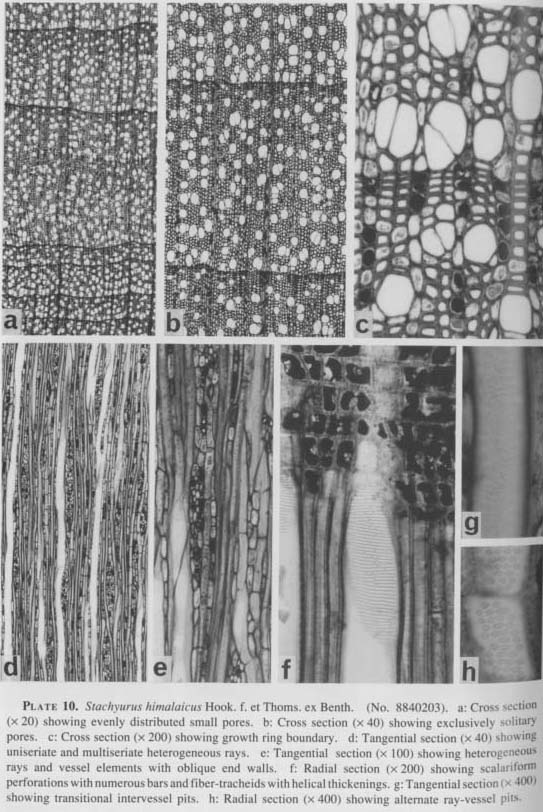
Large deciduous shrubs in mixed forests of deciduous and evergreen broad-leaved trees in the temperate zone.
SPECIMENS. No. 8540212, d=8 cm, h=4 m, alt. 2760 m: Bagmati Zone, Ramechap Distr., Neju (3650 m) - Choarma (2760 m), H. Ohba et al., Aug. 2, 1985. No. 8840203*, d=15cm, h=7m, alt. 2430 m: Koshi Zone, Sakuwasabha Distr., Uttise Kharka (2290m) - Bhainsi Kharka (2540 m), M. Suzuki et al., July 14, 1988.
DESCRIPTION. Wood diffuse porous. Growth rings distinct, delineated by radially flattened fiber-tracheids, narrow, 0.2-2.7 mm wide. Pith flecks often present. Pores
evenly distributed, many, 58-142/mm2, almost solitary, and rarely in radial multiples of 2-3 or in clusters. Solitary pores angular in outline, small, 25-110 × 30-75 µm, thin-walled, 1-2 µm thick.
Vessel elements long, 650-1200 µm; end walls oblique; perforation plates exclusively scalariform with many, 30-50 bars. Intervessel pits rarely observed, transitional to opposite, circular or horizontally elongated, 5 × 6-25 µm. Helical thickenings present but indistinct. Tyioses or gum-like deposits absent.
Fiber-tracheids consist ground mass of the wood, polygonal in cross section, 8-35 µm in diameter and walls 2-5 µm thick, non-septate; pits distinctly bordered, circular, 7-8 µm in diameter, with oblique slit-like apertures. Helical thickenings distinct.
Wood parenchyma predominantly apotracheal, diffuse and diffuse-in-aggregates, fairly abundant, in strands; cells 12-30 µm in radial diameter and 70-200 µm long. Vessel-parenchyma pits transitional to opposite, circular or horizontally elongated, 4-10 µm in horizontal diameter. Crystals absent.
Rays heterogeneous, uniseriate and multiseriate, 13-17 rays/mm length in tangential section. Uniseriate rays composed usually of upright and square cells, occasionally procumbent cells intermingled, 1-14 cells (60-850 µm), up to 22 cells (1400 µm) tall. Multiseriate rays 2-6 cells (20-70 µm) wide and 300-1700 µm, up to 2700 µm tall; square cells sheath the central cores consisting of procumbent cells; uniseriate wings composed of upright and square cells, 1-14 cells (60-850 µm), up to 23 cells (1170 µm) tall; sometimes two or three multiseriate portions connect vertically by uniseriate upright and square cells. Upright and square cells 25-120, 12-30 × 12-55 µm; procumbent cells 10-30, 7-30 × 35-130 µm. Ray-vessel pits usually opposite, circular or slightly elongated in horizontal direction, 4-6 µm in horizontal diameter. Crystals absent.
DIPTEROCARPACEAE (Akira TAKAHASHI and Mitsuo SUZUKI)
Shorea robusta Gaertn. [Plate 11 ]
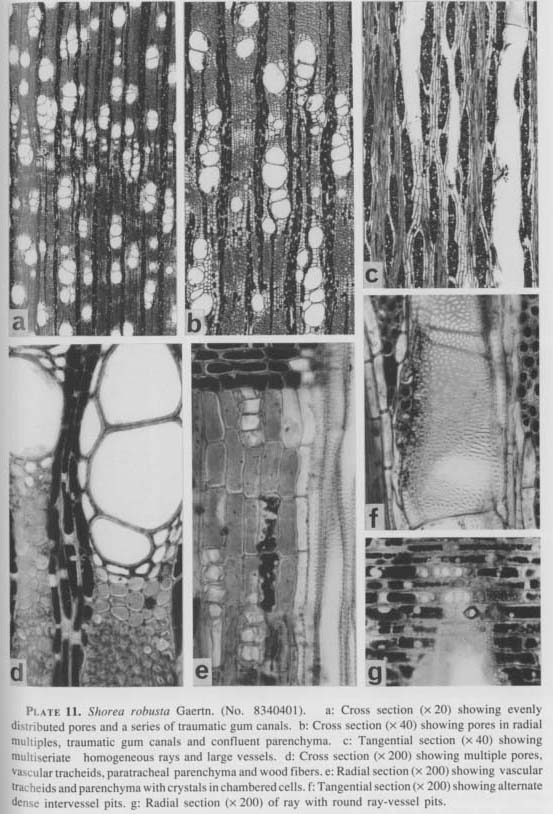
Big evergreen trees widely in the subtropical zone, often consisting pure forests.
SPECIMENS. No. 8340401*, d=40 cm, h=12 m, alt. 850 m: Gandaki Zone, Lamjung Distr., Simalchaur (800 m) - Bhotioder (650 m), H. Ohba et al., Aug. 11, 1983. No. 8840029, d=22 cm, h=12 m, alt. 1060 m: Koshi Zone, Dhankuta District, Gholi Kharka (1300 m) - Panche (1140 m), M. Suzuki et al., July 3, 1988. No. 8840064, d=28 cm, h=16 m, alt. 450 m: Koshi Zone, Sakuwasabha Distr., Khahare (390 m) - Tumlingtar (470 m), M. Suzuki et al., July 5, 1988.
DESCRIPTION. Wood diffuse porous. Growth rings indistinctly present but not annual rings. Traumatic gum canals often present in loose tangential lines, fairly smaller than pores and round in cross section, about 50 µm in diameter. Pores evenly distributed, 6-32/mm2, solitary and in radial multiples of 2-5, occasionally in clusters. Solitary pores round or oval in cross section, medium, 100-300 × 70-205 µm; walls 2-5 µm thick. Pith flecks absent.
Vessel elements short, 100-330 µm; end walls slightly oblique or nearly horizontal; perforation plates exclusively simple. Intervessel pits usually alternate, circular or horizontally elongated, 5-7 × 5-40 µm. Helical thickenings not observed. Tyloses present.
Non-perforated tracheal elements vascular tracheids and libriform fibers. Vascular tracheids polygonal or elongated in cross section, 30-40 µm in diameter, with circular bordered pits, 5-7 µm in diameter. Libriform fibers constitute ground mass of the wood, polygonal or rounded in cross section, 8-30 µm in diameter, thick-walled, 3-10 µm thick, and with very narrow cell lumens, non-septate; pits almost all simple or with minute borders, about 1 µm in diameter. Helical thickenings not observed.
Wood parenchyma paratracheal, aliform to confluent, abundant, in strands; cells 10-35 µm in radial diameter and 50-150 µm long. Crystals present, rhomboidal, in chambered cells.
Rays nearly homogeneous, uniseriate and multiseriate, low fusiform, 6-9 rays / mm length in tangential section. Uniseriate rays low and few, composed usually of procumbent cells, and rarely square cells intermingled, 1-11 cells (25-240 µm) tall. Multiseriate rays 2-6 cells (15-80 µm) wide and 200-1100 µm, rarely up to 1500 µm tall; multiseriate portions composed of procumbent cells; uniseriate wings composed usually of procumbent cells, rarely square cells intermingled, 1-2(-6) cells (15-50(-100) µm) tall. Procumbent or square cells 10-35, 5-25 × 30-150 µm. Ray-vessel pits large and rounded, 10-15 µm in diameter. Almost all ray cells contain black contents. Crystals absent.
AQUIFOLIACEAE (Akira TAKAHASHI and Mitsuo SUZUKI)
Ilex dipyrena Wall. [Plate 12]
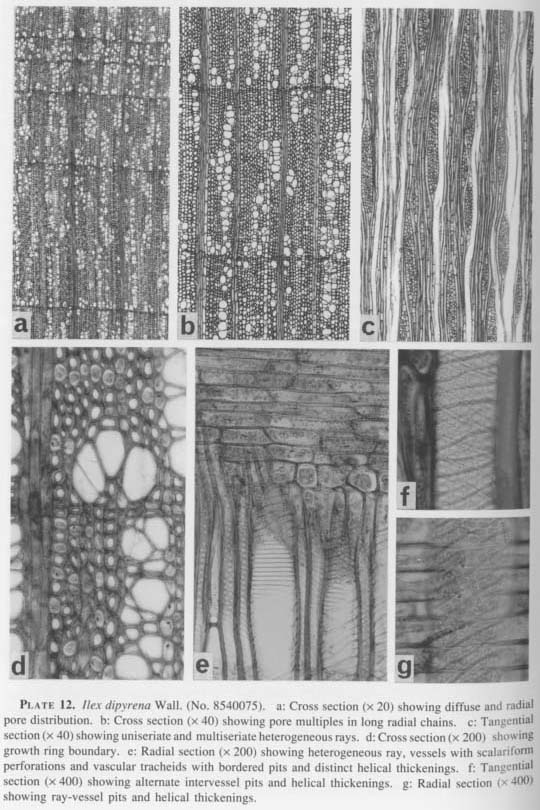
Evergreen trees in the temperate zone, consisting evergreen forests.
SPECIMENS. No. 8340078, alt. 2100 m: Gandaki Zone, Kaski Distr., Pothana (1970 m) - Tolka (1750 m), H. Ohba et al., July 8, 1983. No. 8340310, d=15 cm, h=8 m, alt. 2580 m: Gandaki Zone, Manang Distr., Chame (2630 m) - Thangjo (2580 m), H. Ohba et al., Aug. 6, 1983. No. 8540075*, d=70 cm, h=4.5 m, alt. 3020 m: Bagmati Zone, Rasuwa Distr., Langtang (3380 m) - Ghora Tabela (3000 m), M. Suzuki & S. Noshiro, May 29, 1985.
DESCRIPTION. Wood diffuse porous. Growth rings distinct, delineated by radially flattened fiber-tracheids, 0.3-2.0 mm wide. Pores evenly distributed, with a tendency to be radial porous with vascular tracheids, 94-140/mm2, mostly in radial multiples of 2-6 or more, and solitary or 4-6 in clusters. Solitary pores angular in outline, small, 40-80 × 30-60 µm, thin-walled, about 2 µm thick. Pith flecks absent.
Vessel elements long, 600-1200 µm; end walls oblique; perforation plates exclusively scalariform, with many, 20-45 bars. Intervessel pits usually opposite, sometimes scalariform to transitional, circular to rectangular, occasionally elongated in horizontal direction, 4-6 × 5-10 µm. Helical thickenings distinct.
Non-perforated tracheal elements vascular tracheids and fiber-tracheids. Vascular tracheids intermingled in the radial pore multiples, radially flattened in cross section, 10-20 and 20-30 µm in tangential and radial diameters, thin-walled, with numerous pits on the walls, circular bordered, 7-8 µm in diameter; helical thickenings distinct. Fiber-tracheids constitute ground mass of the wood, polygonal in cross section, 10-30 µm in diameter and with walls 3-5 µm thick, non-septate; pits sparse, distinctly bordered, circular, about 7 µm in diameter, with oblique slit-like apertures. Helical thickenings distinct.
Wood parenchyma predominantly apotracheal, diffuse and diffuse-in-aggregates, in strands; cells 15-30 µm in radial diameter and 90-150 µm long. Crystals absent.
Rays heterogeneous, uniseriate and multiseriate, 9-13 rays/mm length in tangential section. Uniseriate rays composed of upright and square cells, 1-12 cells (90-800 µm) tall. Multiseriate rays fusiform in outline, 2-6 cells (30-90 µm) wide and usually 300-1200 µm, up to 1600 µm tall; multiseriate portions composed mostly of procumbent cells, sometimes square cells intermingled; uniseriate wings composed of upright and square cells, 1-7 cells (30-430 µm) tall; occasionally, two multiseriate portions connect vertically by uniseriate upright and square cells. Upright and square cells 30-120, 15-30 × 20-60 µm; procumbent cells 15-35, 12-30 × 70-200 µm. Ray-vessel pits half-bordered, transitional to opposite, circular or horizontally elongated, 5-20 µm in horizontal diameter, often unilaterally compound. Crystals absent.
Ilex excelsa (Wall.) Hook. f. [Plate 13]

Small evergreen trees in the temperate zone.
SPECIMENS. No. 8540237, d=25 cm, h=4.5 m, alt. 1600 m: Bagmati Zone, Ramechap Distr., Bhandar (2300 m) - Kinja (1650 m) - Sete (2550 m), H. Ohba et al., Aug. 18, 1985. No. 8840415*, d=35 cm, h=9 m, alt. 2000 m: Gandaki Zone, Kaski Distr., Pothana (1970 m) - Tolka (1750 m), M. Suzuki et al., Aug. 20, 1988.
DESCRIPTION. Wood diffuse porous. Growth rings not so distinct, delineated by radially flattened fiber-tracheids, 0.2-1.4 mm wide. Pores evenly distributed, 46-62/mm2, mostly in radial multiples of 2-6, or solitary and occasionally in clusters. Solitary pores angular in outline, small, 35-115 × 50-90 µm, thin-walled, about 2 µm thick. Pith flecks absent.
Vessel elements long, 800-1600 vm; end walls oblique; perforation plates exclusively scalariform, with many, 15-40 bars. Intervessel pits usually opposite, sometimes scalariform to transitional, circular to rectangular or horizontally elongated, 5-6 × 7-10 µm. Helical thickenings present.
Fiber-tracheids constitute ground mass of the wood, polygonal in cross section, 10-45 µm in diameter and with walls 3-7 µm thick, non-septate; pits sparse, distinctly bordered, circular, 7-8 µm in diameter, with oblique slit-like apertures. Helical thickenings present.
Wood parenchyma predominantly apotracheal, diffuse and diffuse-in-aggregates, in strands; cells 15-40 µm in radial diameter and 110-200 µm long. Crystals absent.
Rays heterogeneous, uniseriate and large multiseriate, 7-12 rays/mm length in tangential section. Uniseriate rays tall and composed of upright and square cells, 1-13 cells (130-1600 µm) tall. Multiseriate rays very wide and very tall, (2-)4-10 cells ((30-)60-160 µm) wide and usually 600-2200 µm, up to 2850 µm tall; multiseriate portions composed of procumbent and square cells, often large marginal (square) cells sheath small (procumbent) cells of the central core; uniseriate wings composed of upright and square cells, 1-8 cells (80-810 µm) tall. Upright and square cells 40-200, 15-50 × 20-70 µm; procumbent cells 15-40, 10-25 × 70-220 µm. Ray-vessel pits half-bordered, scalariform to opposite, circular or horizontally elongated, 5-25 µm in horizontal diameter, often unilaterally compound. Crystals absent.
Ilex fragilis Hook. f. [Plate 14]
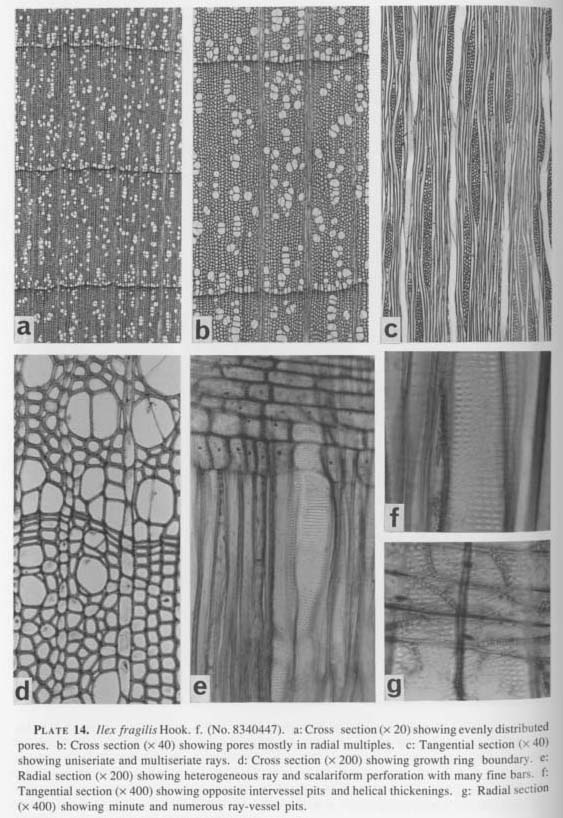
Deciduous trees in the temperate zone.
SPECIMENS. No. 8340097, d=7 cm, h=5 m, alt. 2150 m: Gandaki Zone, Kaski Distr., Ghandruk (1890 m) - Bhainsi Kharka (2460 m), H. Ohba et al., July 10, 1983. No. 8340121, d=150 cm, h=20 m, alt. 2580 m: Gandaki Zone, Kaski Distr., Bhainsi Kharka (2460 m) - Banthanti (2600 m), H. Ohba et al., July 11, 1983. No. 8340447*, d=30 cm, h=12 m, alt. 2560 m: Janakpur Zone, Dolakha Distr., Simigaon (1950 m) - Kyalche (2700 m), H. Ohba et al., Aug. 31, 1983. No. 8340463, d=16 cm, h= 6m, alt. 2650 m: Janakpur Zone, Dolakha Distr., Kyalche (2700 m)-Thandingma (3200 m), H. Ohba et al., Sept. 1, 1983. No. 8840123, d=35 cm, h=20 m, alt. 2030 m: Koshi Zone, Sakuwasabha Distr., Sakrate (1840 m) - Hurhure (2040 m) - Mude (2040 m), M. Suzuki et al., July 9, 1988. No. 8840167, d=45cm, h=16m, alt. 1940 m: Koshi Zone, Sakuwasabha Distr., Jaljare (1800 m) - Tashigaon (2160 m), M. Suzuki et al., July 12, 1988. No. 8840440, d=18 cm, h=5.5 m, alt. 2210 m: Gandaki Zone, Kaski Distr., Ghandruk (1890 m)-Bhainsi Kharka (2460m), M. Suzuki et al., Aug. 22, 1988.
DESCRIPTION. Wood diffuse porous. Growth rings distinct, delineated by radially flattened fiber-tracheids and a layer of pores at the initial lines, 0.9-2.3 mm wide. Pores arranged in a layer at initial lines of growth rings and evenly distributed throughout the growth rings, 57-80/mm2, mostly in radial multiples of 2-6, or solitary, and sometimes in clusters of 4-6. Solitary pores angular in outline, small, 40-75 × 35-75 µm, thin-walled, 1-2 µm thick. Pith flecks absent.
Vessel elements long, 750-1200 µm; end walls oblique; perforation plates exclusively scalariform, with many, 25-40 bars. Intervessel pits usually opposite, sometimes scalariform to transitional, circular to rectangular, or horizontally elongated, 3-4 × 5-10 µm. Helical thickenings present.
Fiber-tracheids constitute ground mass of the wood, polygonal in cross section, 12-30 µm in diameter, walls 2.5-4 µm thick, non-septate; pits sparse, circular bordered, 4-5 µm in diameter, with oblique slit-like apertures. Helical thickenings present.
Wood parenchyma predominantly apotracheal, diffuse and diffuse-in-aggregates, in strands; cells 12-20 µm in radial diameter and 120-220 µm long. Crystals absent.
Rays heterogeneous, uniseriate and multiseriate; 9-12 rays/mm length in tangential section. Uniseriate rays composed of upright and square cells, 1-10 cells (70-760 µm) tall. Multiseriate rays 2-5 cells (30-65 µm) wide and 330-1450 µm tall; multiseriate portions composed of procumbent cells; uniseriate wings composed of upright and square cells, 1-6 cells (40-500 µm) tall. Upright and square cells 30-130, 10-25 × 20-50 µm; procumbent cells 15-30,10-20 × 70-220 µm. Ray-vessel pits half-bordered; usually opposite; circular, 3-5 µm in diameter. Crystals absent.
Ilex intricata Hook. f. [Plate 15]
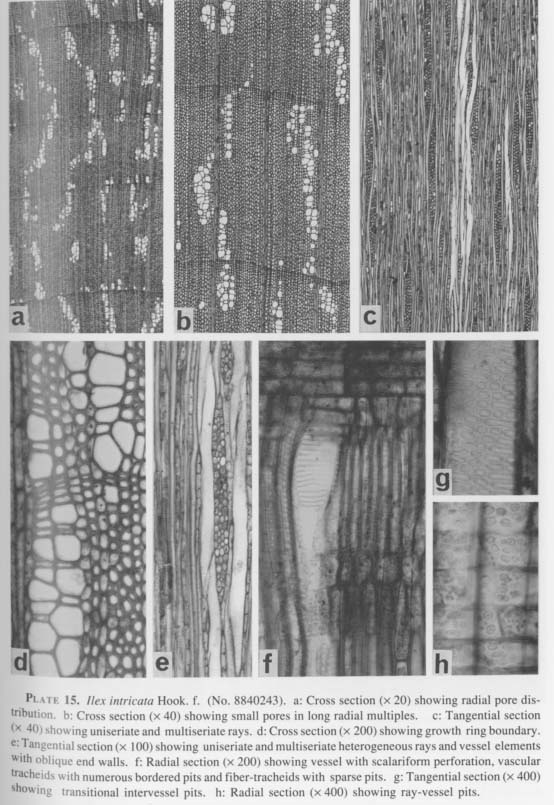
Evergreen shrubs in the upper temperate to subalpine zones.
SPECIMENS. No. 8840235, d=2.5 cm, h=0.5 m, alt. 3140 m; No. 8840241, d=6 cm, h=1.5 m, alt. 3210 m; No. 8840243*, d=10 cm, h=4.5 m, alt. 3220 m: Koshi Zone, Sakuwasabha Distr., Danda Kharka (2860 m) - Unshisa Kharka (3150 m) - Khongma (3500 m), M. Suzuki et al., July 15, 1988.
DESCRIPTION. Wood diffuse or radial porous. Growth rings distinct, delineated by
radially flattened fiber-tracheids; 0.2-2.1 mm wide. Pores arranged in radial or oblique pattern, somewhat dendritic, rather few, 50-60/mm2, mostly in radial multiples of 2-6 or more and sometimes solitary or in clusters of 4-8 or more. Solitary pores angular in outline, small, 40-75 × 30-55 µm, thin-walled, about 1 µm thick. Pith flecks absent.
Vessel elements long, 600-1100 µm; end walls oblique; perforation plates exclusively scalariform, with 15-25 bars. Intervessel pits transitional to opposite, rarely scalariform; circular to rectangular, or horizontally elongated, 5-6 × 6-25 µm. Helical thickenings distinct.
Non-perforated tracheal elements vascular tracheids and fiber-tracheids. Vascular tracheids arranged in radial or oblique pattern with vessels, radially flattened in cross section, 30-50 and 10-15 µm in tangential and radial diameters respectively; distinctly bordered circular pits abundant, 6-8 µm in diameter; helical thickenings distinct. Fiber-tracheids constituting ground mass of the wood, polygonal in cross section, 10-25 µm in diameter; walls 3-4 µm thick; pits sparse, distinctly bordered, circular 6-8 µm in diameter, with oblique slit-like apertures; non-septate; helical thickenings present.
Wood parenchyma predominantly apotracheal; diffuse and diffuse-in-aggregates, fairly abundant, in strands; cells 12-18 µm in radial diameter and 160-230 µm long. Crystals absent.
Rays heterogeneous, uniseriate and multiseriate, 13-18 rays/mm length in tangential section. Uniseriate rays composed of upright and square cells, tall, usually 1-10 cells (70-850 µm), up to 20 cells (1750 µm) tall. Multiseriate rays narrow, 2-4(-5) cells (20-60 µm) wide and 300-2150 µm tall; multiseriate portions composed of procumbent cells; uniseriate wings composed of upright and square cells, 1-13 cells (50-800 µm), up to 20 cells (900 µm) tall. Upright and square cells 40-180, 10-20 × 15-60 µm; procumbent cells 15-30, 10-25 and 50-150 µm. Ray-vessel pits half-bordered, transitional to opposite, circular or horizontally elongated, 3-12 µm in horizontal diameter, often unilaterally compound. Crystals absent.
HIPPOCASTANACEAE (Akira TAKAHASHI and Mitsuo SUZUKI)
Aesculus indica (Colebr. ex Cambess.) Hook. [Plate 16]
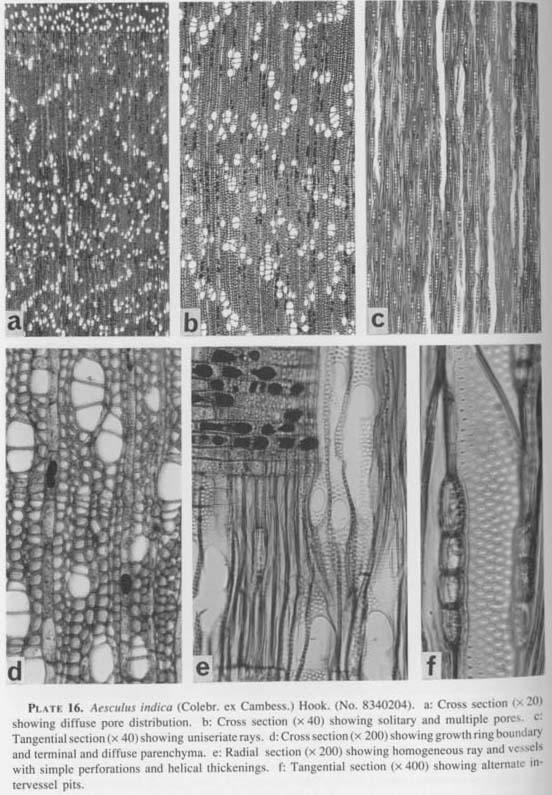
Fairly large deciduous trees in the temperate zone.
SPECIMENS. No. 8340204*, d=30 cm, h=10 m, alt. 2200 m: Dhawalagiri Zone, Mustang Distr., Ghansa (2030 m) - Lete (2470 m), H. Ohba et al., July 17, 1983. No. 8840540, d=8 cm, h=4.5 m, alt. 2230 m: Dhawalagiri Zone, Mustang Distr., Ghansa (2030 m) - Lete (2470 m), M. Suzuki et al., Aug. 28, 1988. No. 8840550, d=45 cm, h=5 m, alt. 2470 m: Dhawalagiri Zone, Mustang Distr., Dhampus (2480 m) - Boksi Khora (2510 m), M. Suzuki et al., Aug. 29, 1988.
DESCRIPTION. Wood diffuse porous. Growth rings faintly distinct, delineated by radially flattened fiber-tracheids and marginal parenchyma; 0.2-2.9 mm wide. Pores evenly distributed, with a tendency of dendritic pattern, numerous, 80-174/mm2, solitary and in radial multiples of 2-4(-6), occasionally in clusters of 4-6. Solitary pores angular in outline, minute to small, 30-80 × 25-55 µm, thin-walled, 1 µm thick. Pith flecks sometimes present.
Vessel elements short, 230-500 µm; end walls oblique; perforation plates exclusively simple. Intervessel pits alternate, dense, usually hexagonal or pentagonal, 6-7 × 7-10 µm. Helical thickenings present.
Fiber-tracheids constituting ground mass of the wood; polygonal in cross section, 8-25 µm in diameter; walls 1-3 µm thick; pits sparse, circular bordered, minute, 1-2 µm in diameter, with oblique slit-like apertures; non-septate. Helical thickenings not observed.
Wood parenchyma diffuse, paratracheal scanty and marginal, rather few, in strands; cells 15-25 µm in radial diameter and 70-190 µm long. Crystals absent.
Rays homogeneous and uniseriate; 13-17 rays/mm length in tangential section, loosely storied. Uniseriate rays composed of procumbent cells, 1-18 cells (30-420 µm) tall. Procumbent cells 15-30, 10-20 × 50-150 µm. Ray-vessel pits half-bordered, alternate, dense, circular, 3-4 µm in diameter. Crystals absent.
ACERACEAE (Kiyotsugu YODA and Mitsuo SUZUKI)
Acer campbellii Hook. f. et Thoms. [Plate 17]
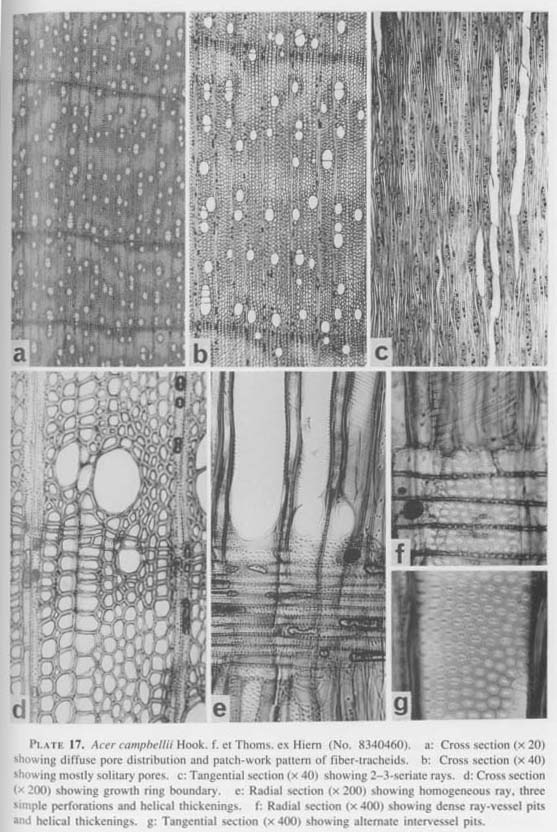
Large deciduous trees mainly in the upper temperate zone, consisting deciduous forests.
SPECIMENS. No. 8340109, d=18 cm, h=6 m, alt. 2300 m: Gandaki Zone, Kaski Distr., Ghandruk (1890 m) - Bhainsi Kharka (2460 m), H. Ohba et al,, July 10, 1983. No. 8340131, d=50 cm, h=20 m, alt. 2620 m: Gandaki Zone, Kaski Distr., Bhainsi Kharka (2460 m) - Banthanti (2600 m), H. Ohba et al., July 11, 1983. No. 8340460*, d=35 cm, h=10 m, alt. 2700 m: Janakpur Zone, Dolakha Distr., Simigaon (1950 m) - Kyalche (2700 m), H. Ohba et al., Aug. 31, 1983. No. 8540038, d=55 cm, h=11 m, alt. 2690 m; No. 8540043, d=40 cm, h=10 m, alt. 2800 m: Bagmati Zone, Rasuwa Distr., Lama Hotel (2480 m) - Ghora Tabela (3000 m), M. Suzuki & S. Noshiro, May 25, 1985. No. 8540156, d=25 cm, h=12 m, alt. 3190 m: Bagmati Zone, Ramechap Distr., Deorali (2700 m) - Serdingma (3400 m), H. Ohba et al., July 6, 1985. No. 8840222, d=60 cm, h=23 m, alt. 2910 m; No. 8840240, d=36 cm, h=12 m, alt. 3180 m: Koshi Zone, Sakuwasabha Distr., Danda Kharka (2860 m) - Unshisa Kharka (3150 m) - Khongma (3500 m), M, Suzuki et al., July 15, 1988. No. 8840460, d=40 cm, h=18 m, alt. 2800 m; No. 8840475, d=20 cm, h=9 m, alt. 3140 m: Gandaki Zone, Kaski Distr., Banthanti (2600 m) - Deorali (3050 m), M. Suzuki et al., Aug. 24, 1988.
DESCRIPTION. Wood diffuse porous with distinct patch-work pattern of fiber-tracheids. Growth rings distinct, delineated by radially flattened fiber-tracheids in latewood; narrow to wide, 0.2-4 mm. Pores evenly distributed, rather few, 30-38/mm2, mostly solitary, and sometimes in radial multiples of 2-4, circular or elliptical in outline, small, 35-100 (average 70) × 30-65 (average 50) µm, thin-walled.
Vessel elements short, 220-450 µm; end walls oblique; perforation plates exclusively simple. Intervessel pits alternate, dense; polygonal in outline, about 8 µm in diameter. Helical thickenings distinct. Tyloses or gum-like deposits absent.
Fiber-tracheids consist ground mass of the wood; form distinct patch-work pattern by alternation of mass of wider thin-walled elements (16-30 µm in diameter and about 1.7 µm thick) and that of narrower thick-walled elements (14-28 µm in diameter and about 2.8 µm thick); pits circular in outline and minute; non-septate; helical thickenings not observed.
Wood parenchyma scanty paratracheal, less abundant; cells about 20 µm in diameter. Crystals sometimes observed in series of vertically arranged square cells.
Rays homogeneous, narrow and low; all composed of procumbent cells, but uppermost and lowermost cells tend to be square. Uniseriate rays 60-240 µm tall. Multiseriate rays fusiform in outline, 2-3(-4) cells or 18-40 µm wide and 190-400 µm tall. Procumbent cells oval in tangential section, 10-22, 6-15 × 80-190 µm. Ray-vessel pits dense, circular or a little horizontally elongated, about 7 µm in diameter. Crystals absent.
Acer cappadocicum Gled. var. indicum (Pax) Rehder [Plate 18]
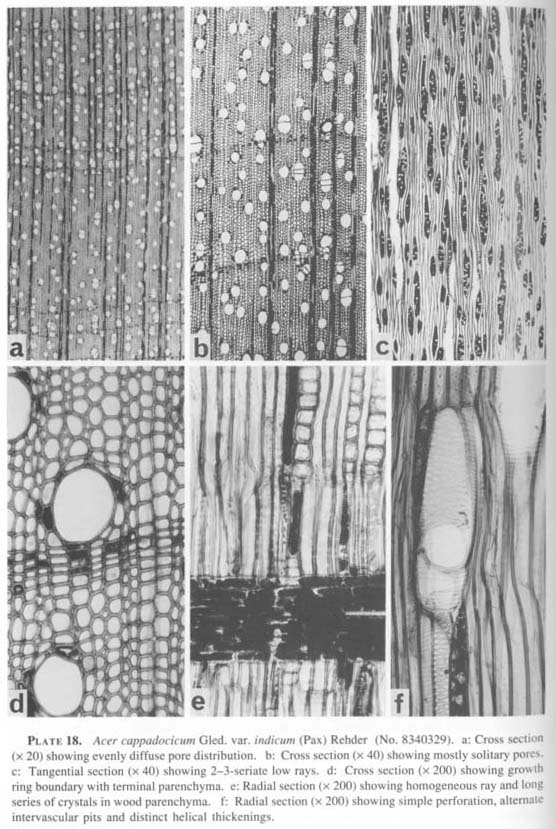
Deciduous trees in the temperate zone.
SPECIMEN. No. 8340329, d=80 cm, h=20 m, alt. 2400 m: Gandaki Zone, Manang Distr., Thangjo (2580 m) - Dhanagyang (2200 m), H. Ohba et al., Aug. 6, 1983.
DESCRIPTION. Wood diffuse porous. Patch-work pattern of fiber-tracheids not distinct. Growth rings rather indistinct, delineated by radially flattened fiber-tracheids; very narrow to narrow, 0.1-2 mm. Pores evenly distributed, rather few, 30-54/mm2, mostly solitary, sometimes in radial multiples of 2-4. Solitary pores circular to elliptical, a little angular, small, 45-100 (average 76) × 40-75 (average 59) µm, thin-walled.
Vessel elements short, 240-400 µm; end walls oblique; perforation plates exclusively simple. Intervessel pits alternate, polygonal in outline, about 9 µm in diameter. Helical thickenings distinct. Tyloses or gum-like deposits absent.
Fiber-tracheids constitute ground mass of the wood; triangular, square or polygonal in cross section, 15-20 µm in diameter, rather thick-walled (about 2.5 µm); pits circular with oblique to horizontally elongated apertures; non-septate; helical thickenings not observed.
Wood parenchyma diffuse or scanty paratracheal, rare; in strands; cells about 19 µm in diameter. Crystals abundantly present in series of vertically arranged swollen cells near the growth ring boundaries.
Rays homogeneous, narrow and low; all composed procumbent cells. Uniseriate rays 70-170 µm tall. Multiseriate rays distorted fusiform in outline, 2-4 cells or 27-55 µm wide and 160-640 µm tall. Procumbent cells oval in tangential section, 7-25, 8-20 × 55-180 µm. Ray-vessel pits dense, circular to elliptical with horizontal apertures, about 8 µm in diameter. Crystal not observed.
Acer caudatum Wall. [Plate 19]
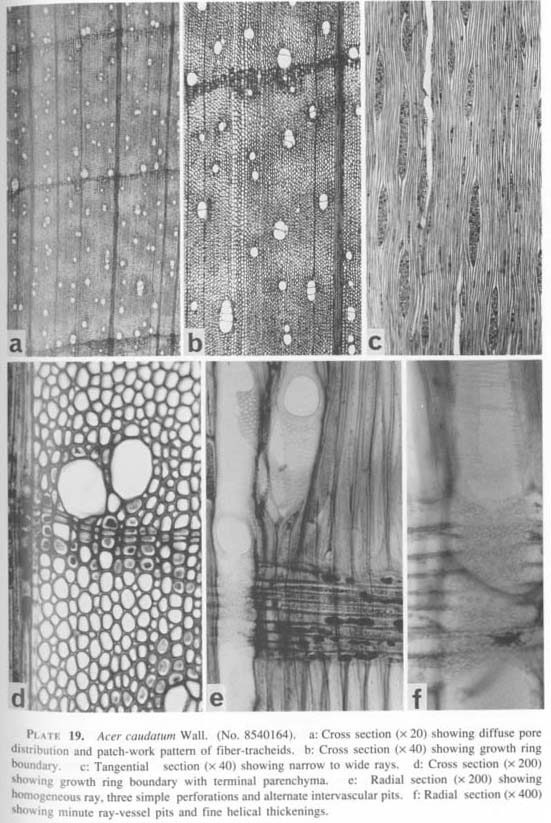
Deciduous trees in the temperate and subalpine zones.
SPECIMENS. No. 8340484, d=25 cm, h=8 m. alt. 3300 m: Janakpur Zone, Dolakha Distr., Thandingma (3200 m) Beding (3600 m), H. Ohba et al., Sept. 2, 1983. No. 8540108, d=35 cm, h=7 m, alt. 3470 m: Bagmati Zone, Rasuwa Distr., Syabru (2240 m) - Shin Gompa (3200 m), M. Suzuki & S. Noshiro, June 1, 1985. No. 8540164*, d=30 cm, h=9 m, alt. 3360 m: Bagmati Zone, Ramechap Distr., Serdingma (3400 m) - Dubi Kharka (3720 m), H. Ohba et al., July 7, 1985. No. 8540192, d=25 cm, h=8 m, alt. 3650 m: Bagmati Zone, Ramechap Distr., Neju (3650 m) - Choarma (2760 m), H. Ohba et al., Aug. 1, 1985. No. 8840228, d=35 cm, h=12 m, alt. 3060 m: Koshi Zone, Sakuwasabha Distr., Danda Kharka (2860 m) - Unshisa Kharka (3150 m) - Khongma (3500 m), M. Suzuki et al., July 15, 1988. No. 8840298, d=18 cm, h=5 m, alt. 3560 m: Koshi Zone, Sakuwasabha Distr., Around Yangri Kharka (3540 m), M. Suzuki et al., July 19, 1988.
DESCRIPTION. Wood diffuse porous with distinct patch-work pattern of fiber-tracheids. Growth rings distinct, delineated radially flattened fiber-tracheids; narrow to a little wide, 0.2-3.5 mm. Pores evenly distributed and less many, 18-26/mm2, solitary and in radial multiples of 2-4. Solitary pores circular or elliptical, slightly angular,small, 30-100 (average 59) × 30-75 (average 75) µm, thin-walled.
Vessel elements short, 240-380 µm; end walls oblique; perforation plates exclusively simple. Intervessel pits alternate, polygonal in outline, about 7 µm in diameter. Helical thickenings distinct. Tyloses or gum-like deposits absent.
Fiber-tracheids constitute ground mass of the wood and show distinct patch-work pattern, triangular, square or polygonal in cross section, 15-23 µm in diameter, rather thick-walled (about 2.5 µm); pits small, circular with oblique apertures; non-septate; helical thickenings not observed.
Wood parenchyma scanty paratracheal, in strands; cells about 22 µm in diameter. Crystals absent.
Rays homogeneous and composed of procumbent cells. Uniseriate rays 100-220 µm tall. Multiseriate rays distorted fusiform in outline, 2-6 cells or 22-55 µm wide and 180-840 µm tall. Procumbent cells oval in tangential section, 10-20,5-20 × 100-300 µm. Ray-vessel pits dense, circular, about 5 µm in diameter. Crystals absent.
Acer oblongum Wall. ex DC. [Plate 20]

Medium to large evergreen trees in the upper subtropical zone.
SPECIMENS. No. 8340094, d=40 cm, h=8m, alt. 1660 m: Gandaki Zone, Kaski Distr., Tolka (1750 m) - Landrung (1600 m), H. Ohba et al., July 9, 1983. No. 8340385, d=60 cm, h=10 m, alt. 1190 m: Gandaki Zone, Lamjung Distr., Jagat (1300 m) - Bahundanda (1300 m), H. Ohba et al., Aug. 9, 1983. No. 8840511*, d=70 cm, h=16 m, alt. 1930 m: Dhawalagiri Zone, Myagdi Distr., Khipang (1740 m) - Paudwar (1900 m), M. Suzuki et al., Aug. 26, 1988.
DESCRIPTION. Wood diffuse porous. Patch-work pattern of fiber-tracheids indistinct. Growth rings faintly distinct, delineated radially flattened fiber-tracheids narrow to fairly wide, 0.5-10 mm or more. Pores evenly distributed, rather sparse, 23-33/mm2, solitary and in radial multiples of 2-3(-5), rounded or elliptical, slightly angular, small, 45-115 (average 86) × 40-90 (average 70) µm, thin-walled.
Vessel elements short, 260-380 µm; end walls oblique; perforation plates exclusively simple. Intervessel pits dense, circular or polygonal with horizontally elongated small apertures, about 9 µm in diameter. Helical thickenings distinct. Tyloses or gum-like deposits absent.
Fiber-tracheids constitute ground mass of the wood,square or polygonal in cross section, 10-18 µm in diameter, thick-walled (about 3.2 µm); pits circular with minute slit-like apertures; non-septate; helical thickenings not observed.
Wood parenchyma paratracheal, about 26 µm in diameter in cross section; crystals abundant in series of vertical square cells all over the growth rings.
Rays homogeneous or nearly heterogeneous. Uniseriate ray cells and uppermost
or lowermost cells of multiseriate rays sometimes become large and tend to be square. Uniseriate rays 110-180 µm tall. Multiseriate rays distorted fusiform in outline, narrow and low, 2-4 cells or 20-48 µm wide and 300-540 µm tall. Procumbent cells oval in tangential section, 10-27, 8-20 × 28-190 µm. Ray-vessel pits dense, circular with horizontally elongated apertures, about 6 µm in diameter. Crystals absent.
Acer pectinatum Wall. ex Pax [Plate 21]

Large deciduous trees in the upper temperate and subalpine zones.
SPECIMENS. No. 8340152, d=40 cm, h=15 m, alt. 3130 m: Dhawalagiri Zone, Myagdi Distr., Deorali (3050m) - Ghorepani Deorali (2830 m), H. Ohba et al., July 12, 1983. No. 8340457, d=20 cm, h=7 m, alt. 2640 m: Janakpur Zone, Dolakha Distr., Simigaon (1950 m) - Kyalche (2700 m), H. Ohba et al., Aug. 31, 1983. No. 8540041, d=60 cm, h=9 m, alt. 2760 m: Bagmati Zone, Rasuwa Distr., Lama Hotel (2480 m) - Ghora Tabela (3000 m), M. Suzuki & S. Noshiro, May 25, 1985. No. 8540196, d=35 cm, h=12 m, alt. 3210 m: Bagmati Zone, Ramechap Distr., Neju (3650 m) - Choarma (2760 m), H. Ohba et al., Aug. 2, 1985. No. 8540260, d=25 cm, h=6 m, alt. 2640 m: Sagarmata Zone, Solukhunbu Distr., Sarkari Pati (3350 m) - Beni (2350 m), H. Ohba et al., Sept. 3, 1985. No. 8840208, d=32 cm, h=6 m, alt. 2550 m; No. 8840212, d=20 cm, h=10 m, alt. 2560 m: Koshi Zone, Sakuwasabha Distr., Bhainsi Kharka (2540 m) - Danda Kharka (2860 m), M. Suzuki et al., July 15, 1988. No. 8840239*, d=20 cm, h=7 m, alt. 3140 m: Koshi Zone, Sakuwasabha Distr., Danda Kharka (2860 m) - Unshisa Kharka (3150 m) - Khongma (3500 m), M. Suzuki et al., July 15, 1988. No. 8840454, d=18 cm, h=7.5 m, alt. 2700 m: Gandaki Zone, Kaski Distr., Banthanti (2600 m) - Deorali (3050 m), M. Suzuki et al., Aug. 24, 1988.
DESCRIPTION. Wood diffuse porous with distinct patch-work pattern of fiber-tra-cheids. Growth rings distinct, delineated by radially flattened fiber-tracheids, narrow to wide, 0.2-5 mm. Pores evenly distributed, sparse, 36-61/mm2, solitary or in radial multiples of 2-4(-7); solitary pores rounded or angular in outline, small, 35-80 (average 58) × 40-70 (average 53) µm, thin-walled.
Vessel elements short, 260-330 µm; end walls oblique; perforation plates exclusively simple. Intervessel pits alternate, dense, polygonal with nearly horizontal small apertures, about 8 µm in diameter. Helical thickenings distinct. Tyloses or gum-like deposits absent.
Fiber-tracheids constitute ground mass of the wood and show distinct patch-work pattern, polygonal in cross section, 8-17 µm in diameter, thin-walled (about 1.7 µm); pits small, circular with oblique slit-like apertures; non-septate; helical thickenings not observed.
Wood parenchyma scanty paratracheal, often present at growth ring boundary, in strands; cells 20 µm in diameter. Crystals absent.
Rays nearly homogeneous and composed of procumbent cells. Uniseriate rays 90-240 µm tall. Multiseriate rays slightly distorted fusiform in outline, 2-4 cells or 20-45 µm wide and 260-750 µm tall. Procumbent cells oval in tangential section, 10-30, 10-20 × 45-150 µm. Ray-vessel pits dense, circular or elliptical in outline with horizontal slit-like aperture, about 7 µm in diameter. Crystals absent.
Acer stachyophyllum Hiern [Plate 22]

Large deciduous trees in the upper temperate and subalpine zones.
SPECIMENS. No. 8340135, d=60 cm, h=15 m, alt. 2710 m: Gandaki Zone, Kaski Distr., Banthanti (2600 m) - Deorali (3050 m), H. Ohba et al., July 12, 1983. No. 8340316, d=30 cm, h=8 m, alt. 2620 m: Gandaki Zone, Manang Distr., Chame (2630 m) - Thangjo (2580 m), H. Ohba et al., Aug. 6, 1983. No. 8540040*, d=18 cm, h=7 m, alt. 2760 m: Bagmati Zone, Rasuwa Distr., Lama Hotel (2480 m) - Ghora Tabela (3000 m), M. Suzuki & S. Noshiro, May 25, 1985. No. 8540253, d=20 cm, h=5 m, alt. 2880 m: Sagarmata Zone, Solukhunbu Distr., Sarkari Pati (3350 m) - Beni (2350 m), H. Ohba et al., Sept. 3, 1985.
DESCRIPTION. Wood diffuse porous with faintly distinct patch-work pattern of fiber-tracheids. Growth rings distinct, delineated by radially flattened fiber-tracheids. Pores evenly distributed, sparse, 21-25/mm2, solitary or in radial multiples of 2-3. Solitary pores round or elliptical, slightly angular, small, 20-80 (average 60) × 25-75 (average 44) µm, thin-walled.
Vessel elements short, 170-370 µm long; end walls oblique; perforation plates exclusively simple. Intervessel pits dense, polygonal in outline, about 8 µm in diameter. Helical thickenings distinct. Tyloses or gum-like deposits absent.
Fiber-tracheids constitute ground mass of the wood, square or polygonal in cross section, 10-17 µm in diameter, rather thin-walled (about 1.7 µm); pits small, circular with oblique slit-like apertures; non-septate; helical thickenings not observed.
Wood parenchyma scanty paratracheal or vasicentric, in strands; cells 25 µm in diameter; crystals not observed.
Rays homogeneous and composed of procumbent cells. Uniseriate rays 90-240 µm tall. Multiseriate rays distorted fusiform in outline, 2-9 cells or 25-85 µm wide and 290-1300 µm tall. Procumbent cells oval in tangential section, 8-20, 5-15 × 75-280 µm. Ray-vessel pits dense, circular or polygonal with horizontal slit-like apertures, about 4 µm in diameter. Crystals absent.
Acer sterculiaceum Wall. [Plate 23]
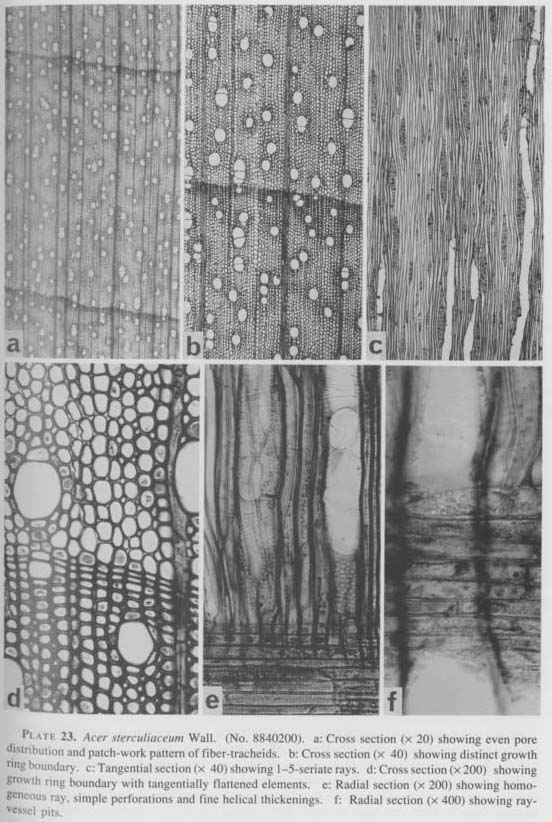
Deciduous trees in the upper temperate zone.
SPECIMENS. No. 8340116, d=25 cm, h=10 m, alt. 2500 m: Gandaki Zone, Kaski Distr., Bhainsi Kharka (2460 m) - Banthanti (2600 m), H. Ohba et al., July 11, 1983. No. 8340326, d=80 cm, h=20 m, alt. 2580 m; No. 8340327, d=40 cm, h=15 m, alt. 2580 m: Gandaki Zone, Manang Distr., Chame (2630 m) - Thangjo (2580 m), H. Ohba et al., Aug. 6, 1983. No. 8340449, d=70 cm, h=15 m, alt. 2560 m: Janakpur Zone, Dolakha Distr., Simigaon (1950 m) - Kyalche (2700 m), H. Ohba et al., Aug. 31, 1983. No. 8540024, d=50 cm, h=15 m, alt. 1820 m: Bagmati Zone, Rasuwa Distr., Syabru (2240 m) - Lama Hotel (2480 m), M. Suzuki & S. Noshiro, May 24, 1985. No. 8840200*, d=30 cm, h=12 m, alt. 2430 m: Koshi Zone, Sakuwasabha Distr., Uttise Kharka (2290 m) - Bhainsi Kharka (2540 m), M. Suzuki et al., July 14, 1988. No. 8840554, d=35 cm, h=4.5 m, alt. 2480 m: Dhawalagiri Zone, Mustang Distr., Dhampus (2480 m) - Boksi Khora (2510 m), M. Suzuki et al., Aug. 29, 1988.
DESCRIPTION. Wood diffuse porous with distinct patch-work pattern of fiber-tracheids. Growth rings distinct, delineated by radially flattened fiber-tracheids, narrow to a little wide, 0.2-3 mm. Pores evenly distributed, sparse, 24-29/mm2, mostly solitary, and sometimes in radial multiples of 2(-4). Solitary pores elliptical or rounded in outline, slightly angular, small, 50-105 (average 74) × 40-75 (average 55) µm, thin-walled.
Vessel elements short, 230-350 µm; end walls oblique; perforation plates exclusively simple. Intervessel pits alternate, dense, polygonal in outline, about 8 µm in diameter. Helical thickenings distinct. Tyloses or gum-like deposits absent.
Fiber-tracheids constitute ground mass of the wood and show distinct patch-work pattern, square or polygonal in cross section, 15-25 µm in diameter, thin-walled (about 1.3 µm); pits circular with oblique apertures; non-septate; helical thickenings not observed.
Wood parenchyma scanty paratracheal or vasicentric, in strands, about 24 µm in diameter in cross section. Crystals absent.
Rays homogeneous, mainly composed of procumbent cells, sometimes with abnormal upright cells. Uniseriate rays 70-200 µm tall. Multiseriate rays distorted fusiform in outline, 2-5 cells or 23-50 µm wide and 200-730 µm tall. Procumbent cells oval in tangential section, 8-22, 8-20 × 100-320 µm. Ray-vessel pits dense, circular or elliptical, about 5 µm in diameter. Crystals absent.
ROSACEAE (Shuichi NOSHIRO)
Prunus cerasoides D. Don [Plate 24]
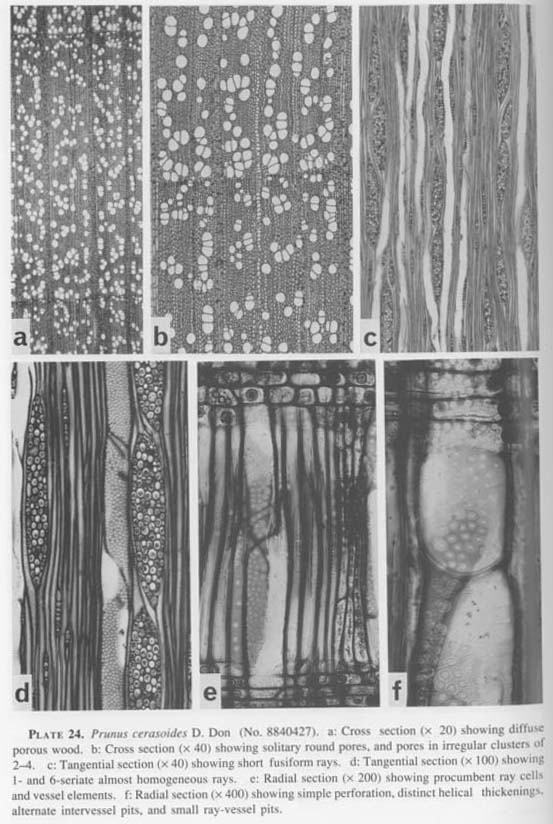
Deciduous trees in the lower temperate zone.
SPECIMENS. No. 8340071, alt. 2020 m: Gandaki Zone, Kaski Distr., Pothana (1970 m) - Tolka (1750 m), H. Ohba et al., July 8, 1983. No. 8340101, d=30 cm, h=8 m, alt. 2180 m: Gandaki Zone, Kaski Distr., Ghandruk (1890 m) - Bhainsi Kharka (2460 m), H. Ohba et al., July 10, 1983. No. 8340508, d=40 cm, h=20 m, alt. 2160 m: Janakpur Zone, Dolakha Distr., Phedi Kharka (2100 m) - Koplang (2100 m), H. Ohba et al., Sept. 14, 1983. No. 8540140, d=20 cm, h=8 m, alt. 2190 m: Bagmati Zone, Dolakha Distr., Jiri (1860 m) - Ratmate (2270 m) - Shivalaya (1800 m), H. Ohba et al., July 4, 1985. No. 8840427*, d=36 cm, h=18 m, alt. 1900 m: Gandaki Zone, Kaski Distr., Pothana (1970 m) - Tolka (1750 m), M. Suzuki et al., Aug. 20, 1988.
DESCRIPTION. Wood diffuse porous with numerous small round pores in irregular clusters; pore size reduces gently and irregularly from the beginning to the end of growth rings, but reduction little. Growth rings distinct; difference of pore diameter, flattened marginal fiber-tracheids, and marginal parenchyma define growth ring boundaries, usually wide, 1.6-5.5 mm. Pores many, 68-110/mm2, and evenly distributed, solitary, or in radial multiples, or in oblique or irregular clusters of various direction and shape; multiple or clusters consist of 2-6 pores or more; these pore, multiples or clusters occasionally line in radial files, tangential bands, or short irregular oblique bands. Solitary pores round in outline, slightly polygonal in latewood, small, 20-98 × 20-88 µm, with thin walls (about 2 µm).
Vessel elements medium in length, (180-) 280-690 µm; perforation plates exclusively simple. Intervessel pits on both radial and tangential walls, dense and alternate, round or polygonal, sometimes horizontally elongated, about 8 × 7-10 µm, with short slit-like apertures. Helical thickenings present on the entire inner walls.
Non-perforated tracheal elements abundant fiber-tracheids and few vascular tracheids, constitute ground mass of the wood, round or polygonal in outline, 10-28 µm in diameter, with thick walls (about 4 µm), non-septate. Bordered pits only on the radial walls of fiber-tracheids, and both on the radial and tangential wall of vascular tracheids, sparse in fiber-tracheids, and moderately spaced in vascular tracheids, small and round, 3-5 µm in diameter, with slit-like apertures. Fine helical thickenings on the inner walls of vascular tracheids, but not on those of fiber-tracheids.
Wood parenchyma marginal and diffuse. In transverse section, marginal parenchyma 1-3 cells in radial width, consisting of flatten oblong cells toward the inner and of polygonal cells toward the outer side of growth ring boundaries. Diffuse apotracheal parenchyma few and not conspicuous. Crystals absent.
Rays almost homogeneous, and mostly composed of procumbent cells, uniseriate and multiseriate; rays occupy 16.5-20.0 (average 18.3) % of horizontal length in tangential section. Uniseriate rays consist of procumbent to square cells, 2-13 cells and 50-310 µm tall. Multiseriate rays fusiform in tangential section, mostly made up of tall procumbent cells, but occasionally include short procumbent, square or short upright cells at the upper or lower ends, or at the margin of multiseriate bodies, 2-6 cells and 30-95 µm wide, and 145-860 µm tall. Procumbent cells round or slightly polygonal in tangential section, 12-28, 8-20 × 30-180 µm. Short procumbent, square or short upright cells elliptical or oblong in tangential section, 25-75, 12-27 × 25-75 µm. Crystals occasionally present in procumbent and square cells; rhomboidal ones 40-50 µm in diameter; druses 25 µm in diameter. Ray-vessel pits numerous, and alternate or opposite, round or horizontally elliptical with nearly horizontal slit-like apertures, occasionally unilaterally compound, about 3 µm in diameter.
Prunus cornuta (Wall. ex Royle) Steud. [Plate 25]
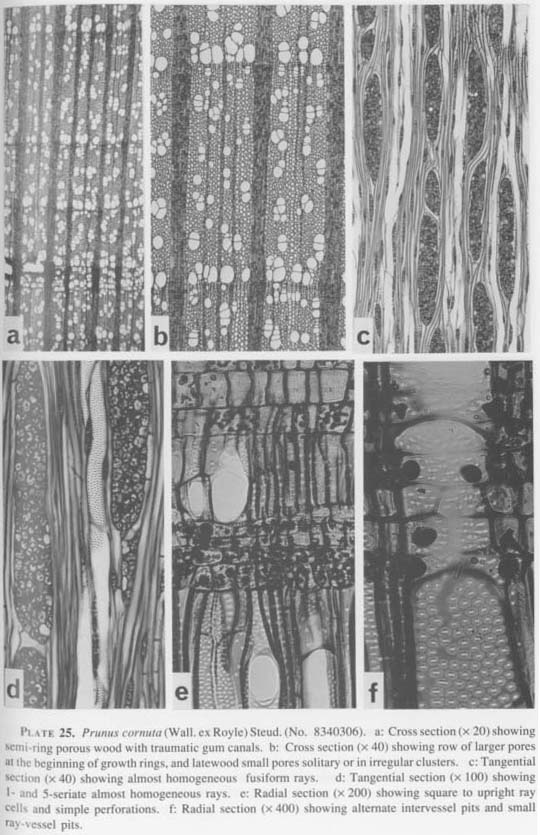
Deciduous trees in the upper temperate and subalpine zones.
SPECIMENS. No. 8340024, alt. 2640 m: Bagmati Zone, Kathmandu Valley, Mt. Pulchoke, H. Ohba et al., June 30, 1983. No. 8340306*, d=20 cm, h=10 m, alt. 2620 m: Gandaki Zone, Manang Distr., Chame (2630 m) - Thangjo (2580 m), H. Ohba et al., Aug. 6, 1983. No. 8340451, d=40 cm, h=15 m, alt. 2560 m: Janakpur Zone, Dolakha Distr., Simigaon (1950 m) - Kyalche (2700 m), H. Ohba et al., Aug. 31, 1983. No. 8540045, d=40 cm, h=5 m, alt. 3010 m: Bagmati Zone, Rasuwa Distr., Ghora Tabela (3000 m) - Langtang (3380 m), M. Suzuki & S. Noshiro, May 25, 1985.
DESCRIPTION. Wood diffuse porous or semi-ring porous with numerous small round pores in radial multiples and irregular clusters; pore size reduces gently from the beginning to the end of growth rings; occasionally one tangential row of large pores occurs at the beginning of growth ring boundaries. Sometimes traumatic gum ducts exist. Growth rings distinct; difference of pore diameter, flattened marginal vascular tracheids, and marginal parenchyma define growth ring boundaries, narrow to wide, 0.3-5.8 mm. Pores rather sparse or many, 40-99/mm2, and evenly distributed, solitary, in radial multiples, or in oblique or irregular clusters of various direction and shape; multiples or clusters consist of 2-6 pores or more. Solitary pores round or slightly polygonal in outline, small, 25-105(-135) × 20-95 µm, with thin walls (about 2 µm).
Vessel elements rather short, 240-620 µm; perforation plates exclusively simple. Intervessel pits on both radial and tangential walls, dense and alternate, round or polygonal, about 5-8 µm in vertical diameter and up to 15 µm in horizontal diameter, with short slit-like apertures. Helical thickenings present on the entire inner walls.
Non-perforated tracheal elements fiber-tracheids and vascular tracheids; vascular tracheids common at the end of growth rings. Both tracheids constitute ground mass of the wood, round or polygonal in cross section, 10-28 µm in diameter, with thick walls (about 4 µm), non-septate. Bordered pits only on the radial walls of fiber-tracheids, and both on the radial and tangential wall of vascular tracheids, sparse in fiber-tracheids, and moderately spaced in vascular tracheids, small and round, 3-5 µm in diameter, with slit-like apertures. Fine helical thickenings on the inner walls of vascular tracheids, but not on those of fiber-tracheids.
Wood parenchyma marginal and diffuse, occasionally in short irregular tangential bands of 1-3 cell wide, conspicuous at the outer margin of the initial large pore zones; strands consists mostly of 3-5 cells. In cross section, marginal parenchyma 1-3 cells in radial width, consisting of flatten oblong cells toward the inner and of polygonal cells toward the outer side of growth ring boundaries. Crystals absent.
Rays almost homogeneous, and mostly composed of procumbent cells, uniseriate and multiseriate; rays occupy 23.0-27.5 (average 25.5) % of horizontal length in tangential section. Uniseriate rays consist of procumbent and upright cells, 1-8 cells and 80-230 µm tall. Multiseriate rays wide fusiform in tangential section, mostly made up of procumbent cells, but occasionally of square or upright cells; 2-8 cells and (45-)75-155 µm wide, and 260-1080 (330-2220 in No. 8340451) µm tall. Procumbent cells round or slightly polygonal in tangential section, 10-30, 8-25 × 50-175 µm.; square or upright cells elliptical or oblong in tangential section, 25-80, 20-50 × 25-50 µm. Ray-vessel pits numerous and large, alternate or opposite, horizontally elliptical with round or nearly horizontally elliptical apertures, occasionally unilaterally compound, 5-8 µm in radial diameter.
Prunus napaulensis (Seringe) Steud. [Plate 26]

Evergreen trees in the temperate zone.
SPECIMENS. No. 8340117, d=70 cm, h=20 m, alt. 2500 m: Gandaki Zone, Kaski Distr., Bhainsi Kharka (2460 m) - Banthanti (2600 m), H. Ohba et al., July 11, 1983. No. 8840185*, d=35 cm, h=14 m, alt. 2190 m: Koshi Zone, Sakuwasabha Distr., Tashi Gaon (2160 m) - Uttise Kharka (2290 m), M. Suzuki et al., July 14, 1988.
DESCRIPTION. Wood diffuse porous with small round pores in irregular clusters; pore size reduces gently, but not evenly from the beginning to the end of growth rings; often tends to be semi-ring porous with one incomplete row of large pores at the beginning of growth rings. Growth rings distinct; difference of pore diameter, and flattened marginal fiber-tracheids define growth ring boundaries, usually wide, 0.8-3.7 mm. Pores sparse or many, 18-56/mm2, and evenly distributed, occasionally with a tendency to multiply toward growth ring boundaries, solitary, in radial multiples, or in irregular clusters of various direction and shape; multiples or clusters consist of 2-6 pores or more. Solitary pores round or slightly polygonal in outline, medium in size, 30-140 × 40-125 µm, with thin walls (about 2 µm).
Vessel elements rather short, 160-700 µm; perforation plates exclusively simple. Intervessel pits on both radial and tangential walls, dense and alternate, round, about 5 µm in diameter, with short slit-like apertures. Helical thickenings present on the entire inner walls.
Non-perforated tracheal elements abundant fiber-tracheids and few vascular tracheids; constituting ground mass of the wood, round or polygonal in cross section, 8-30 µm in diameter, with thick walls (about 3 µm). Bordered pits only on the radial walls in fiber-tracheids, and on both radial and tangential walls in vascular tracheids, sparse in fiber-tracheids and moderately spaced in vascular tracheids, small and round, 3-4 µm in diameter, with slit-like apertures. Fine helical thickenings on the inner walls of vascular tracheids, but not on those of fiber-tracheids.
Wood parenchyma diffuse or diffuse-in-aggregates, and conspicuous throughout the growth rings, occasionally in short irregular bands of 1-3 cells wide formed at the outer margin of initial large pores; strands consist mostly of 2-5(-8) cells. Crystals absent.
Rays heterogeneous, but mostly composed of procumbent cells, uniseriate and multiseriate; rays occupy 13.3-20.0 (average 17.4) % of horizontal length in tangential section. Uniseriate rays consist of procumbent and upright cells, 2-13 cells and 60-390 µm or more tall. Multiseriate rays wide and tall fusiform in tangential section, mostly made up of procumbent cells, but occasionally of square or upright cells at the upper or lower ends or at the margin of multiseriate bodies, occasionally with uniseriate wings of 2-3 cells tall, 2-7 cells and 40-160 µm wide, and 350-1680 (-1940) µm tall. Procumbent cells round or slightly polygonal in tangential section, 5-35, 5-30 × 50-150 µm; square or upright cells elliptical or oblong in tangential section, 25-100, 15-40 × 25-65 µm. Ray-vessel pits numerous and alternate, round or horizontally elliptical with nearly horizontal slit-like or elliptical apertures, about 4 µm in diameter, occasionally unilaterally compound. Crystals absent.
Prunus persica (Linn.) Batsch. [Plate 27]
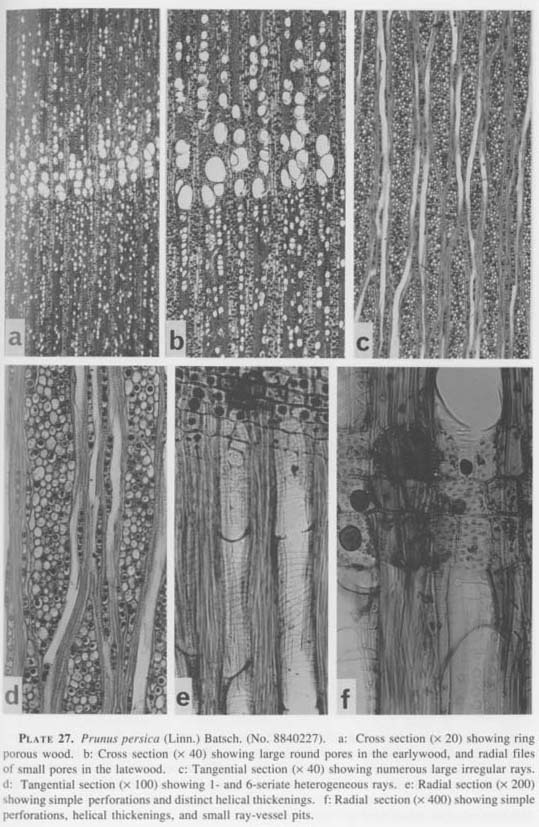
Deciduous trees cultivated or often wild in dry areas of Nepal.
SPECIMEN. No. 8340227, d=30 cm, h=6 m, alt. 2740 m: Dhawalagiri Zone, Mustang Distr., Jomson (2750 m) - Kagbeni (2800 m), H. Ohba et al., July 21, 1983.
DESCRIPTION. Wood ring porous; large round pores in 2-4 rows occur at the beginning of growth rings, small pores evenly distributed in latewood; pore size reduced abruptly from the initial large pores. Growth rings distinct; ring porosity, flattened marginal fiber-tracheids, and marginal vascular tracheids define growth ring boundaries, very wide, 9.5 mm. Pores sparse to many in latewood, 49-146/mm2, and evenly distributed, occasionally with a tendency to multiply toward growth ring boundaries; solitary, or in radial multiples of 2-3 pores, often in radial files. Solitary pores round in outline, slightly polygonal, medium in earlywood, 52-175 × 40-135 µm, and small in latewood, 20-70 × 12-50 µm, thin-walled (about 2 µm).
Vessel elements short, 260-420 µm; perforation plates exclusively simple. Intervessel pits observed on both radial and tangential walls, dense and alternate, round or polygonal, about 6 µm in diameter, with short slit-like apertures. Helical thickenings distinct on the entire inner walls.
Non-perforated tracheal elements fiber-tracheids and vascular tracheids; constitute ground mass of the wood; vascular tracheids at the end of growth rings forming initial
pore zones with large pores; polygonal in cross section, 8-20 µm in diameter, with thick walls (about 4 µm). Bordered pits only on the radial walls in fiber-tracheids, and on both the radial and tangential walls in vascular tracheids, sparse in fibertracheids, and moderately spaced in vascular tracheids, small and round, 3-5 µm in diameter, with slit-like apertures. Fine helical thickenings on the inner walls of vascular tracheids, but not on those of fiber-tracheids.
Wood parenchyma diffuse, abundant in initial large pore zones, but scattered in latewood. Crystals absent.
Rays heterogeneous, uniseriate and multiseriate; rays occupy as much as 46.0-52.5 (average 49.5) % of horizontal length in tangential section. Uniseriate rays consist of square to procumbent, and upright cells, 4-13(-25) cells and 90-330(-660) µm or more tall. Multiseriate rays tall and wide fusiform, consist of irregular cells in tangential section, made up of procumbent, square, and upright cells, with uniseriate wings 1-6 cells tall, 3-7 cells and (25-)45-135 µm wide, and (190-)500-2610 µm tall. Procumbent cells round or slightly polygonal in tangential section, 12-25, 10-25 × 25-90 µm; square or upright cells elliptical or oblong in tangential section, 15-45, 15-30 × 15-30 µm. Ray-vessel pits numerous and alternate, round or horizontally elliptical with slit-like or elliptical apertures, about 4 µm in diameter. Crystals absent.
Prunus rufa Hook. f. [Plate 28]
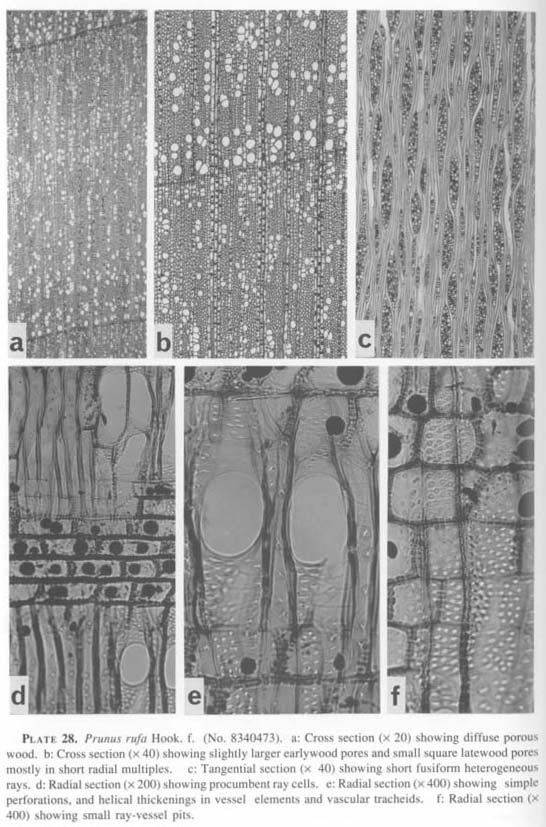
Small deciduous trees in the subalpine zone.
SPECIMENS. No. 8340149, d=15 cm, h=6 m, alt. 3080 m: Dhawalagiri Zone, Myagdi Distr., Deorali (3050 m) - Ghorepani Deorali (2830 m), H. Ohba et al., July 12, 1983. No. 8340473*, d=15cm,h=3 m.alt. 3150m: Janakpur Zone, Dolakha Distr., Kyalche (2700 m)-Thandingma (3200 m), H. Ohba et al., Sept. 1, 1983. No. 8340482, d=20 cm, h=4 m, alt. 3240 m: Janakpur Zone, Dolakha Distr., Thandingma (3200 m) - Beding (3600 m), H. Ohba et al., Sept. 2, 1983. No. 8540110, d=50 cm, h=6 m, alt. 3610 m: Bagmati Zone, Rasuwa Distr., Syabru (2240 m) - Shin Gompa (3200 m), M. Suzuki & S. Noshiro, June 1, 1985. No. 8540162, d=35 cm, h=10 m, alt. 3360 m: Bagmati Zone, Ramechap Distr., Serdingma (3400 m) - Dubi Kharka (3720 m), H.Ohba et al., July 7, 1985. No. 8540195, d=30 cm, h=4.5 m, alt. 3270 m: Bagmati Zone, Ramechap Distr., Neju (3650 m) - Choarma (2760 m), H. Ohba et al., Aug. 2, 1985. No. 8840286, d=22 cm, h=7 m, alt. 3470 m: Koshi Zone, Sakuwasabha Distr., Phemathang Kharka (3380 m) - Yangri Kharka (3540 m), M. Suzuki et al., July 18, 1988.
DESCRIPTION. Wood diffuse porous with numerous small round pores in irregular clusters; pore size reduced gradually from beginning to end of growth rings; often tending to be semi-ring porous with large pores gathering at the beginning of growth rings in 1-3 rows. Pith flecks occasionally observed. Growth rings distinct; difference in pore diameter, and flattened marginal fiber-tracheids define growth ring boundaries, usually wide, 0.2-4.3 mm. Pores sparse to abundant, 38-147/mm2, and evenly distributed except at beginning of growth rings, solitary or in radial multiples, occasionally in irregular clusters; multiples or clusters consist of two to many pores; in some individuals, pores in radial files. Solitary pores round or slightly polygonal in outline, small, 35-90 × 38-70 µm in earlywood and 12-68 × 12-60 µm in latewood, thin-walled (about 2 µm).
Vessel elements short, 200-450 µm; perforation plates exclusively simple. Intervessel pits on both radial and tangential walls, dense and alternate, round or polygonal, about 6 µm in diameter, with short slit-like apertures. Helical thickenings present on the entire inner walls.
Non-perforated tracheal elements fiber-tracheids and vascular tracheids. Fibertracheids constitute ground mass of the wood; vascular tracheids conspicuous at growth ring boundaries; polygonal in cross section, 8-30 µm in diameter, with thick walls (about 3 µm). Bordered pits only on the radial walls in fiber-tracheids, and on both radial and tangential walls in vascular tracheids, sparse in fiber-tracheids and moderately spaced in vascular tracheids, small and round, 2-5 µm in diameter, with slit-like apertures. Helical thickenings on the inner walls of vascular tracheids, but not on those of fiber-tracheids.
Wood parenchyma diffuse, abundant in the initial large pore bands, and few in latewood. Crystals absent.
Rays heterogeneous, uniseriate and multiseriate; rays occupy 32.0-34.0 (average 33.0) % of horizontal length in tangential section. Uniseriate rays consist of square to procumbent and upright cells, 1-15 cells and 50-550 µm or more tall. Multiseriate rays small and low fusiform in tangential section, mostly made up of procumbent cells with square or upright cells at the upper or lower ends of multiseriate bodies, often with uniseriate wings 2-8 cells tall, 2-6 cells and 35-115 µm wide, and 210- 780(-950) µm tall. Procumbent cells round or slightly polygonal in tangential section, 10-30, 10-25 x 55-120 v×m; square or upright cells elliptical or oblong in tangential section, 25-70, 12-30 × 25-55 µm. Ray-vessel pits numerous and alternate, round or horizontally elliptical with slit-like or elliptical apertures, occasionally unilaterally compound, about 4 µm in diameter. Crystals absent.
Pyracantha crenulata (D. Don) M. Roemer [Plate 29]
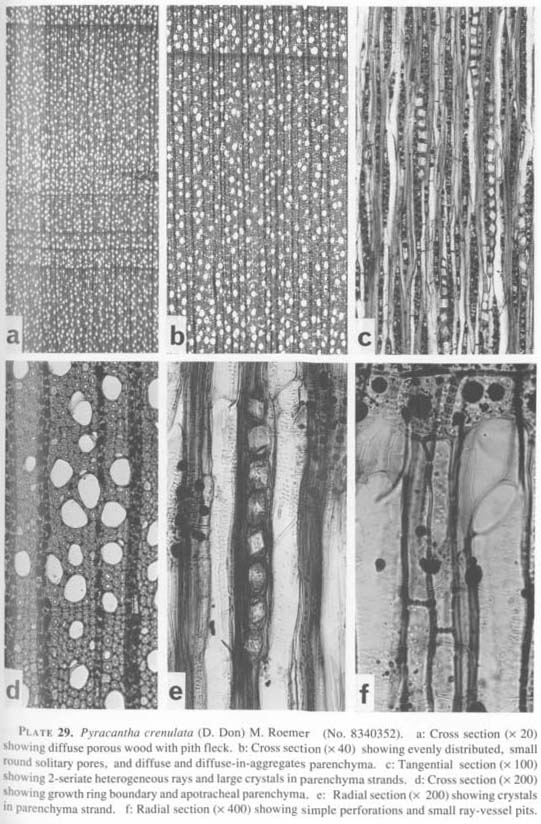
Evergreen shrubs in open places in the temperate zone.
SPECIMENS. No. 8340191, d=5 cm, h=2 m, alt. 1610 m: Dhawalagiri Zone, Myagdi Distr., Dana (1550 m) - Ghansa (2030 m), H. Ohba et al., July 16, 1983. No. 8340352*, d=20 cm, h=4 m, alt. 1710 m: Gandaki Zone, Lamjung Distr., Dharapani (1800 m) - Tal (1620 m), H. Ohba et al., Aug. 7, 1983. No. 8340431, d=8 cm, h=2.5 m, alt. 1100 m; Janakpur Zone, Dolakha Distr., Totlabari (1100 m) - Simigaon (1950 m), H. Ohba et al., Aug. 29, 1983. No. 8540131, d=4 cm, h=2 m, alt. 2030 m: Bagmati Zone, Dolakha Distr., Jiri (1860 m) -Ratmate (2270 m) - Shivalaya (1800 m), H. Ohba et al., July 4, 1985. No. 8540217, d=20 cm, h=4m, alt. 2160 m: Bagmati Zone, Ramechap Distr., Choarma (2760 m) - Kyama (2600 m), H. Ohba et al., Aug. 3, 1985.
DESCRIPTION. Wood diffuse porous with evenly distributed, numerous minute pores; pore size reduced at the ends of growth rings. Pith flecks occur occasionally. Growth rings distinct; difference in pore diameter and flattened marginal fiber-tracheids define growth ring boundaries, usually narrow, 0.1-2.3 mm. False growth rings sometimes formed. Pores numerous, 179-320/mm2, and evenly distributed, exclusively solitary, round in outline, slightly polygonal in latewood, minute, 15-55 × 10- 48 µm, thin-walled (about 2 µm).
Vessel elements short, 220-540 µm; perforation plates mostly simple, and occa
sionally reticulate. Intervessel pits few, round, about 4 µm in diameter, with slit-like or elliptical apertures. Helical thickenings run nearly horizontally on the entire inner walls.
Non-perforated tracheal elements fiber-tracheids; fiber-tracheids constitute ground mass of the wood, round or polygonal in cross section, 8-18 µm in diameter, with thick walls (about 3 µm). Bordered pits on both the radial and tangential walls, sparse, small and round, about 4-5 µm in diameter, with slit-like apertures. Fine helical thickenings occasionally observed on the inner walls.
Wood parenchyma abundant, diffuse and diffuse-in-aggregates; strands consist mostly of 4 cells; numerous simple pits present on both the radial and tangential walls. Vessel-parenchyma pits half-bordered, round or horizontally elongated with slit-like or elliptic apertures, about 4 × 4-6 µm. Large rhomboidal crystals occasionally present in parenchyma strands; crystals 15-33 µm in length; crystalliferous parenchyma strands 1-15 cells and 40-480 µm tall.
Rays heterogeneous, narrow and low, uniseriate and 2-seriate. Uniseriate rays consist of square and upright cells, 65-280(-520) µm tall. Biseriate rays slender fusiform in tangential section, 200-560(-880) µm tall, made up of procumbent cells in biseriate bodies, and of square or upright cells at uniseriate wings of 1-5 cells tall. Procumbent cells round or slightly polygonal in tangential section, 5-20, 5-12 × 55-210 µm; square or upright cells elliptical or oblong in tangential section, 30-65, 8-15 × 22-38 µm. Ray-vessel pits numerous and alternate, round or horizontally elliptical with wide elliptical apertures, about 4 × 4-8 µm. Crystals absent.
Pyrus pashia Buch.-Ham. e× D. Don [Plate 30]
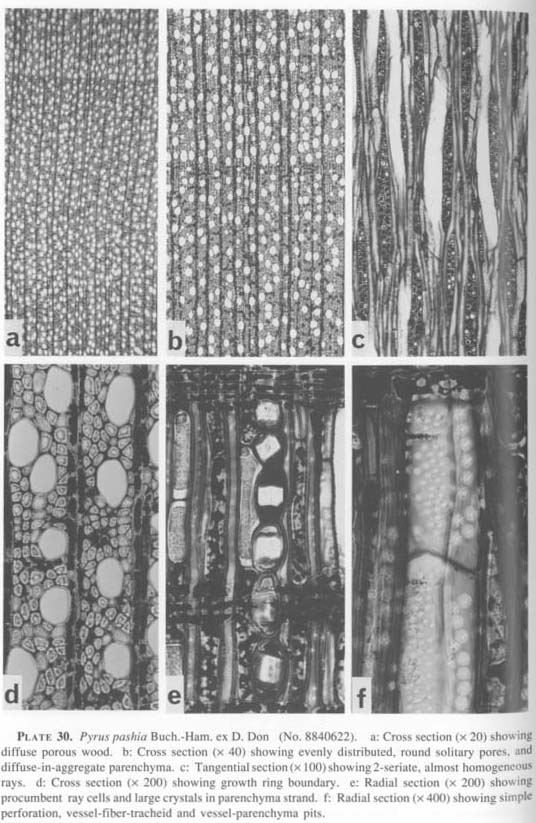
Deciduous trees throughout the temperate zone.
SPECIMENS. No. 8540033, d=40 cm, h=8 m, alt. 2420 m: Bagmati Zone, Rasuwa Distr., Syabru (2240 m) - Lama Hotel (2480 m), M. Suzuki & S. Noshiro, May 24, 1985. No. 8540093, d=35 cm, h=8 m, alt. 2390 m: Bagmati Zone, Rasuwa Distr., Lama Hotel (2480 m) - Syabru (2240 m), M. Suzuki & S. Noshiro, May 30, 1985. No. 8540138, d=12 cm, h=3 m, alt. 2380 m: Bagmati Zone, Dolakha Distr., Jiri (1860 m) - Ratmate (2270 m) - Shivalaya (1800 m), H. Ohba et al., July 4, 1985. No. 8840622*, d=20 cm, h=5 m, alt. 1950 m: Bagmati Zone, Kathmandu Valley, Shiwapuri Danda, M. Suzuki et al., Sept. 13, 1988.
DESCRIPTION. Wood diffuse porous with evenly distributed, numerous small pores; pore size slightly reduced toward the growth ring boundaries. Growth rings distinct, and the boundaries rather wavy; difference in pore diameter and flattened marginal fiber-tracheids define growth ring boundaries, usually wide, 0.4-4.5 mm. Pores abundant, 111-142/mm2, and evenly distributed, exclusively solitary, round or slightly polygonal in outline, small, 30-80 × 22-60 µm, with thin walls (about 2 µm).
Vessel elements short, 320-680 µm; perforation plates mostly simple with occasional reticulate perforations. Intervessel pits rare, sparse and alternate, round, about 6-8 µm in diameter, with short slit-like apertures. Helical thickenings not observed.
Non-perforated tracheal elements fiber-tracheids; fiber-tracheids constitute ground mass of the wood, round or polygonal in cross section, 5-25 µm in diameter, with thick walls (about 4 µm). Bordered pits on both the radial and tangential walls, moderately spaced, small and round with slit-like oblique apertures; 4-8 µm in diameter. Helical thickenings not observed.
Wood parenchyma abundant and diffuse-in-aggregates; strands consist mostly of 4-5 cells; numerous simple pits present on the radial walls. Vessel-parenchyma pits half-bordered, round or horizontally elongated with slit-like or elliptic apertures, about 4 × 4-6 µm. Large rhomboidal crystals occasionally present in parenchyma strands; crystals 18-38 µm in length; crystalliferous parenchyma strands 1-15 cells and 70-580 µm long.
Rays almost homogeneous, mostly composed of procumbent cells, with rare square or upright cells at the upper or lower ends of multiseriate bodies, narrow and short, uniseriate and 2-(3-)seriate. Uniseriate rays 1-16 cells and (25-)55-270 µm or more tall. Biseriate rays slender fusiform in tangential section, often with uniseriate wings of 2-7 cells tall, 20-35 µm wide and 105-460(-530) µm tall. Procumbent cells round or slightly polygonal in tangential section, 7-28,7-18 × 38-102 µm; square or upright cells elliptical or oblong in tangential section, 7-28, 35-75 × 25-50 µm. Ray-vessel pits numerous and alternate, round or horizontally elliptical with nearly horizontal slit-like apertures, about 4 µm in diameter.
Rosa brunonii Lindl. [Plate 31]

An evergreen vine in the temperate zone.
SPECIMENS. No. 8340165, d=6 cm, h=8 m, alt. 2630 m: Dhawalagiri Zone, Myagdi Distr., Ghorepani Deorali (2830 m) - Shika (2010 m), H. Ohba., July 14, 1983, No. 8340338, d=15 cm, h=10 m, alt. 2010 m: Gandaki Zone, Manang Distr., Dhanagyang (2200 m) - Dharapani (1800 m), H. Ohba et al., Aug. 7, 1983. No. 8540130, d=4 cm, h=3 m, alt. 2030 m; No. 8540136, d=12 cm, h=4 m, alt. 1980 m: Bagmati Zone, Dolakha Distr., Jiri (1860m)- Ratmate (2270 m) - Shivalaya (1800 m), H. Ohba et al., July 4, 1985. No. 8840084, d=5 cm, alt. 1910 m: Koshi Zone, Sakuwasabha Distr., Bhotebas (1800 m) - Gogane (1870 m) - Chichila (1870 m), M. Suzuki et al., July 8,1988. No. 8840107*, d=6 cm, alt. 1910m: Koshi Zone, Sakuwasabha Distr., Chichila (1870 m) - Kuwapani (1940 m), M. Suzuki et al., July 9, 1988. No. 8840417, d=2.5 cm, alt. 2060 m: Gandaki Zone, Kaski Distr., Pothana (1970 m) - Tolka (1750 m), M. Suzuki et al., Aug. 20, 1988.
DESCRIPTION. Wood semi-ring porous with larger round pores in 1-3 rows in earlywood and small pores in latewood, or ring porous with one row of distinctly large pores at the beginning of growth rings. Growth rings distinct; ring porosity and flattened marginal fiber-tracheids define growth ring boundaries, usually narrow to slightly wide, 0.3-2.7 mm, and sometimes more than 10 mm. Pores abundant and evenly distributed in latewood, occasionally in tangential rows, solitary, or in clusters of 2-3; pore size gradually reduced toward the end of growth rings, but quite irregularly. Solitary pores round or slightly polygonal, medium to large in earlywood, 135-255 (200-325 in No.8340338) × 105-200 (130-265) µm, and small in latewood, 105-200 × 18-120 µm, with thin walls (about 2-3 µm).
Vessel elements short, 210-480 µm; perforation plates exclusively simple. Intervessel pits on both radial and tangential walls, dense and alternate, round in outline, about 6-8 µm in diameter, with slit-like apertures. Helical thickenings present on the
entire inner walls of latewood vessel elements. Gum occasionally deposited in vessel lumen.
Non-perforated tracheal elements fiber-tracheids; fiber-tracheids constitute ground mass of the wood, round or polygonal in cross section, 5-25 µm in diameter, with thick walls (about 4 µm). Bordered pits on both the radial and tangential walls, rather dense, small and round, about 6 µm in diameter, with slit-like apertures. Helical thickenings occasionally on the inner walls.
Wood parenchyma vasicentric in earlywood, and diffuse and diffuse-in-aggregates; strands consist mostly of 2-4 cells. Vasicentric parenchyma little in some individuals. Apotracheal parenchyma conspicuous in latewood. Crystals absent.
Rays heterogeneous, uniseriate and multiseriate. Uniseriate rays consist of upright cells, 1-14 (-21) cells and 60-1000 µm or more long. Multiseriate rays very large and tall, 65-410µm wide, and 0.8-14.7 or more than 16 mm tall, consist of procumbent, square and upright cells; cell size varies irregularly in tangential section. Procumbent cells round in tangential section, 10-30, 8-22 × 40-140 µm; square or upright cells elliptical or oblong in tangential section, 30-75,10-22 × 12-38 µm. Rhomboidal crystals occasionally present, 10-20 µm in length. Ray-vessel pits numerous and alternate, round or horizontally elliptical, 6-12 µm in horizontal diameter, with nearly horizontal slit-like apertures, occasionally unilaterally compound.
Rosa macrophylla Lindl. [Plate 32]
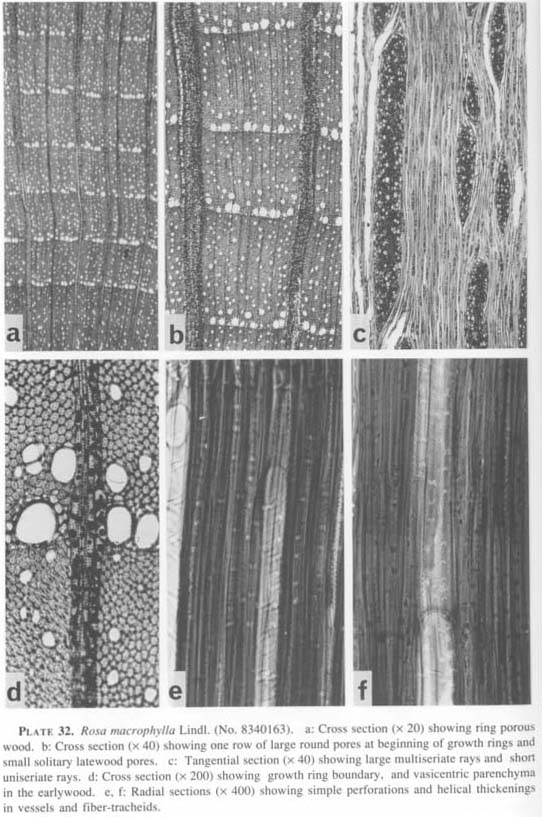
Deciduous shrubs in the upper temperate and subalpine zones.
SPECIMENS. No. 8340163*, d=4 cm, h=4 m, alt. 2680 m: Dhawalagiri Zone, Myagdi Distr., Ghorepani Deorali (2830 m) - Shika (2010 m), H. Ohba et al., July 14, 1983. No. 8340273, d=12 cm, h=5 m, alt. 3200 m: Gandaki Zone, Manang Distr., Humde (3320 m) - Pisang (3130 m), H. Ohba et al., Aug. 4, 1983. No. 8540074, d=7 cm, h=4 m, alt. 3030 m: Bagmati Zone, Rasuwa Distr., Langtang (3380 m) - Ghora Tabela (3000 m), M. Suzuki & S. Noshiro, May 29, 1985. No. 8840549, d=2.5 cm, h=3 m, alt. 2470 m: Dhawalagiri Zone, Mustang Distr., Dhampus (2480 m) - Boksi Khora (2510 m), M. Suzuki et al., Aug. 29, 1988. No. 8840578, d=4 cm, h=2 m, alt. 3590 m: Dhawalagiri Zone, Mustang Distr.,Yak Kharka (3850 m) - Marpha (2650 m), M. Suzuki et al., Sept. 1, 1988.
DESCRIPTION. Wood ring porous, occasionally semi-ring porous, with 1(-2) row of large, slightly polygonal pores at the beginning of growth rings and small solitary pores in latewood; reduction in pore size from early- to latewood usually abrupt, but gradual in some individuals. Growth rings distinct; ring porosity and flattened marginal fiber-tracheids define growth ring boundaries; usually narrow, 0.2-3.0 mm. Pores few and evenly distributed in latewood, mostly solitary, occasionally in clusters of 2-3; pore size in latewood gradually reduced toward the end of growth rings. Solitary pores slightly polygonal in outline, small in earlywood, 40-82 × 25-75 µm, minute in latewood, 10-55 × 10-45 µm, with thin walls (about 1.5 µm).
Vessel elements short, 130-390 µm; perforation plates almost simple, occasionally reticulate in narrow vessel elements. Intervessel pits on both radial and tangential walls, rather dense and alternate, round or horizontally elongated, about 6 × 6-8 µm, with short slit-like apertures. Helical thickenings present on the entire inner walls.
Non-perforated tracheal elements fiber-tracheids. Fiber-tracheids constitute ground mass of the wood; polygonal in cross section, 5-25 µm in diameter, with thick walls (about 4 µm). Bordered pits on both the radial and tangential walls; moderately spaced, small and round, about 5 µm in diameter, with slit-like apertures. Helical thickenings on the inner walls.
Wood parenchyma vasicentric in earlywood, diffuse or occasionally diffuse-in-aggregates in latewood; some growth rings unilaterally paratracheal at the beginning of latewood; strands consist mostly of 2-4 cells. Vasicentric parenchyma conspicuous around earlywood large pores. Apotracheal parenchyma usually not conspicuous. Crystals absent.
Rays heterogeneous, uniseriate and multiseriate. Uniseriate rays consist of square and upright cells, 1-9 cells and 50-400 µm or more tall. Multiseriate rays very wide and fairly tall fusiform, 6-12 cells and (25-)60-185 µm wide, and (120-) 340-3240 µm tall, made up of procumbent, square, and upright cells, which quite variable in size in tangential section, occasionally with uniseriate wings 2 cells tall. Procumbent cells round in tangential section, 8-25, 5-22 × 45-95 µm; square or upright cells elliptical or oblong in tangential section, 25-50, 8-15 × 18-70 µm. Crystals absent. Ray-vessel pits numerous and alternate, round or elliptical, about 4 µm in diameter, with nearly slit-like apertures.
Rosa sericea Lindl. [Plate 33]
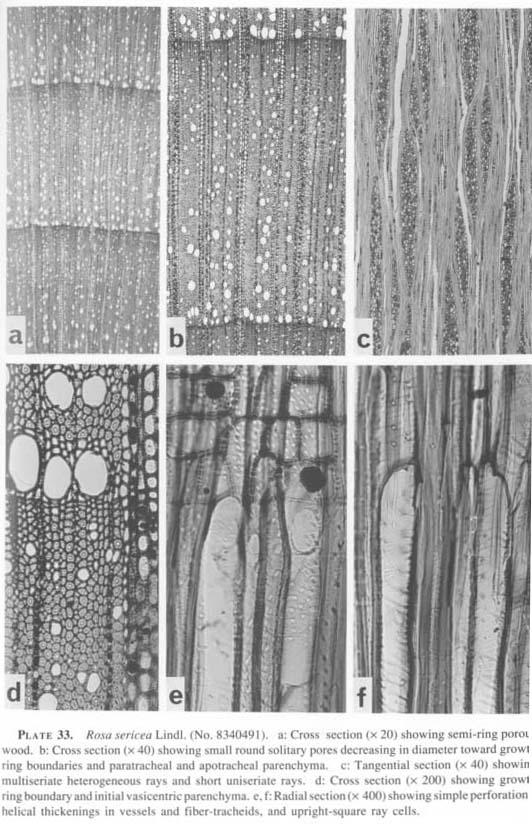
Deciduous shrubs in the upper temperate and subalpine zones.
SPECIMENS. No. 8340224, d=5 cm, h=3 m, alt. 2600 m: Dhawalagiri Zone, Mustang Distr., Tuckche (2590 m) - Jomson (2750 m), H. Ohba et al., July 19, 1983. No. 8340257, d=6 cm, h=4 m, alt. 3330 m: Gandaki Zone, Manang Distr., Humde (3320 m) - Pisang (3130 m), H. Ohba et al., Aug. 4, 1983. No. 8340459, d=7 cm, h=4 m, alt. 2700 m: Janakpur Zone, Dolakha Distr., Simigaon (1950 m) - Kyalche (2700 m), H. Ohba et al., Aug. 31, 1983. No. 8340491*, d=8 cm, h=4 m, alt. 3650 m: Janakpur Zone, Dolakha Distr., Beding (3600 m) - Na (4050 m), H. Ohba et al., Sept. 4, 1983. No. 8540048, d=6 cm, alt. 3030 m: Bagmati Zone, Rasuwa Distr., Ghora Tabela (3000 m) - Langtang (3380 m), M. Suzuki & S. Noshiro, May 25, 1985. No. 8540176, d=6 cm, h=3 m, alt. 3680 m: Bagmati Zone, Ramechap Distr., Koshing Kharka (4000 m) - Thare Og (4150 m), H. Ohba et al., July 22, 1985. No. 8840251, d=6 cm, h=l m, alt. 3500 m: Koshi Zone, Sakuwasabha Distr., Around Khongma (3500 m), M. Suzuki et al., July 16, 1988.
DESCRIPTION. Wood semi-ring porous with large, slightly polygonal pores in 1-3 rows in the earlywood and small solitary pores in latewood; reduction in pore size from earlywood usually gradual, but occasionally abrupt and presenting a ring porous appearance. Growth rings distinct; ring porosity and flattened marginal fiber-tracheids define growth ring boundaries; usually narrow, 0.7-2.3 mm. Pores moderate in the latewood, and evenly distributed, solitary or in clusters of 2-3; pore size gradually reduced toward the end of growth rings. Solitary pores slightly polygonal, small in the earlywood, 50-90 × 38-70 µm, and minute in latewood, 12-50(-80) × 5-40(- 55) µm, with thin walls (about 1.5 µm).
Vessel elements short, 150-400 µm; perforation plates almost all simple, occasionally scalariform with 1-4 bars in very narrow vessel elements. Intervessel pits on both radial and tangential walls, rather dense and alternate, round or elliptical,
about 5 × 5-12 µm, with elliptical apertures. Helical thickenings present on the entire inner walls.
Non-perforated tracheal elements fiber-tracheids, constituting ground mass of the wood, round or polygonal in cross section, 5-20 µm in diameter, with thick walls (about 4 µm). Bordered pits on both the radial and tangential walls; moderately spaced, small and round, 3-5 µm in diameter, with slit-like apertures. Helical thickenings present on the inner walls.
Wood parenchyma vasicentric in earlywood, unilaterally paratracheal in the early part of latewood, and diffuse; strands consist mostly of 2-4 cells. Vasicentric and unilaterally paratracheal parenchyma conspicuous. Crystals absent.
Rays heterogeneous, uniseriate and multiseriate. Uniseriate rays consist of square and upright cells, 1-11 (-23) cells and 60-570(-770) µm or more tall. Multiseriate rays wide and tall fusiform, 3-9 cells and 40-130 µm wide, and (260-)440-6840 µm tall, made up of procumbent, and square or upright cells, which irregular in size in tangential section, often with uniseriate wings of 2-14 cells tall. Procumbent cells round or slightly polygonal in tangential section, 10-22, 8-15 × 38-75 µm; square or upright cells elliptical or oblong in tangential section, 22-100, 6-20 ×18-38 µm. Crystals absent. Ray-vessel pits numerous and alternate, round or horizontally elliptical, 5-8 µm in horizontal diameter, with elliptical apertures.
Sorbaria tomentosa (Lindl.) Rehder [Plate 34]
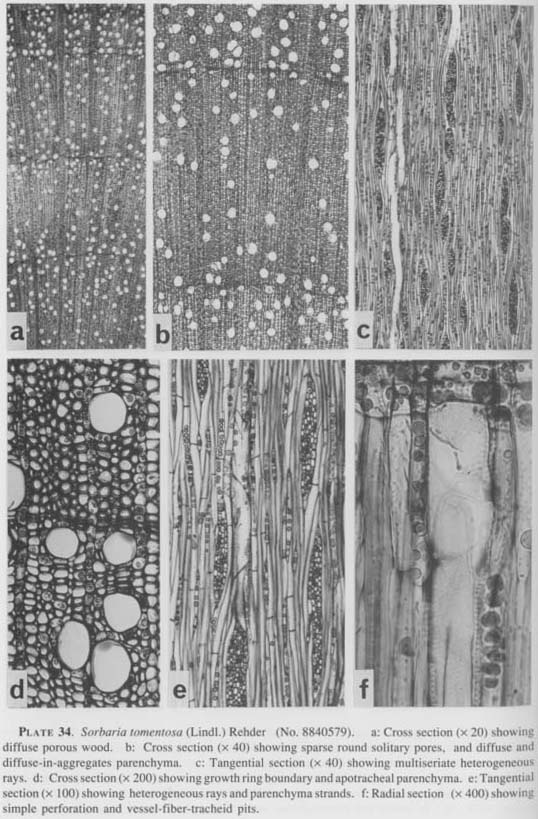
Deciduous shrubs in open places of the upper temperate zone.
SPECIMEN. No. 8840579, d=2.5 cm, h=2 m, alt. 2650 m: Dhawalagiri Zone, Mustang Distr., Yak Kharka (3850 m) - Marpha (2650 m) Tuckche (2590 m), M. Suzuki et al., Sept. 1, 1988.
DESCRIPTION. Wood diffuse porous with sparse round pores. Growth rings distinct; flattened marginal fiber-tracheids, marginal parenchyma define growth ring boundaries; usually narrow, 0.6-1.6 mm. Pores sparse, 30-70/mm2, and evenly distributed throughout the growth rings or fewer in the middle, almost solitary, occasionally in clusters of 2-3; reduction in pore size obscure. Solitary pores round in outline, slightly polygonal, small, 15-75 × 22-90 µm, with thin walls (about 2 µm).
Vessel elements short, 140-410 µm; perforation plates mostly simple, occasionally reticulate or scalariform, Intervessel pits on both radial and tangential walls, but not common, rather dense and alternate round, about 4 µm in diameter, with short slitlike apertures. Helical thickenings not observed. Gum occasionally deposited in vessel lumen.
Non-perforated tracheal elements fiber-tracheids,constituting ground mass of the wood, round or polygonal in cross section, 8-22 µm in diameter, with thick walls (about 2.5 µm). Bordered pits on both the radial and tangential walls, sparse, small and round, about 4 µm in diameter, with slit-like apertures. Helical thickenings not observed.
Wood parenchyma abundant, diffuse or diffuse-in-aggregates, round or slightly polygonal in cross section, 5-25 µm in diameter; strands consist of 2-3(-5) cells. Vessel-parenchyma pits dense and round, about 3 µm in diameter, with slit-like horizontal apertures. Crystals absent.
Rays heterogeneous and small, uniseriate and multiseriate. Uniseriate rays consist of square and upright cells, 1-10 cells and 50-290 µm or more tall. Multiseriate rays small, fusiform, 2-6 cells and 20-70 µm wide, and 100-550(-670) µm tall, consisting mostly of procumbent cells, and of 1(-4) square or upright cell at the upper or lower end of multiseriate bodies, occasionally with uniseriate wings of 2-4 cells tall. Procumbent cells round or vertically elliptical in tangential section, 6-18, 3-12 × 40-88 µm; square or upright cells elliptical or oblong in tangential section, 23-75, 12- 15 × 20-38 µm. Crystals absent. Ray-vessel pits numerous and alternate, round or slightly elliptical, about 3 µm in diameter, with slit-like apertures.
Sorbus cuspidata (Spach) Hedlund [Plate 35]
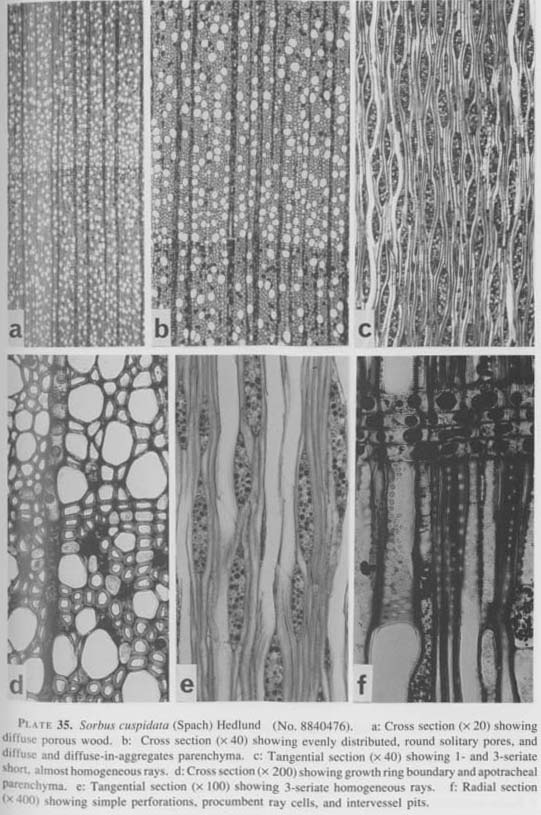
Deciduous trees in the upper temperate and subalpine zones.
SPECIMENS. No. 8340124, d=70 cm, h=20 m, alt. 2520 m: Gandaki Zone, Kaski Distr., Bhainsi Kharka (2460 m) - Banthanti (2600 m), H. Ohba et al., July 11, 1983. No. 8340477, d=30 cm, h=8 m, alt. 3150 m: Janakpur Zone, Dolakha Distr., Kyalche (2700 m) - Thandingma (3200 m), H. Ohba et al., Sept. 1, 1983. No, 8840476*, d=60 cm, h=19 m, alt. 3140 m: Gandaki Zone, Kaski Distr., Banthanti (2600 m) - Deorali (3050 m), M. Suzuki et al., Aug. 24, 1988.
DESCRIPTION. Wood diffuse porous with many small pores. Growth rings distinct; flattened marginal fiber-tracheids and difference in pore diameter define growth ring boundaries, usually narrow, 0.3-2.6 mm. Pith flecks observed occasionally. Pores abundant, 89-163 (206-244 at the beginning of some growth rings) /mm2, decreasing in density toward growth ring boundaries, solitary, or in clusters of 2-3(-5); pore size reduced abruptly at end of growth rings. Solitary pores slightly polygonal in outline, small, 15-80 × 25-65 µm, with thin walls (about 1.5 m).
Vessel elements medium, 340-610 µm; perforation plates usually simple, but often reticulate. Intervessel pits on both radial and tangential walls, rather dense and alternate round, about 6-8 µm in diameter, with short slit-like apertures. Helical thickenings present on the entire inner walls.
Non-perforated tracheal elements fiber-tracheids, constituting ground mass of the wood, round or polygonal in cross section, 6-30 µm in diameter, with thick walls (about 4 µm). Bordered pits on both the radial and tangential walls, sparse, small and round, about 4-6 µm in diameter, with slit-like apertures. Pine helical thickenings on the inner walls.
Wood parenchyma diffuse or diffuse-in-aggregates, conspicuous, especially in latewood; strands consist mostly of 4-8 cells. Rhomboidal crystals occasionally present, 20-30 µm in length.
Rays almost homogeneous, small, fusiform, uniseriate and 2-4-seriate. Uniseriate rays consist usually of a procumbent cell, and square to upright cells, 1-11 cells and (45-)90-235 µm. Multiseriate rays small, fusiform, 18-60 µm wide, and 120-460 µm tall, consisting mostly of procumbent cells, occasionally with procumbent to square cells at the upper or lower ends, occasionally with uniseriate wings 2-8 cells tall. Procumbent cells round or slightly polygonal in tangential section, 8-25, 6-20 × 40- 240 µm; square or upright cells elliptical or oblong in tangential section, 38-63, 12
× 30-45 µm. Crystals absent. Ray-vessel pits numerous and alternate, round, about 4 µm in diameter, with slit-like apertures.
Sorbus foliolosa (Wall.) Spach [Plate 36]
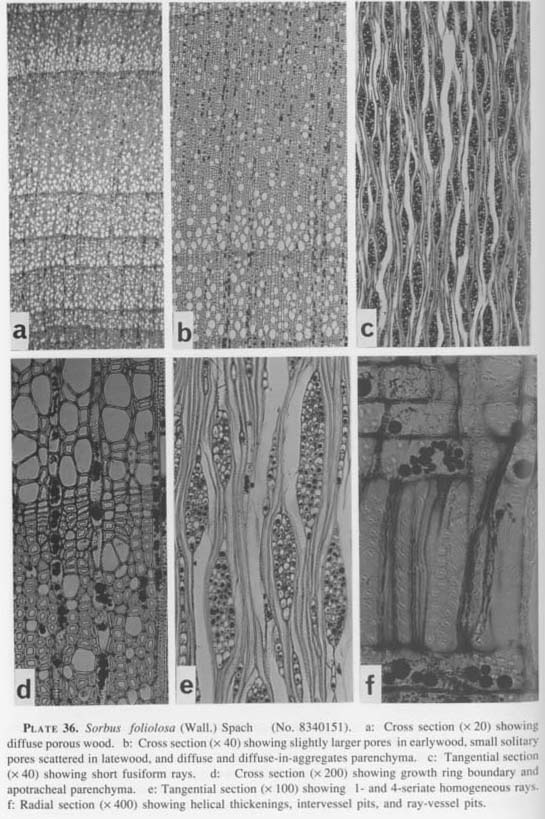
Deciduous trees in the subalpine zone.
SPECIMEN. No. 8340151, d=30 cm, h=12 m, alt. 3130 m: Dhawalagiri Zone, Myagdi Distr., Deorali (3050 m) - Ghorepani Deorali (2830 m), H. Ohba et al., July 12, 1983.
DESCRIPTION. Wood diffuse porous with many small pores, tending to be semiring porous with numerous, slightly larger pores at the beginning of growth rings. Growth rings distinct; difference in pore diameter and flattened marginal fibertracheids define growth ring boundaries; usually narrow, 0.3-1.5 mm. Pores abundant, numerous (270-350/mm2) in earlywood and sparse (55-70/mm2) in the latewood; pore density reduced rather abruptly from early- to latewood; solitary, or in clusters of 2-3 or more; pore size gradually reduced toward the end of growth rings. Solitary pores slightly polygonal in outline, small, 12-75 × 12-55 µm, withthin walls (about 2 µm).
Vessel elements short, 230-500 µm; perforation plates almost simple, occasionally reticulate. Intervessel pits on both radial and tangential walls, rather dense and alternate, round or horizontally elongated, about 6-8 × 6-15 µm, with short slit-like apertures. Helical thickenings on the entire inner walls.
Non-perforated tracheal elements fiber-tracheids, constituting ground mass of the wood, round or polygonal in cross section, 4-20 µm in diameter, with thick walls (about 4 µm). Bordered pits on both the radial and tangential walls, sparse, small and round, about 6 µm in diameter, with slit-like apertures. Fine helical thickenings on the entire inner walls.
Wood parenchyma diffuse and diffuse-in-aggregates, conspicuous, especially in latewood; strands consist mostly of 4 cells. Crystals absent.
Rays almost homogeneous, small, fusiform, uniseriate and 2-4-seriate. Uniseriate rays consist usually of procumbent cells with some square cells, 1-14 cells and 40- 340 µm tall. Multiseriate rays small, fusiform, 25-75 µm wide, and 165-560(-640) µm tall, consisting mostly of procumbent cells, occasionally with procumbent to square cells in the upper or lower ends, often with uniseriate wings of 2-6 cells tall. Procumbent cells round or slightly polygonal in tangential section, 7-38, 7-18 × 30- 160 µm; square or upright cells elliptical or oblong in tangential section, 28-50, 12- 23 × 15-45 µm. Crystals absent. Ray-vessel pits numerous and alternate, round, about 4 µm in diameter, with long horizontal slit-like apertures.
Sorbus kurzii (Watt ex Prain) Schneid. [Plate 37]
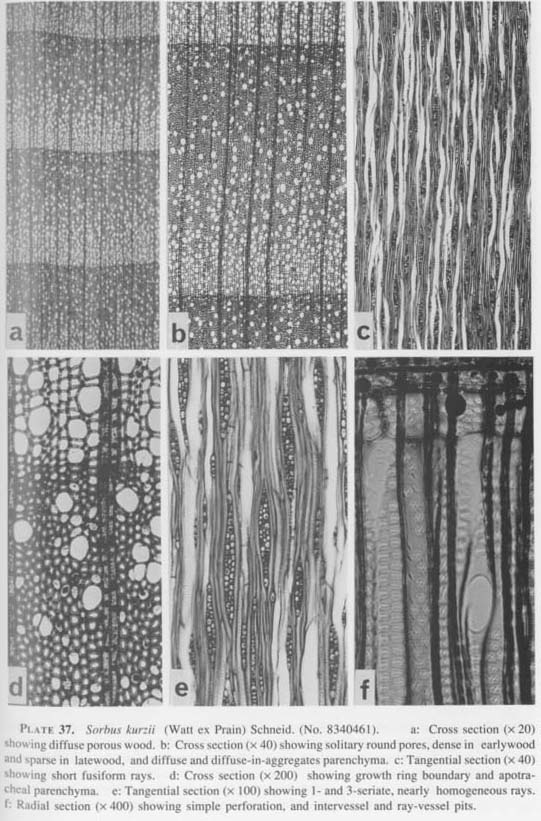
Small deciduous trees in the upper temperate and subalpine zones.
SPECIMENS. No. 8340461*, d=25 cm, h=5 m, alt. 2650 m: Janakpur Zone, Dolakha Distr., Kyalche (2700 m) - Thandingma (3200 m), H. Ohba et al., Sept. 1, 1983. No. 8540249, d=20 cm, h=5 m, alt. 3150 m: Sagarmata Zone, Solukhunbu Distr., Sarkari Pati (3350 m) - Beni (2350 m), H. Ohba et al., Sept. 3, 1985. No. 8840233, d=20 cm, h=5 m, alt. 3140 m: Koshi Zone, Sakuwasabha Distr., Danda Kharka (2860 m) - Unshisa Kharka (3150 m) - Khongma (3500 m), M. Suzuki et al,, July 15, 1988.
DESCRIPTION. Wood diffuse porous with numerous small pores. Growth rings distinct; difference in pore diameter and density, and flattened marginal fibertracheids define growth ring boundaries; usually narrow, 0.2-1.8 mm. Pith flecks occasionally observed. Pores sparse to abundant; in No. 8340461, quite numerous (370-800/mm2) with many clusters in earlywood, and fewer (135-184/mm2) in latewood; 30-230/mm2 in the other specimens; solitary, or in clusters of 2-3 or more; in No. 8340461, clustering conspicuous in earlywood with smaller polygonal pores; pore size gradually reduced at the end of growth rings. Solitary pores round or slightly polygonal in outline, small to minute, 15-60 × 13-42 µm, with thin walls (about 1.5 µm).
Vessel elements short, 190-580 µm; perforation plates simple or reticulate, occasionally scalariform; mostly simple in No. 8340461, and usually reticulate in No. 8540249. Intervessel pits on both the radial and tangential walls, round, or horizontally elliptic, about 6 × 6-10 µm, with long slit-like horizontal apertures. Helical thickenings on the entire inner walls.
Non-perforated tracheal elements fiber-tracheids, constituting ground mass of the wood, round or polygonal in cross section, 5-20 µm in diameter, with thick walls (about 3 µm). Bordered pits on both the radial and tangential walls in No. 8340461 and 8840233, but only on the radial walls in No. 8540249; sparse, small and round, about 4-5 µm in diameter, with slit-like apertures. Fine helical thickenings distinct on the entire inner walls.
Wood parenchyma diffuse or diffuse-in-aggregates, and conspicuous especially in latewood; strands consists mostly of 3-6 cells. Rhomboidal crystals occasionally observed in large cells, 15-25 µm in length.
Rays nearly homogeneous, small, fusiform, uniseriate and 2-3-seriate. Uniseriate rays usually consist of procumbent and square to upright cells, 2-7 cells and 50- 200 µm or more tall. Multiseriate rays small, fusiform, 20-35 µm wide, and 140- 340 µm tall, consisting mostly of procumbent cells with occasional square to upright cells at the upper or lower ends, occasionally with uniseriate wings 2-4 cells tall. Procumbent cells round or slightly polygonal in tangential section, 10-38, 7-20 × 40-210 µm square and upright cells elliptical or oblong in tangential section, 33- 95, 12-18 × 28-53 µm. Crystals absent. Ray-vessel pits numerous and alternate, round, about 3-4 µm in diameter, with horizontal slit-like long apertures.
Sorbus microphylla Wenzig [Plate 38]
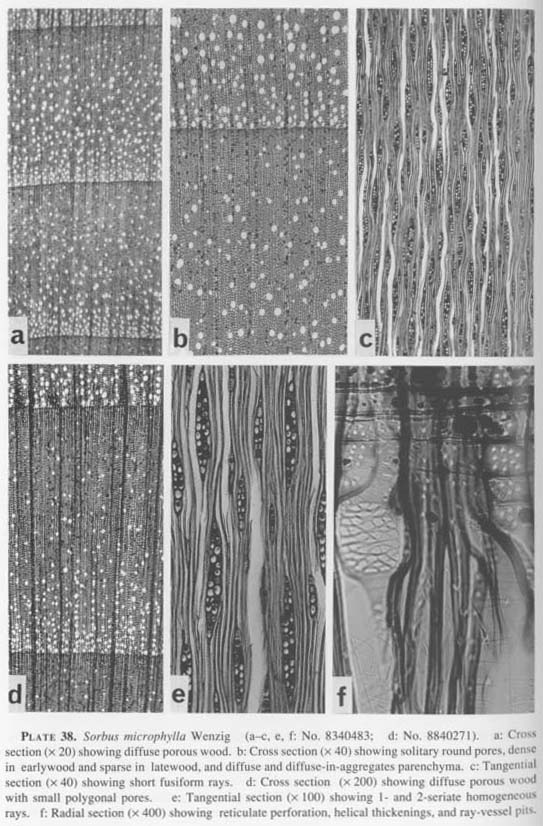
Small deciduous trees in the subalpine and alpine zones.
SPECIMENS. No. 8340483*, d=12 cm, h=6 m, alt. 3280 m: Janakpur Zone, Dolakha Distr., Thandingma (3200 m) - Beding (3600 m), H. Ohba et al., Sept. 2, 1983. No. 8340486, d=20 cm, h=6 m, alt. 3600 m; No. 8340490, d=15 cm, h=5 m, alt. 3650 m: Janakpur Zone, Dolakha Distr., Beding (3600 m) - Na (4050 m), H. Ohba et al,, Sept. 4, 1983. No. 8540174, d=8 cm, h=4 m, alt. 3880 m: Bagmati Zone, Ramechap Distr., Botase Kharka (4500 m) - Koshing Kharka (4000 m), H. Ohba et al., July 21, 1985. No. 8540248, d=30 cm, h=7 m, alt. 3560 m: Sagarmata Zone, Solukhunbu Distr., Sarkari Pati (3350 m) - Beni (2350 m), H. Ohba et al., Sept. 3, 1985. No. 8840271, d=8 cm, h=2.5 m, alt. 3890 m: Koshi Zone, Sakuwasabha Distr., Tutu La (4070 m) - Mumbuk (3500 m), M. Suzuki et al., July 17, 1988.
DESCRIPTION. Wood diffuse porous with numerous small pores, tending to be semiring porous with slightly larger pores at the beginning of growth rings. Growth rings distinct; difference in pore diameter and density, and flattened marginal fiber-tra- cheids define growth ring boundaries; usually narrow, 1.2-2.8 mm. Pores abundant, numerous, 146-216 (234-440 in No. 8840271) /mm2, in earlywood, and rather sparse, 52-100 (72-146) /mm2, in latewood, solitary, or in clusters of 2-4 or more; pore size gradually reduced toward the end of growth rings. Solitary pores round or polygonal in outline, small to minute, 18-62 (12-35 in No.8840271) × 13-50 (12-30) µm, with thin walls (about 1.5 µm).
Vessel elements short, 150-400 µm; perforation plates predominately simple, but reticulate ones also common, especially in No. 8840483. Intervessel pits on both radial and tangential walls, rather dense and alternate, round, or horizontally elongated, 6 × 6-12 µm, with short slit-like apertures. Helical thickenings on the entire inner walls.
Non-perforated tracheal elements fiber-tracheids constituting ground mass of the wood, round or polygonal in cross section, 5-22 µm in diameter, with thick walls (about 4 µm). Bordered pits only on the radial walls, sparse, small and round, 4-6 µm in diameter, with slit-like apertures. Fine helical thickenings on the entire inner walls.
Wood parenchyma diffuse and diffuse-in-aggregates, conspicuous, especially in latewood; strands consist mostly of 2-4 cells. Rhomboidal crystals occasionally observed, about 5-10 µm in length.
Rays almost homogeneous, small, fusiform, uniseriate and 2-seriate. Uniseriate rays usually consist of procumbent cells with some square cells, 1-12 cells and 30- 160 µm tall. Biseriate rays small, fusiform, 18-35 µm wide, and 100-340(-420) µm tall, consisting mostly of procumbent cells, with occasionally procumbent to square cells at the upper or lower ends, often with uniseriate wings 2-10 cells tall. Procumbent cells round in tangential section, 10-28, 8-18 × 40-200 µm; square or upright cells elliptical or oblong in tangential section, 35-55, 8-15 × 30-55 µm. Crystals absent. Ray-vessel pits numerous and alternate, round, about 3-4 µm in diameter, with nearly horizontal slit-like long apertures.
Sorbus rhamnoides (Decne.) Render [Plate 39]
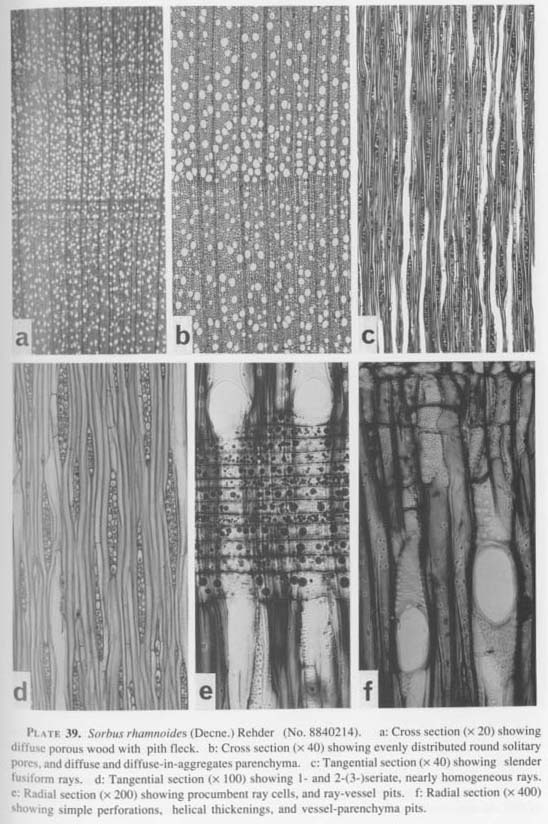
Large deciduous shrubs in the upper temperate and subalpine zones.
SPECIMEN. No. 8840214, d=8 cm, h=3 m, alt. 2650 m: Koshi Zone, Sakuwasabha Distr., Bhainsi Kharka (2540 m) - Danda Kharka (2860 m), M. Suzuki et al., July 15, 1988.
Description. Wood diffuse porous with numerous small pores. Growth rings distinct; difference in pore diameter and density, and flattened marginal fiber-tracheids define growth ring boundaries; usually narrow, 2.2-3.5 mm. Pith flecks occasionally observed. Pores numerous, 236-354/mm2, in earlywood, and many, 91-164/mm2, in latewood; reduction in pore density usually gradual; mostly solitary, or in clusters of 2; pore size reduced rather abruptly at the end of growth ring. Solitary pores round or slightly polygonal in outline, small, 20-67 × 20-60 µm, with thin walls (about 1.5 µm).
Vessel elements short, 200-560 µm; perforation plates exclusively simple, rarely reticulate. Intervessel pits on both the radial and tangential walls, rather dense and alternate, round, about 6 µm in diameter, with slit-like apertures. Helical thickenings present on the entire inner wall, often in twos, threes, or fours.
Non-perforated tracheal elements fiber-tracheids, constituting ground mass of the wood, round or polygonal in cross section, 5-22 µm in diameter, with thick walls (about 3 µm). Bordered pits on both the radial and tangential walls, but few on tangential walls, sparse, small and round, about 4 µm in diameter, with slit-like apertures. Fine helical thickenings on the entire inner walls.
Wood parenchyma diffuse and diffuse-in-aggregates, conspicuous throughout the growth ring; strands consist of 3-8 cells. Crystals absent.
Rays nearly homogeneous, narrow, uniseriate and 2-3-seriate. Uniseriate rays usually of procumbent, and of square to upright cells, 2-12 cells and 60-370 µm or more tall. Multiseriate rays small, fusiform, 15-30 µm wide, and 100-500 µm tall, mostly of procumbent cells, occasionally with square or upright cells at the upper or lower ends, usually with uniseriate wings 2-4 cells tall. Procumbent cells round or vertically elliptical in tangential section, 8-38, 8-13 × 50-160 µm; square or upright cells elliptical or oblong in tangential section, 20-82, 10-15 × 30-50 µm. Crystals absent. Ray-vessel pits numerous and alternate, round, about 4 µm in diameter, with slit-like apertures
Sorbus ursina (Wenzig) Decne. [Plate 40]

Small deciduous trees in the subalpine zone.
SPECIMENS. No. 8340475, d=20 cm, h=8 m, alt. 3150 m: Janakpur Zone, Dolakha Distr., Kyalche (2700 m) - Thandingma (3200 m), H. Ohba et al., Sept. 1, 1983. No. 8340480, d=20 cm, h=6 m, alt. 3230 m: Janakpur Zone, Dolakha Distr., Thandingma (3200 m) - Beding (3600 m), H. Ohba et al., Sept. 2, 1983. No. 8540163, d=30 cm, h=7 m, alt. 3360 m: Bagmati Zone, Ramechap Distr., Serdingma (3400 m) - Dubi Kharka (3720 m), H. Ohba et al., July 7, 1985. No. 8540183, d=25 cm, h=5 m, alt. 3530 m: Bagmati Zone, Ramechap Distr., Around Neju (3650 m), H, Ohba et al., July 31, 1985. No. 8540191, d=45 cm, h=10 m, alt. 3570 m: Bagmati Zone, Ramechap Distr., Around Neju (3650 m), H. Ohba etal., Aug. 1, 1985. No. 8840242, d=30 cm, h=10 m, alt. 3220 m: Koshi Zone, Sakuwasabha Distr., Danda Kharka (2860 m) -Unshisa Kharka (3150m)-Khongma (3500m), M. Suzuki et al., July 15,1988. No. 8840474*, d=18 cm, h=7,5 m, alt. 3140 m: Gandaki Zone, Kaski Distr., Banthanti (2600 m) - Deorali (3050 m), M. Suzuki et al., Aug. 24, 1988.
DESCRIPTION. Wood diffuse porous with numerous small pores. Growth rings distinct; difference in pore size and density, and flattened marginal fiber-tracheids define growth ring boundaries; usually narrow, 0.2-2.2 mm. Pith flecks occasional. Pores abundant, numerous, 332-408 (532-584 in No. 8340475) /mm2, in earlywood, and many, 55-150 (19-108) /mm2 in latewood, solitary, or in clusters of 2-3 or more; pore size reduced rather abruptly at the end of growth rings. Solitary pores round or slightly polygonal in outline, small, 13-68 × 10-45 µm, with thin walls (about 1.5 µm).
Vessel elements short, (150-)240-450 µm; perforation plates usually simple, occasionally reticulate. Intervessel pits on both radial and tangential walls, rather dense
and alternate, round, or horizontally elongated, about 6 × 6-12 µm, with short slitlike apertures. Helical thickenings on the entire inner walls.
Non-perforated tracheal elements fiber-tracheids, constituting ground mass of the wood, round or polygonal in cross section, 5-22 µm in diameter, with thick walls (about 3 µm). Bordered pits on both the radial and tangential walls, but occasionally fewer on the tangential, sparse, small and round.about 4 µm in diameter, with slitlike apertures. Fine helical thickenings on the entire inner walls.
Wood parenchyma diffuse and diffuse-in-aggregates, conspicuous; strands consist mostly of 2-4 cells. Crystals absent.
Rays almost homogeneous, small, fusiform, uniseriate and multiseriate. Uniseriate rays usually of procumbent cells with some square or upright cells, 1-10 cells and 30-165 µm or more tall. Multiseriate rays small, fusiform, 2-3(-4) cells and 25-45 µm wide, and 90-380 µm tall, consisting wholly of procumbent cells, often with uniseriate wings of 2-6 cells tall. Procumbent cells round or slightly polygonal in tangential section, 10-30, 6-15 × 68-240 µm; square or upright cells elliptical or oblong in tangential section. 30-70, 8-18 × 22-50 µm. Crystals absent. Ray-vessel pits numerous and alternate, round, about 3-4 µm in diameter, with horizontal slitlike apertures.
CORNACEAE (Shuichi NOSHIRO)
Benthamidia capitata (Wall.) Hara [Plate 41]
(= Cornus capitata Wall.)

Small deciduous trees in the temperate zone.
SPECIMENS. No. 8340198, d=30 cm, h=6 m, alt. 1980 m: Dhawalagiri Zone, Myagdi Distr., Dana (1550 m) - Ghansa (2030 m), H. Ohba et al., July 16, 1983. No. 8540266, d=18 cm, h=6 m, alt. 2440 m; Sagarmata Zone, Solukhunbu Distr., Beni(2350m) - Loding (2600 m), H. Ohba et al., Sept. 4, 1985. No. 8840536*, d=14 cm, h=5.5 m, alt. 2150 m: Dhawalagiri Zone, Mustang Distr., Ghansa (2030 m) - Lete (2470 m), M. Suzuki et al., Aug. 28, 1988.
DESCRIPTION. Wood diffuse porous with evenly distributed solitary pores. Growth rings distinct, and the boundaries often wavy with many depressions; flattened marginal fiber-tracheids, and difference in pore diameter define growth ring boundaries; usually wide, 0.6-6.0 mm. Pores sparse, 22-70/mm2 (46-96/mm2 in No. 8340345), and evenly distributed, mostly solitary, or in clusters of 2 (clusters/pore number 4.1%); pore size gradually reduced near the end of growth ring. Solitary pores round or slightly polygonal in outline, small, (18-)30-80 × 20-70 µm, with thin walls (about 2 µm).
Vessel elements long, 750-1200 µm; perforation plates exclusively scalariform with 25-68 (11-26 in No. 8340345) horizontal bars. Intervessel pits rare and sparse, scalariform, and opposite or alternate, round, or horizontally oblong, about 6×6-20 µm, with slit-like apertures. Helical thickenings usually absent, but distinct in some individuals (No. 8340345).
Non-perforated tracheal elements fiber-tracheids, constituting ground mass of the wood, round or polygonal in cross section, 8-35 µm in diameter, with thick walls (about 4 µm). Bordered pits on both the radial and tangential walls, sparse, small and round, 3-6 µm in diameter, with slit-like apertures. Helical thickenings usually absent, but distinct on the inner walls of some individuals (No.8340345).
Wood parenchyma diffuse and diffuse-in-aggregates, conspicuous; strands consist of 5-6 or more cells. Vessel-parenchyma pits numerous, and opposite or scalariform, round or horizontally oblong, 4-10 µm in horizontal diameter, with horizontal elliptical apertures. Crystals absent.
Rays heterogeneous, uniseriate and multiseriate. Uniseriate rays consist mostly of square and upright cells with some procumbent cells, 1-21 cells and (70-)200-1000 µm or more tall. Multiseriate rays small, fusiform, 2-4(-5) cells and 25-85 µm wide, and 205-1150 µm tall; multiseriate bodies consist of procumbent cells, 70-660 µm tall;uniseriate wings consist of upright or square cells, 1-8 or more cells tall. Procumbent cells round or slightly polygonal in tangential section, 7-40,5-35 × 35-205 µm; square or upright cells elliptical or oblong in tangential section, 30-125, 12-30 × 15-45 µm. Crystals absent. Ray-vessel pits numerous, and opposite or scalariform, round or horizontally oblong, 4-20 µm in horizontal diameter, with horizontal wide elliptical apertures, occasionally unilaterally compound.
Helwingia himalaica Hook. f et Thoms. ex C. B. Clarke1) [Plate 42]

Large deciduous shrubs in the upper temperate zone.
SPECIMEN. No. 8840197*, d=6 cm, h=3 m, alt. 2430 m: Koshi Zone, Sakuwasabha Distr., Uttise Kharka (2290 m) - Bhainsi Kharka (2540 m), M. Suzuki et al., July 14, 1988.
DESCRIPTION. Wood diffuse porous with sparse small polygonal pores. Growth rings distinct; flattened marginal fibers, and difference in pore diameter define growth ring boundaries; rather narrow, 0.2-0.9 mm. Pores sparse, 54-92/mm2, and evenly distributed occasionally increasing in number toward growth ring boundaries, usually solitary, or in clusters of 2-3(-4); pore size gradually reduced from beginning to end of growth ring. Solitary pores polygonal or square in outline, small, 30-75 × 20- 55 µm, with thin walls (about 1 µm).
Vessel elements 480-850 µm long; perforation plates eclusively scalariform with 18-58 horizontal bars. Intervessel pits occasional, scalariform, 8 × 10-28 µm, with elliptical apertures. Horizontal tyloses numerous and conspicuous. Helical thickenings not observed.
Non-perforated tracheal elements fibers, constituting ground mass of the wood, round or slight polygonal in cross section, 5-25 µm in diameter, with thick walls (about 3 µm), septate. Pits mostly on the radial walls, but occasionally on the tangential walls, sparse, round and minutely bordered, about 2.5 µm in diameter, with slit-like apertures. Helical thickenings not observed.
Wood parenchyma scanty paratracheal; strands consist mostly of 4-8 cells. Vesselparenchyma pits scalariform, about 6 µm in vertical diameter, with wide oblong apertures. Crystals absent.
Rays heterogeneous, uniseriate and multiseriate. Uniseriate rays consist of upright cells, 1-7 cells and 100-850 µm tall. Multiseriate rays very tall, slender, fusiform, 4-9 cells and 50-155 µm wide, and (300-)1020-5180(-7660) µm tall, consisting mostly
of square and upright cells with some procumbent ones; cell form and size irregular in tangential section. Procumbent cells vertically elliptical or slightly polygonal in tangential section, 10-25, 10-25 × 40-160 µm; square or upright cells elliptical or oblong in tangential section, 25-150, 12-25 × 18-38 µm. Crystals absent. Ray-vessel pits numerous and scalariform, horizontally oblong, about 6 µm in vertical diameter, with wide oblong apertures.
Swida controversa (Hemsl.) Soják [Plate 43]
(= Cornus controversa Hemsl.)
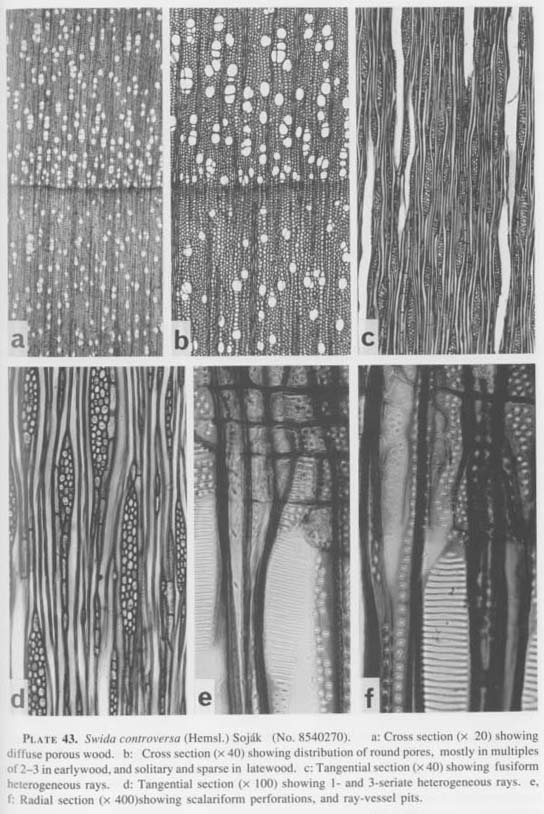
Deciduous trees in the upper temperate zone.
SPECIMEN. No. 8540270, d=20 cm, h=8 m, alt. 2500 m: Sagarmata Zone, Solukhunbu Distr., Beni (2350 m) - Loding (2600 m), H.Ohba et al., Sept. 4, 1985.
DESCRIPTION. Wood diffuse porous with evenly distributed pores. Growth rings distinct; flattened marginal fiber-tracheids define growth ring boundaries; usually wide, 6.7 mm. Pores sparse, 33-59/mm2, evenly distributed, solitary or in radial multiples of 2-3 (multiples/pore number 20.3 %); pore size gradually reduced at end of growth ring. Solitary pores slightly polygonal in outline, small, 30-98 × 28-75 µm, with thin walls (about 2 µm).
Vessel elements 590-980 µm long; perforation plates e×clusively scalariform with 28-57 horizontal bars. Intervessel pits on both radial and tangential walls, dense, opposite to alternate, round or slightly elongated, about 6×6- 12 µm, with small round or short slit-like apertures. Helical thickenings not observed.
Non-perforated tracheal elements fiber-tracheids, constituting ground mass of the wood, round or polygonal in cross section, 8-30 µm in diameter, with thick walls (about 3 µm). Bordered pits mostly on the radial walls, but occasionally on the tangential walls, sparse, small and round, about 5-6 µm in diameter, with slit-like apertures. Helical thickenings not observed.
Wood parenchyma diffuse and diffuse-in-aggregates, conspicuous; strands consist mostly of 4-10 cells. Vessel-parenchyma pits dense and round, about 4 µm in diameter, with small round apertures. Crystals absent.
Rays heterogeneous, uniseriate and 2-4-seriate. Uniseriate rays consist of procumbent, square, and upright cells, 1-9 cells and 45-330 µm or more tall. Multiseriate rays short fusiform, 20-55 µm wide and 140-730(-1240) µm tall; multiseriate bodies consist of procumbent cells, 50-450 µm tall; uniseriate wings consist of upright or square cells, 1-4(-11) cells tall. Procumbent cells round or slightly polygonal in tangential section, 7-30, 5-18 × 30-205 µm; square or upright cells elliptical or oblong in tangential section, 25-100, 6-20 × 20-30 µm. Crystals absent. Ray-vessel pits numerous, opposite to alternate, round, about 3 µm in diameter, with small round or elliptical apertures.
Swida macrophylla (Wall.) Soják [Plate 44]
(= Cornus macrophylla Wall.)

Deciduous trees in the upper temperate zone.
SPECIMENS. No. 8340106, d=30 cm, h=15 m, alt. 2280 m: Gandaki Zone, Kaski Distr., Ghandruk (1890 m) - Bhainsi Kharka (2460 m), H. Ohba et al., July 10, 1983. No. 8340304, d=20 cm, h=5 m, alt. 2620 m: Gandaki Zone, Manang Distr., Chame (2630 m) - Thangjo (2580 m), H. Ohba et al., Aug. 6,1983. No. 8840442*, d=24 cm, h=10 m, alt. 2250 m: Gandaki Zone, Kaski Distr., Ghandruk (1890 m) - Bainsi Kharka (2460 m), M. Suzuki et al., Aug. 22, 1988.
DESCRIPTION. Wood diffuse porous with evenly distributed round solitary pores. Growth rings distinct; flattened marginal fiber-tracheids, and difference in pore diameter define growth ring boundaries; usually narrow, 0.2-4.2 mm. Pores sparse, 22-55/mm2, evenly distributed, e×clusively solitary (multiples/pore number 1.9 %); pore size gradually reduced near the end of growth rings; round, or slightly polygonal in outline, 25-115 × 25-93 µm, with thin walls (about 1.5 µm).
Vessel elements 500-920 µm long; perforation plates eclusively scalariform with 29-66 horizontal bars. Intervessel pits rare on radial and tangential walls, rather dense, scalariform or opposite to alternate, round or horizontally oblong, about 6 × 6-30 µm, with short slit-like apertures. Helical thickenings not observed.
Non-perforated tracheal elements fiber-tracheids, constituting ground mass of the wood, round or polygonal in cross section, 5-28 µm in diameter, with thick walls (about 3 µm). Bordered pits on both the radial and tangential walls, sparse, round, about 5-10 µm in diameter, with slit-like apertures. Helical thickenings not observed.
Wood parenchyma diffuse and diffuse-in-aggregates, conspicuous; strands consist mostly of 4-8 cells. Vessel-parenchyma pits round, about 4 µm in diameter, with short elliptical apertures. Crystals absent.
Rays heterogeneous, uniseriate and 2-4-seriate. Uniseriate rays consist of square and upright cells, 1-10 cells and 100-450 µm or more tall. Multiseriate rays small, fusiform; 15-45 µm wide and 110-750 µm tall; multiseriate bodies consist of procumbent cells, 80-580 µm tall; uniseriate wings consist of upright or square cells, 1-5(-8) cells tall. Procumbent cells round or vertically elliptical in tangential section, 15-32, 5-28 × 50-210 µm; square or upright cells elliptical or oblong in tangential section, 30-120, 10-20 × 22-65 µm. Crystals absent. Ray-vessel pits numerous, opposite, round or slightly elliptical, about 5 µm in diameter, with slitlike apertures.
ALANGIACEAE (Kiyotsugu YODA and Mitsuo SUZUKI)
Alangium alpinum (C. B. Clarke) W. W. Smith et Cave [Plate 45]
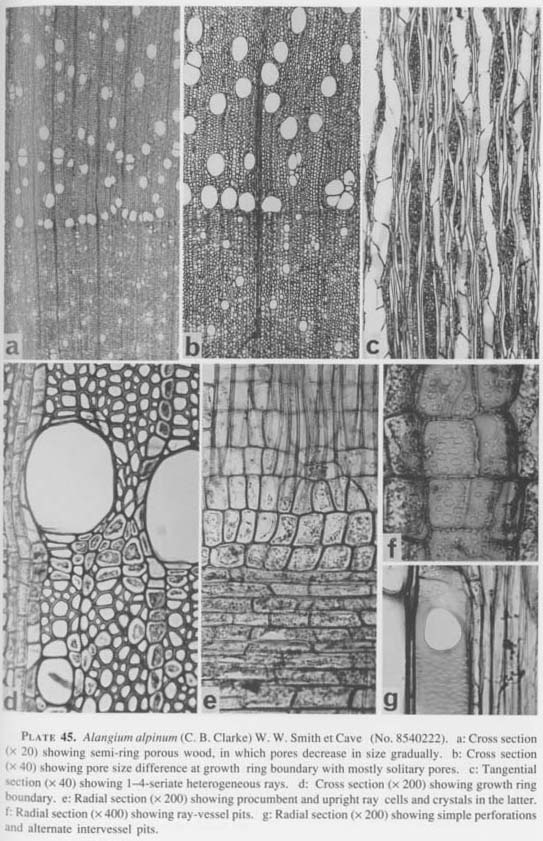
Small deciduous trees in the temperate zone.
SPECIMENS. No. 8340186, d=12 cm, h=5 m, alt. 1330 m: Dhawalagiri Zone, Myagdi Distr., Tatopani (1360 m) - Dana (1550 m), H. Ohba et al., July 16, 1983. No. 8340503, d=12 cm, h=5 m, alt. 2130 m: Janakpur Zone, Dolakha Distr., Phedi Kharka (2100 m) - Koplang (2100 m), H. Ohba etal., Sept. 14,1983. No. 8540124, d=2.5 cm, h=1.5 m, alt. 2320 m; No. 8540125, d=25 cm, h=6 m, alt. 2340 m: Bagmati Zone, Nuwakot Distr., Kutumsang (2450 m) - Gul Bhanjyang (2120 m), M. Suzuki & S. Noshiro, June 5, 1985. No. 8540222*, d=10 cm, h=5 m, alt. 2100 m: Bagmati Zone, Ramechap Distr., Kyama (2600 m) - Patkare (2200 m), H. Ohba et al., Aug. 4, 1985. No. 8840121, d=10 cm, h=7 m, alt. 2050 m; Koshi Zone, Sakuwasabha Distr., Sakrate (1840 m) - Hurhure (2040 m) - Mude (2040 m), M. Suzuki et al., July 9, 1988.
DESCRIPTION. Wood ring porous. Growth rings distinct, 0.5-6 mm wide. Pores decrease in size gradually towards growth ring boundary. Large pores evenly distributed in several layers in earlywood, mostly solitary and sometimes in radial or oblique multiples of 2(-4); solitary pores circular or elliptical, slightly angular in outline, 115-170 (average 144) × 75-120 (average 102) µm; walls slightly thickened (about 3 µm) with common walls more thickened (about 7 µm). Small pores solitary, evenly distributed in latewood, circular or elliptical in outline, rather angular especially at the end of growth rings, 50-90 (average 66) × 40-70 (average 50)µm , thinwalled.
Vessel elements short, 240-440 µm. End walls horizontal or somewhat oblique in earlywood, and oblique in latewood. Perforation plates exclusively simple. Intervascular pits alternate and dense, circular or polygonal in outline, about 8 µm in diameter, with more or less horizontally elongated apertures. Helical thickenings not observed. Tyloses and gum-like deposits absent.
Non-vascular tracheal elements fiber-tracheids, consisting ground mass of the wood, triangular, square or polygonal in cross section, 17-27 µm in diameter; wall about 2.4 µm thick; pits small, circular, about 4 µm in diameter, with oblique slitlike apertures; non-septate; helical thickenings not observed.
Wood parenchyma diffuse, scanty paratracheal and marginal, square or polygonal in cross section; sometimes strands with several cells; cells 55-80 µm in diameter and 70-150 µm long. Vessel-parenchyma pits circular to elliptical with large apertures, about 8 µm in diameter. Crystals absent.
Rays heterogeneous, 1-4 cells wide. Uniseriate rays composed of upright and square cells, 120-420 µm tall. Multiseriate rays narrow fusiform, 2-4 cells or 30-75 µm wide and 230-800 µm tall; multiseriate bodies of procumbent and sheath cells, 230-910 µm tall; uniseriate wings of upright and square cells, 130-350 µm tall. Procumbent cells oval in tangential section, 17-35, 12-30 × 55-150 µm; square and upright cells 28-80,15-38 × 25-50 µm. Ray-vessel pits circular to elliptical, about 7 µm; in diameter, with large apertures. Druses sometimes present in square cells.
Alangium chinense (Lour.) Harms [Plate 46]

Small deciduous trees in the temperate zone.
SPECIMEN. No. 8840509, d=14 cm, h=8.5 m, alt.1800 m: Dhawalagiri Zone, Myagdi Distr., Khipang (1740 m) - Paudwar (1900 m), M. Suzuki et al., Aug. 26, 1988.
DESCRIPTION. Wood ring porous. Growth rings distinct, 8 mm or more wide. Pores diminish in size gradually. Pores solitary or in radial multiples of 2-4 in earlywood; solitary pores elliptical in outline, 160-280 × 100-180 µm, thin-walled (about 2 µm) with more thickened common walls (about 8 µm). Pores mostly solitary in latewood, elliptical or rounded in outline, 30-120 × 40-80 µm; smallest pores near end of growth rings tend to be square in outline, thin-walled.
Vessel elements short, 320-480 µm. End walls oblique. Perforation plates exclusively simple. Intervascular pits alternate, not dense, circular to polygonal in outline, about 12 µm in diameter. Helical thickenings not observed. Tyloses and gum-like deposits absent.
Non-perforate tracheal elements are fiber-tracheids, constituting ground mass of the wood, triangular, square or polygonal in cross section, 18-23 µm in diameter, with about 3 µm thick wall; pits small and circular, about 3 µm in diameter; nonseptate; helical thickenings not observed.
Wood parenchyma diffuse, vasicentric and marginal, polygonal to square in cross section; in strands with several cells; cells 20-25 µm in diameter and 50-180 µm long; crystals not observed.
Rays heterogeneous, large, fusiform. Uniseriate rays of upright and square cells, 160-550 µm tall. Multiseriate rays large, fusiform, 2-7 cells or 30-88 µm; wide and 230-1100 µm; tall; multiseriate bodies of procumbent and sheath cells, 240-1020 µm tall; uniseriate wings of upright and square cells, 110-410 µm tall. Procumbent cells 18-20, 8-25 × 50-120 µm; square and upright cells 30-50, 12-33 × 25-40 µm. Rayvessel pits circular to horizontally elongated, 5-15 µm in diameter, with large apertures. Druses sometimes present in square cells.
TORICELLIACEAE (Shuichi NOSHIRO)
Toricellia tiliifolia DC. [Plate 47]
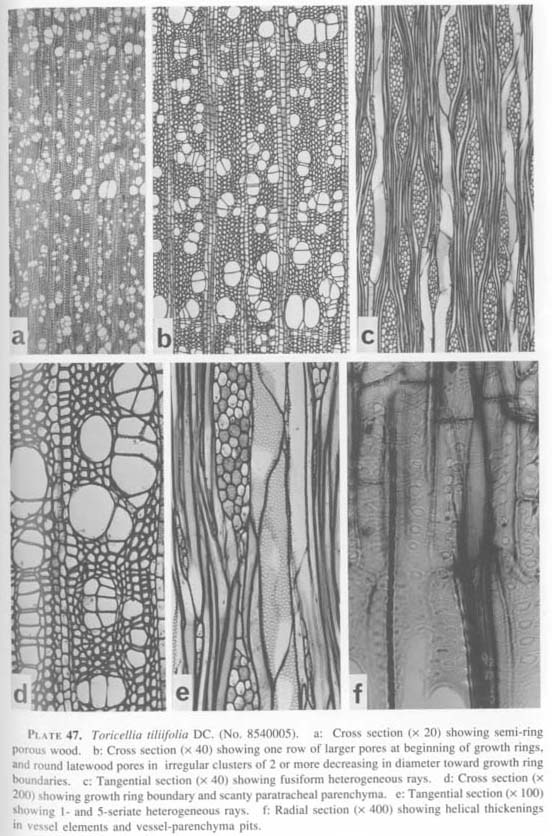
Small deciduous trees in the temperate zone.
SPECIMENS. No. 8340334, d=40 cm, h=7 m, alt. 2100 m: Gandaki Zone, Manang Distr., Dhanagyang (2200 m) - Dharapani (1800 m), H. Ohba et al., Aug. 7, 1983. No. 8540005*, d=25 cm, h=5 m, alt. 1980 m: Bagmati Zone, Rasuwa Distr., Ramche (2030 m) - Dunche (1980 m), M. Suzuki & S. Noshiro, May 22, 1985.
DESCRIPTION. Wood diffuse porous with many pores in multiples or irregular clusters, or semi-ring porous with one row of larger pores at beginning of growth rings. Growth rings occasionally indistinct, narrow, 0.7-2.8 mm; differences in pore diameter and flattened marginal fibers define growth ring boundaries. Pores numerous, mostly in radial multiples of 2-6 or in irregular polygonal clusters of various orientation and shape consisting of 2-10 pores or more, these tending to be in tangential or oblique bands, or in radial files; pore size decreasing gradually from beginning to end of growth rings, or rather abruptly at beginning of latewood. Solitary pores round in outline, slightly polygonal in latewood, 80-235(-260) × 70-190 µm in earlywood and (8-)20-160 × 30-115 µm in latewood, with thin walls (about 2 µm).
Vessel elements short to medium, (180-)280-700 µm; perforation plates exclusively simple. Intervessel pits on both radial and tangential walls, dense and alternate, round or polygonal, occasionally elliptical, about 4-6 × 4-20 µm, with narrow elliptical apertures. Helical thickenings present on inner walls. Septa-like tyioses conspicuous in heartwood.
Non-perforated tracheal elements libriform fibers, constituting ground mass of the wood, round or polygonal in cross section, 5-22 µm in diameter, with thick walls (about 3 µm), septate; pits only on the radial walls, sparse and small with slit-like apertures; helical thickenings not observed.
Wood parenchyma scanty paratracheal; strands consist mostly of 2-5 cells. Crystals absent
Rays heterogeneous, uniseriate and multiseriate. Uniseriate rays consist of tall procumbent, and square to upright cells, 1-6 cells (1-8 cells in No. 8840334) and
65-350 (70-510) µm or more tall. Multiseriate rays moderate to slender fusiform, 2-6 cells and (30-)35-110(-160) µm wide, and 165-1090(-1405) µm ((280-)620-2810 µm in No. 8840334) tall, consisting of tall procumbent, square, and upright cells, usually without uniseriate wings. Procumbent cells round or slightly polygonal in tangential section, 28-42, 10-25 × 40-110 µm; square and upright cells elliptical or oblong in tangential section, 35-82, 12-40 × 27-60 µm. Crystals absent. Ray-vessel pits numerous and alternate, round or horizontally elliptical, about 6 × 7-18 µm, with wide elliptical apertures, occasionally unilaterally compound.
SYMPLOCACEAE (Akira TAKAHASHI and Mitsuo SUZUKI)
Symplocos glomerata King ex C. B. Clarke [Plate 48]

Small evergreen trees in evergreen forests in the temperate zone.
SPECIMEN. No. 8840206, d=12 cm, h=4 m, alt. 2550 m: Koshi Zone, Sakuwasabha Distr., Bhainsi Kharka (2540 m) - Danda Kharka (2860 m), M. Suzuki et al., July 15, 1988.
DESCRIPTION. Wood diffuse porous. Growth rings distinct, delineated by radially flattened fiber-tracheids, 1.6-4.2 mm wide. Pores evenly distributed, 60-108/mm2, mostly solitary, sometimes in radial multiples of 2-3(-4). Solitary pores angular in outline, small, 30-75 × 25-50 µm, thin-walled, about 1 µm thick. Pith flecks rarely present.
Vessel elements medium, 600-1000 µm long; end walls oblique; perforation plates exclusively scalariform, with many, 20-40 bars. Intervessel pits very rare, scalariform to transitional, horizontally elongated, 4-5 × 6-10 µm. Helical thickenings distinct. Tyioses and gum-like deposits absent.
Fiber-tracheids constitute ground mass of the wood, polygonal in cross section, 10-25 µm in diameter; walls 2-3.5 µm thick; pits distinctly bordered, circular 5-7 µm in diameter, with oblique slit-like apertures; non-septate; helical thickenings distinct.
Wood parenchyma predominantly apotracheal, diffuse and diffuse-in-aggregates, rather few, in strands; cells 12-20 µm in radial diameter and 100-180 µm long; crystals absent.
Rays heterogeneous, uniseriate and multiseriate, 11-16 rays/mm length in tangential section. Uniseriate rays composed of upright and square cells, 2-18 cells (100-700 µm) tall. Multiseriate rays narrow, 2-3 cells (25-35 µm) wide and 200-1300 µm tall; multiseriate portions composed of procumbent cells; uniseriate wings composed of upright and square cells, 1-12 cells (50-600 µm), up to 22 cells (750 µm) tall; two or three multiseriate portions occasionally connected vertically by uniseriate upright and square cells. Upright and square cells 35-100,15-25 × 25-70 µm; procumbent cells 12-30,10-25 × 60-180 µm. Ray-vessel pits half-bordered, transitional to opposite, sparse, circular or horizontally elongated, 4-17 µm in horizontal diameter. Crystals absent.
Symplocos paniculata (Thunb.) Miq. [Plate 49]
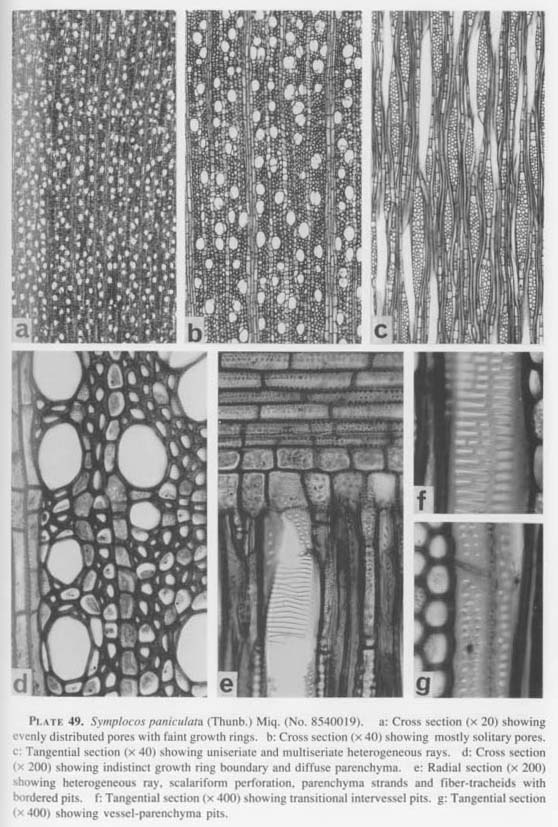
Evergreen trees in evergreen forests in the temperate zone.
SPECIMENS. No. 8340008, d=8 cm, h=3 m, alt. 1390 m: Bagmati Zone, Kathmandu Valley,Nagarjun Ban, H. Ohba et al., June 29, 1983. No. 8340162, d=60 cm, h=13 m, alt. 2680 m: Dhawalagiri Zone, Myagdi Distr., Ghorepani Deorali (2830 m) - Shika (2010 m), H. Ohba et al., July 14, 1983. No. 8340182, d=15 cm, h=5 m, alt. 1850 m: Dhawalagiri Zone, Myagdi Distr., Shika (2010 m) - Tatopani (1360 m), H. Ohba et al., July 15, 1983. No. 8540019*, d=22 cm, h=4.5 m, alt. 1990 m: Bagmati Zone, Rasuwa Distr., Syabru (2240 m) - Lama Hotel (2480 m), M. Suzuki & S. Noshiro, May 24, 1985. No. 8840515, d=12 cm, h=4.5 m, alt. 1800 m: Dhawalagiri Zone, Myagdi Distr., Paudwar (1900 m) - Jibang (1760 m), M. Suzuki et al., Aug. 26, 1988.
DESCRIPTION. Wood diffuse porous. Growth rings distinct or indistinct, delineated by radially flattened fiber-tracheids, 0.35-1.7 mm wide. Pores evenly distributed, 44-77/mm2, almost solitary and rarely in radial multiples of 2-3. Solitary pores angular or somewhat rounded in outline, small, 40-110 × 35-90 µm, thin-walled, 1-3 µm thick. Pith flecks absent.
Vessel elements long, 730-1300 µm; end walls oblique; perforation plates exclusively scalariform, with 25-45 bars. Intervessel pits very rare, scalariform to transitional, circular to rectangular, or horizontally elongated, 4-5 × 6-22 µm. Helical thickenings present but indistinct. Tyloses and gum-like deposits absent.
Fiber-tracheids constitute ground mass of the wood, polygonal in cross section, 15-40 µm in diameter; walls 3.5-5 µm thick; pits distinctly bordered, circular 6-7 µm in diameter, with oblique slit-like apertures; non-septate; helical thickenings present.
Wood parenchyma predominantly apotracheal, diffuse and diffuse-in-aggregates, in strands; cells 20-30 µm in radial diameter and 100-150 µm long; crystals absent. Vessel-parenchyma pits opposite or alternate, circular, 4-5 µm in diameter.
Rays heterogeneous, uniseriate and multiseriate, 9-12 rays/mm length in tangential section. Uniseriate rays composed of upright and square cells, 1-10 cells (100-580 µm) tall. Multiseriate rays 2-5 cells (25-100 µm) wide and 200-1200 µm, up to 1700 µm tall; multiseriate portions composed of procumbent cells; uniseriate wings composed of upright and square cells, 1-13 cells (70-730 µm) tall; two or three multiseriate portions often connected vertically by uniseriate upright and square cells. Upright and square cells 40-120, 15-50 × 25-60 µm; procumbent cells 20-35, 12-30 × 70-180 µm. Ray-vessel pits half-bordered, transitional to opposite or alternate, circular or horizontally elongated, 4-8 µm in diameter. Crystals absent.
Symplocos pyrifolia Wall. ex G. Don [Plate 50]
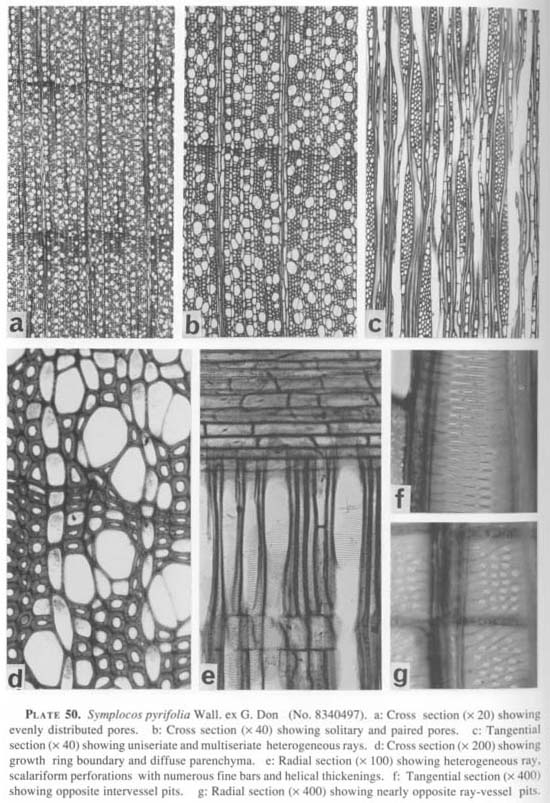
Evergreen trees in temperate evergreen forests.
SPECIMENS. No. 8340007, d=10 cm, h=4 m, alt. 1390 m: Bagmati Zone, Kathmandu Valley, Nagarjun Ban, H. Ohba et al., June 29, 1983. No. 8340497*, d=40 cm, h=12 m, alt. 2130 m: Janakpur Zone, Dolakha Distr., Phedi Kharka (2100 m) - Koplang (2100 m), H. Ohba et al., Sept. 14, 1983.
DESCRIPTION. Wood diffuse porous. Growth rings distinct, delineated by radially flattened fiber-tracheids, 0.1-3.0 mm wide. Pores evenly distributed, many, 78-100/mm2, mostly solitary and sometimes in radial multiples of 2-3. Solitary pores angular in outline, small, 40-100 × 35-80 µm, thin-walled, 1-2 µm thick. Pith flecks rarely present.
Vessel elements long, 1000-1600 µm; end walls oblique; perforation plates exclusively scalarifbrm, with numerous, 35-60 bars. Intervessel pits very rare, scalari-form to opposite, circular to rectangular, or horizontally elongated, 4-6 × 7-40 µm. Helical thickenings distinct. Tyloses and gum-like deposits absent.
Fiber-tracheids constitute ground mass of the wood, polygonal in cross section, 13-35 µm in diameter; walls 3-5 µm thick; pits distinctly bordered, circular 8-10 µm in diameter, with oblique slit-like apertures; non-septate; helical thickenings present.
Wood parenchyma predominantly apotracheal, diffuse and diffuse-in-aggregates, in strands; cells 20-35 µm in radial diameter and 140-280 µm long; crystals absent.
Rays heterogeneous, uniseriate and multiseriate, 9-12 rays/mm length in tangential section. Uniseriate rays composed of upright and square cells, 1-12 cells (110-1100 µm), up to 23 cells (2100 µm) tall. Multiseriate rays 2-5 cells (30-120 µm) wide and tall, 330-1500 µm; multiseriate portions composed mostly of procumbent cells, sometimes square cells intermingled; uniseriate wings composed of upright and square cells, 1-17 cells (80-1630 µm) tall; sometimes two multiseriate portions connected vertically by. uniseriate upright and square cells. Upright and square cells 50-200, 15-45 × 35- 100 µm; procumbent cells 15-40, 12-35 × 80-240 µm. Ray-vessel pits half-bordered, opposite to alternate, circular or horizontally elongated, 5-8 µm in horizontal diameter. Crystals absent.
Symplocos ramosissima Wall. ex G. Don [Plate 51]
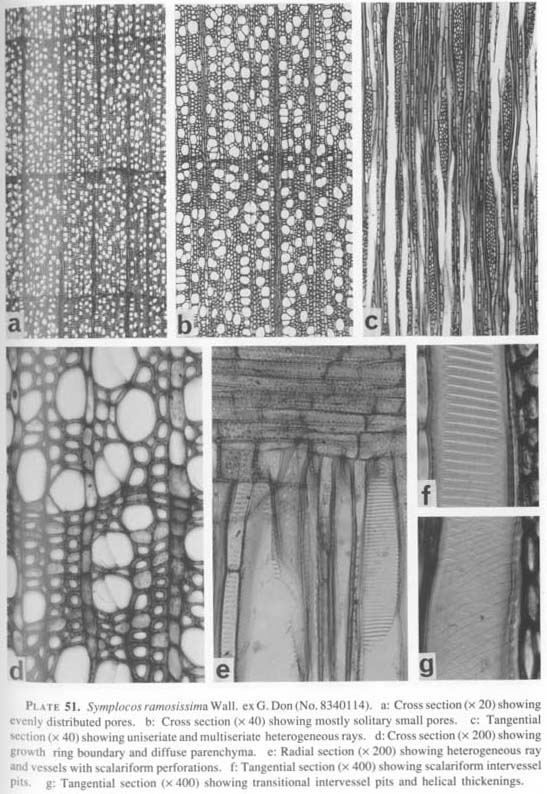
Evergreen trees in temperate evergreen forests.
SPECIMENS. No. 8340057, alt.1780 m: Gandaki Zone, Kaski Distr., Suiket (1230 m) - Pothana (1970 m), H. Ohba et al., July 7, 1983. No. 8340084, d=25 cm, h=10 m, alt. 2050 m: Gandaki Zone, Kaski Distr., Pothana (1970 m) - Tolka (1750 m), H, Ohba et al., July 8,1983. No. 8340114*, d=40 cm, h=12 m, alt. 2410 m: Gandaki Zone, Kaski Distr., Ghandruk (1890 m) - Bhainsi Kharka (2460 m), H. Ohba et al., July 10, 1983. No. 8340127, d=20 cm, h=7 m, alt, 2600 m: Gandaki Zone, Kaski Distr., Bhainsi Kharka (2460 m) - Banthanti (2600 m), H. Ohba et al., July 11, 1983. No. 8340501, d=25 cm, h=9 m, alt. 2130 m; No. 8340510, d=25 cm, h=8 m, alt. 2180 m: Janakpur Zone, Dolakha Distr., Phedi Kharka (2100 m) - Koplang (2100 m), H, Ohba et al., Sept. 14, 1983.
DESCRIPTION. Wood diffuse porous. Growth rings distinct, delineated by radially flattened fiber-tracheids, 1.6-2.35 mm wide. Pores evenly distributed, many, 108-127/mm2, mostly solitary and sometimes in radial multiples of 2-3. Solitary pores angular or somewhat rounded in outline, small, 35-105 × 40-75 µm, thin-walled, 1-2 µm thick. Pith flecks rarely present.
Vessel elements long, 600-1200 µm; end walls oblique; perforation plates exclusively scalariform, with 20-35 bars. Intervessel pits rare, scalariform to opposite, circular or horizontally elongated, 4-5 × 6-40 µm. Helical thickenings present. Tyloses and gum-like deposits absent.
Fiber-tracheids constitute ground mass of the wood, polygonal in cross section, 10-35 µm; in diameter; walls 3-5 µm; thick; pits distinctly bordered, circular about 8 µm; in diameter, with oblique slit-like apertures; non-septate. Helical thickenings present but indistinct.
Wood parenchyma predominantly apotracheal, diffuse and diffuse-in-aggregates, in strands; cells 13-30 µm; in radial diameter and 100-220 µm; long; crystals absent.
Rays heterogeneous, uniseriate and multiseriate, 13-15 rays/mm length in tangential section. Uniseriate rays composed of upright and square cells, 1-18 cells (100-1000 µm;), up to 28 cells (1460 µm;) tall. Multiseriate rays fusiform, 2-5 cells (20-60 µm;) wide and 450-2670 µm; tall; multiseriate portions composed of procumbent cells; uniseriate wings composed of upright and square cells, 1-14 cells (90-850 µm;), up to 20 cells (1220 µm;) tall; sometimes two multiseriate portions connected vertically by uniseriate upright and square cells. Upright and square cells 40-140, 12-25 × 25-70 µm; procumbent cells 20-35, 8-25 × 70-180 µm. Ray-vessel pits half-bordered, scalariform to transitional, circular or horizontally elongated, 5-35 µm in horizontal diameter, often unilaterally compound. Crystals absent.
Symplocos sumuntia Buch.-Ham. ex D. Don [Plate 52]
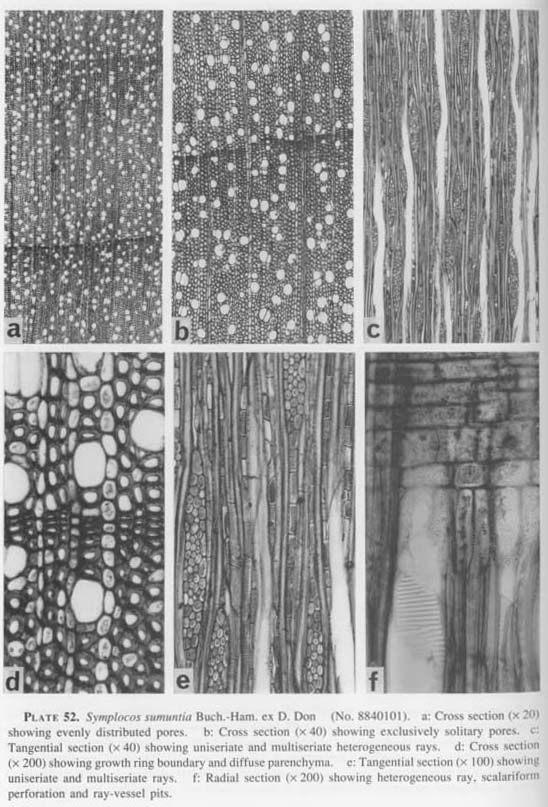
Evergreen trees in temperate evergreen forests.
SPECIMENS. No. 8340085, d=25 cm, h=7 m, alt. 2030 m: Gandaki Zone, Kaski Distr., Pothana (1970 m) - Tolka (1750 m), H. Ohba et al., July 8, 1983. No. 8540115, d=20 cm, h=4.5 m, alt, 2450 m: Bagmati Zone, Nuwakot Distr., Gopte (3350 m) - Kutumsang (2450 m), M. Suzuki & S. Noshiro, June 4, 1985. No, 8540134, d=25 cm, h=5 m, alt. 2000 m: Bagmati Zone, Dolakha Distr., Jiri (1860 m) - Ratmate (2270 m) - Shivalaya (1800 m), H. Ohba et al., July 4, 1985. No. 8840101*, d=25 cm, h=9 m, alt. 1880 m: Koshi Zone, Sakuwasabha Distr., Chichila (1870 m) - Kuwapani (1940 m), M. Suzuki et al., July 9, 1988. No. 8840120, d=12 cm, h=4 m, alt, 2050 m: Koshi Zone, Sakuwasabha Distr., Sakrate (1840 m) - Hurhure (2040 m) - Mude (2040 m), M. Suzuki et al., July 9, 1988. No. 8840624, d=15 cm, h=3 m, alt. 2070 m: Bagmati Zone, Kathmandu Valley, Shiwapuri Danda, M. Suzuki et al; Sept. 13, 1988.
DESCRIPTION. Wood diffuse porous. Growth rings distinct or faintly distinct, delineated by radially flattened fiber-tracheids, 0.2-2.4 mm wide. Pores evenly distributed, 64-79/mm2, almost solitary and rarely in radial multiples of 2-3. Solitary pores angular or somewhat rounded in outline, small, 35-110 × 40-90 µm, thin-walled, 1-2 µm thick. Pith flecks sometimes present.
Vessel elements long, 700-1200 µm; end walls oblique; perforation plates exclusively scalariform, with many, 20-40 bars. Intervessel pits very rare, scalariform to transitional, circular to rectangular, or horizontally elongated, 4-5 × 6-23 µm. Helical thickenings not observed. Tyloses and gum-like deposits absent.
Fiber-tracheids constituting ground mass of the wood, polygonal in cross section, 12-40 µm in diameter; walls 4-7 µm thick; pits distinctly bordered, circular 6-8 µm in diameter, with oblique slit-like apertures; non-septate; helical thickenings not observed.
Wood parenchyma predominantly apotracheal, diffuse and diffuse-in-aggregates, in strands; cells 13-35 µm in radial diameter and 90-230 µm long; crystals absent.
Rays heterogeneous, uniseriate and multiseriate, 14-17 rays/mm length in tangential section. Uniseriate rays composed of upright and square cells, 1-13 cells (100-1000 µm), up to 20 cell (1300 µm) tall. Multiseriate rays slender tall, fusiform, 2-4 cells (25-65 µm) wide and 350-2000 µm, up to 4000 µm tall; multiseriate portions
composed mostly of procumbent cells, sometimes square cells intermingled; unise-riate wings composed of upright and square cells, 1-17 cells (90-1100 µm) tall; sometimes, two or three multiseriate parts connected vertically by uniseriate upright and square cells. Upright and square cells 35-120, 12-30 × 20-60 µm; procumbent cells 25-35, 8-25 × 60-140 µm. Ray-vessel pits half-bordered, transitional to opposite, circular or horizontally elongated, 6-25 µm in horizontal diameter, occasionally unilaterally compound. Crystals absent.
Symplocos theifolia D. Don [Plate 53]
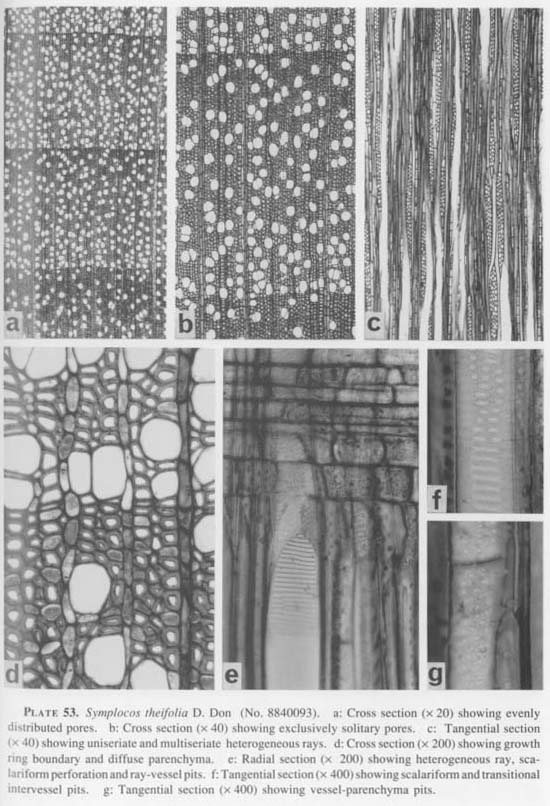
Small evergreen trees in temperate evergreen forests.
SPECIMENS. No. 8540001, d=15 cm, h=4 m, alt. 2020 m: Bagmati Zone, Rasuwa Distr., Ramche (2030 m) - Dunche (1980 m), M. Suzuki & S. Noshiro, May 22, 1985. No. 8540147, d=30 cm, h=8 m, alt. 2440 m: Bagmati Zone, Ramechap Distr., Shivalaya (1800 m) - Deorali (2700 m), H. Ohba et al., July 5, 1985. No. 8840093*, d=24 cm, h=18 m, alt. 1920 m: Koshi Zone, Sakuwasabha Distr., Bhotebas (1800 m) - Gogane (1870 m) - Chichila (1870 m), M. Suzuki et al., July 8, 1988. No. 8840171, d=14 cm, h=8 m, alt. 2200 m: Koshi Zone, Sakuwasabha Distr., Around Tashi Gaon (2160 m), M. Suzuki et al., July 13, 1988. No. 8840630, d=15 cm, h-3 m, alt. 2480 m: Bagmati Zone, Kathmandu Valley, Shiwapuri Danda, M. Suzuki et al., Sept. 14, 1988.
DESCRIPTION. Wood diffuse porous. Growth rings distinct, delineated by radially flattened fiber-tracheids, 1.4-4.5 mm wide. Pores evenly distributed, many, 66-102/mm2, mostly solitary and sometimes in radial multiples of 2-3 or in clusters. Solitary pores angular or somewhat rounded in outline, small, 45-95 × 40-80 µm, thin-walled, 1-1.5 µm thick. Pith flecks absent.
Vessel elements long, 600-1300 µm; end walls oblique; perforation plates exclusively scalariform, with many, 20-50 bars. Intervessel pits rare, scalariform to transitional, circular or horizontally elongated, 4-6 × 6-22 µm. Helical thickenings present. Tyioses and gum-like deposits absent.
Fiber-tracheids constitute ground mass of the wood, polygonal in cross section, 10-35 µm in diameter; walls 3-7 µm thick; pits distinctly bordered, circular 6-7 µm in diameter, with oblique slit-like apertures; non-septate; helical thickenings not observed.
Wood parenchyma predominantly apotracheal, diffuse and diffuse-in-aggregates, in strands; cells 12-28 µm in radial diameter and 90-240 µm long; crystals absent.
Rays heterogeneous, uniseriate and multiseriate, 11-13 rays/mm length in tangential section. Uniseriate rays composed of upright and square cells, 1-22 cells (130-1340 µm) tall. Multiseriate rays tall and slender fusiform, 2-4(-5) cells (20-60 µm)wide and 450-2500 µm tall; multiseriate portions composed of procumbent cells; uniseriate wings composed of upright and square cells, 1-14 cells (60-880 µm ) tall; occasionally, two multiseriate portions connected vertically by uniseriate upright and square cells. Upright and square cells 40-130, 10-27 × 20-60 µm; procumbent cells 15-35, 7-23 × 70-150 µm. Ray-vessel pits half-bordered, scalariform to opposite, circular or horizontally elongated, 5-25 µm; in horizontal diameter, occasionally unilaterally compound. Crystals absent.
PROTEACEAE (Akira TAKAHASHI and Mitsuo SUZUKI)
Helicia nilagirica Bedd. [Plate 54]
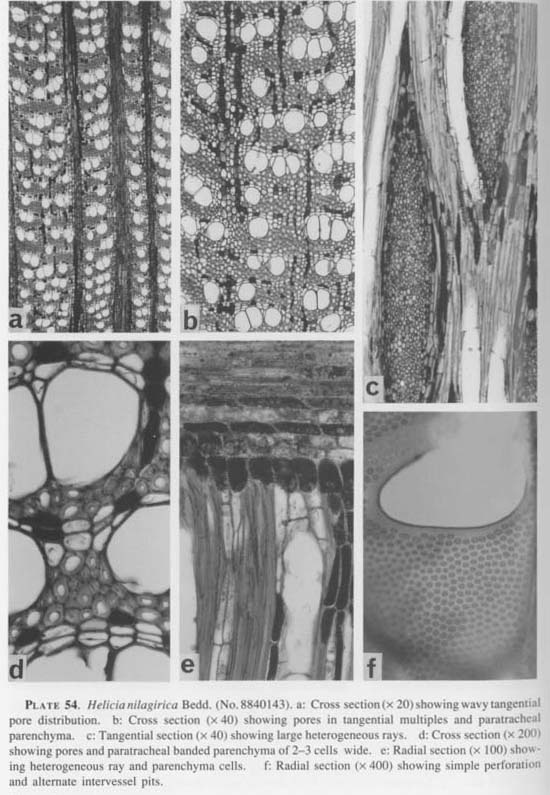
Medium-sized evergreen trees in temperate evergreen forests.
SPECIMENS. No. 8840132, d=10 cm, h=8 m, alt. 1800 m: Koshi Zone, Sakuwasabha Distr., Mude (2040 m) - Num (1540 m), M. Suzuki et al., July 10, 1988. No. 8840143*, d=24 cm, h=14 m, alt. 1000 m: Koshi Zone, Sakuwasabha Distr., Num (1540 m) - Arun Nadi (730 m), M. Suzuki et al., July 11, 1988.
DESCRIPTION. Wood diffuse porous. Growth rings not observed. Pores arranged in typical tangential series, which undulate near broad rays, 20-30/mm2, solitary and in tangential multiples of 2-4. Solitary pores angular to rounded in outline, medium, 65-170 × 40-160 µm;; walls 2-3 µm; thick. Pith flecks absent.
Vessel elements short, 250-600 µm; end walls slightly oblique or nearly horizontal; perforation plates exclusively simple. Intervessel pits alternate, circular, 5-7 µm in diameter. Helical thickenings not observed. Tyloses and gum-like deposits absent.
Libriform fibers constitute ground mass of the wood, polygonal in cross section, 12-40 µm in diameter; walls 5-10 µm thick; pits sparse, circular bordered, minute, 2-3 µm in diameter, with oblique slit-like apertures; non-septate; helical thickenings not observed.
Wood parenchyma abundant, unilaterally paratracheal banded; bands 1-3 cells wide; in strands; cells 20-50 µm in radial diameter and 100-280 µm long. Vessel-parenchyma pits alternate, circular, 3-5 µm in diameter. Crystals absent.
Rays heterogeneous, conspicuous, mostly multiseriate, sometimes uniseriate, 1-3 rays/mm length in tangential section. Uniseriate rays rather rare, composed of upright cells, 1-4 cells (140-550 µm) tall. Multiseriate rays very wide and tall, 7-24 cells (100-550 µm) wide and 800-4200 µm tall; upright and square cells sheath the central cores consisting of procumbent and square cells; uniseriate wings usually 1-3 cells (70-500 µm) tall. Upright and square cells 40-300, 15-60 × 20-80 µm; procumbent cells 13-55, 7-45 × 70-250 µm. Ray-vessel pits similar to vessel-parenchyma pits. Crystals absent.
JUGLANDACEAE (Lajmina JOSHI and Mitsuo SUZUKI)
Engelhardia spicata Leschen. ex Blume [Plate 55]
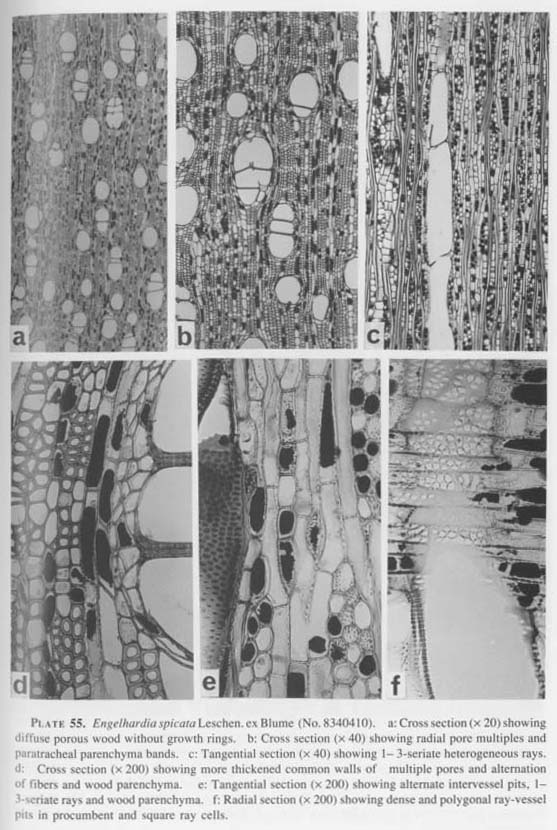
Large evergreen trees in the subtropical zone.
SPECIMENS. No. 8340389, d=30 cm, h=15 m, alt, 1170 m: Gandaki Zone, Lamjung Distr., Jagat (1300 m) - Bahundanda (1300 m), H. Ohba et al., Aug. 9, 1983. No. 8340410*, d=15 cm, h=5 m, alt. 960 m; No.8340411, d=15 cm, h=7 m, alt. 960 m: Janakpur Zone, Dolakha Distr., Malephu (900 m) - Pikhuti (950 m), H. Ohba et al., Aug. 27, 1983. No. 8840144, d=26 cm, h=13 m, alt. 1000 m: Koshi Zone, Sakuwasabha Distr., Num(1540 m) - Arun Nadi (730 m), M. Suzuki et al., July 11, 1988.
DESCRIPTION. Wood diffuse porous with medium pores and often with pith flecks. Growth rings indistinct; parenchymatous cells and 2-5 layers of tangentially flattened fiber-tracheids at margin faintly define growth rings, 1.05-2.2 mm wide. Pores few, evenly distributed, 2-5/mm2, solitary or in small multiples or clusters with two to several pores, oval in outline, medium, 80-200 × 60-150 µm, thick-walled, 3-5 µm.
Vessel elements 250-730 µm long; perforation plates exclusively simple; intervessel pits alternate, round to elliptical, a little large, 5-10 µm in diameter, with slit-like apertures. Helical thickenings not observed. Tyloses absent.
Non-perforated tracheal elements fiber-tracheids and libriform fibers, constituting ground mass of the wood, polygonal or rectangular in cross section, 10-30 µm in diameter, rather thin-walled (about 2-3 µm); bordered pits sparsely distributed in fiber-tracheids, small round, about 5 µm in diameter, with slit-like apertures. Helical thickenings not observed.
Wood parenchyma apotracheal banded, 1-2-seriate and paratracheal confluent. One layer of apotracheal parenchyma at the growth ring boundary. Parenchyma cells oval or polygonal in cross section, larger than fiber-tracheids, 20-50 µm in diameter; thin-walled, 1 µm; pits to vessels small, about 5 µm. in diameter, and dense. Crystals invisible.
Rays heterogeneous, uniseriate and multiseriate. Uniseriate rays mostly of upright and square cells, 1- 15 cells or 100-800 µm tall. Multiseriate rays narrow, 2-3-seriate or 50-75 µm wide and 275-1675 µm tall. Upright and square cells elliptical, fusiform or triangular in tangential section 35-130, 17-35 × 40-80 µm; procumbent cells oval or vertically elliptical in tangential section, 15-35, 13-35 × 50-220 µm. Ray-vessel pits numerous, alternate, dense, minute, polygonal or horizontally long elliptical, 2.5-3 µm, with slit-like apertures. Crystals invisible in any ray cells.
Juglans regia Linn. [Plate 56]
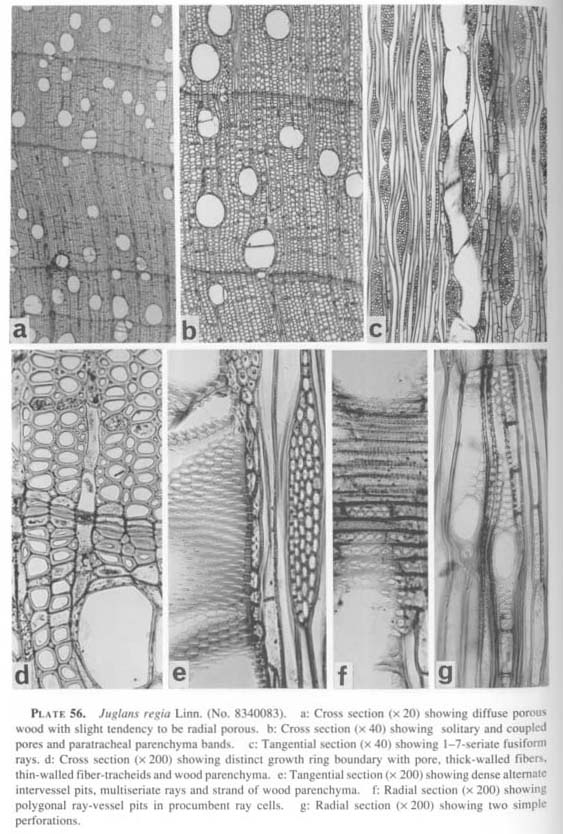
Large deciduous trees on mesic mountain slopes in the temperate zone.
SPECIMEN. No. 8340083, d=30 cm, h=12 m, alt. 2080 m: Gandaki Zone, Kaski Distr., Pothana (1970 m) - Tolka (1750 m), H. Ohba et al., July 8, 1983.
DESCRIPTION. Wood diffuse radial porous with medium to large pores. Growth rings distinct, delineated by 1-3 layers of flattened fiber-tracheids and one layer of wood parenchyma, narrow to a little wide, 0.3-2 mm. Pores few, roughly arranged in radial direction, 5-8/mm2, medium to large, gradually decreasing in size towards the end of growth rings, tending to be semi-ring porous, mostly solitary or in small radial multiples of 2-4. Solitary pores oval or round in outline, 50-250 × 50-299 µm, thin-walled, 2.5 µm. Pith flecks absent.
Vessel elements 170-900 µm long; perforation plates exclusively simple; intervessel pits dense, compact and alternate, a little large polygonal in outline, 5-12.5 µm in diameter, with slit-like apertures. Helical thickenings not observed. Tyioses abundantly present.
Non-perforated tracheal elements fiber-tracheids, consisting ground mass of the wood, square, polygonal or oval in cross section, 10-40 µm in diameter, a little thick-walled, 2.5 µm; bordered pits round, 5 µm in diameter.
Wood parenchyma apotracheal, diffuse-in-aggregate, in narrow discontinuous bands, similar to fiber-tracheids in cross section, thin-walled, 1.2 µm, Crystals not observed.
Rays homogeneous, uniseriate and multiseriate. Uniseriate rays low, 2-11 cells or 50-350 µm tall. Multiseriate rays wide and rather low, 2-7 cells or 20-81 µm wide, and 210-900 µm tall with uniseriate wings of 1-11 cells tall. Procumbent cells small oval or vertically elliptical in tangential section, 15-28, 10-20 × 55-120 µm. Rayvessel pits dense, alternate, oval, a little large, 5-12 µm in diameter. Crystals invisible.
MYRICACEAE (Lajmina JOSHI and Mitsuo SUZUKI)
Myrica esculenta Buch.-Ham. ex D. Don [Plate 57]
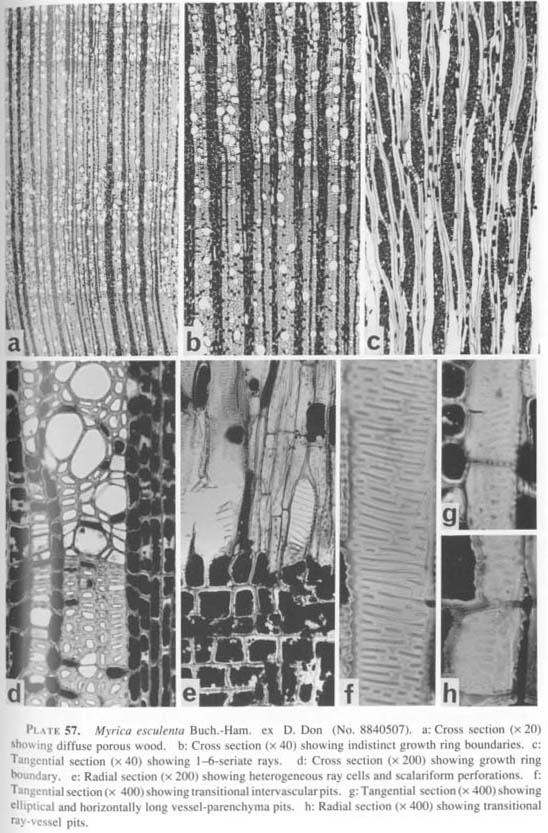
Medium-size evergreen trees from the upper subtropical zone to lower temperate zone; sometimes cultivated.
SPECIMENS. No. 8340046, alt. 1260 m: Gandaki Zone, Kaski Distr., Suiket (1230 m) -Pothana (1970 m), H. Ohba et al., July 7, 1983. No. 8340351, d=60 cm, h=8 m, alt. 1850 m: Gandaki Zone, Manang Distr., Dhanagyang (2200 m) - Dharapani (1800 m), H. Ohba et al., Aug. 7, 1983. No. 8340387, d=50 cm, h=8 m, alt. 1170 m: Gandaki Zone, Lamjung Distr., Jagat (1300 m) - Bahundanda (1300 m), H. Ohba et al., Aug. 9, 1983. No. 8540011, d=25 cm, h=5.5 m, alt. 2140 m: Bagmati Zone, Rasuwa Distr., Dunche (1980 m) - Syabru (2240 m), M. Suzuki & S. Noshiro, May 23, 1985. No. 8840507*, d=50 cm, h=9 m, alt. 1830 m: Dhawalagiri Zone, Myagdi Distr., Khipang (1740 m) - Paudwar (1900 m), M. Suzuki et al., Aug. 26, 1988.
DESCRIPTION. Wood diffuse porous with evenly distributed minute pores. Growth rings distinct, delineated by 1-3 layers of tangentially flattened fiber-tracheids, fairly wide, 3-4 mm. Pores minute and evenly distributed, rather sparse, 25-52/mm2, solitary, or in radial multiples or in clusters of 2-4. Solitary pores oval, round or polygonal with round corners, minute or small, 25-80 × 20-70 µm, thin-walled, 2-2.5 µm. Pith flecks often present.
Vessel elements 470-630 µm long; perforation plates exclusively scalariform with 1-17 fine bars at short intervals. Intervessel pits scalariform to transitional, round or elliptical in outline, 5-10 µm in diameter, with slit-like apertures. Helical thickenings not observed. Darkly-stained substances present.
Non-perforated tracheal elements of vascular tracheids and fiber-tracheids; v
ascular tracheids mixed in the pore multiples; fiber-tracheids constituting ground mass of the wood; oval or polygonal in cross section, 10-35 µm in diameter, rather thick-walled, 2.5-5 µm; bordered pits dense, oval or round in outline, 5-7.5 µm in diameter, with slit-like apertures; non-septate.
Wood parenchyma apotracheal diffuse, polygonal, square or oval in cross section, 15-30 µm in diameter. Crystals often present in vertical series of square cells.
Rays heterogeneous, uniseriate and multiseriate. Uniseriate rays 1-20 cells or 60-950 µm tall. Multiseriate rays distorted fusiform, 2-6 cells or 20-70 µm wide and 240-1250 µm tall, with uniseriate wings of 2-15 cells or 80-650 µm tall. Upright and square cells vertically triangular or elliptical in tangential section, 35-62, 50-110 × 20-50 µm; procumbent cells oval or elliptical in tangential section, 20-50,10-20 × 30-180 µm. Ray-vessel pits scalariform or transitionally, horizontal elliptical or oval, 3.7-17.5 µm in diameter, with slit-like apertures. Crystals sometimes present in square and short procumbent cells.
BETULACEAE (Lajmina JOSHI and Mitsuo SUZUKI)
Alnus nepalensis D. Don [Plate 58]
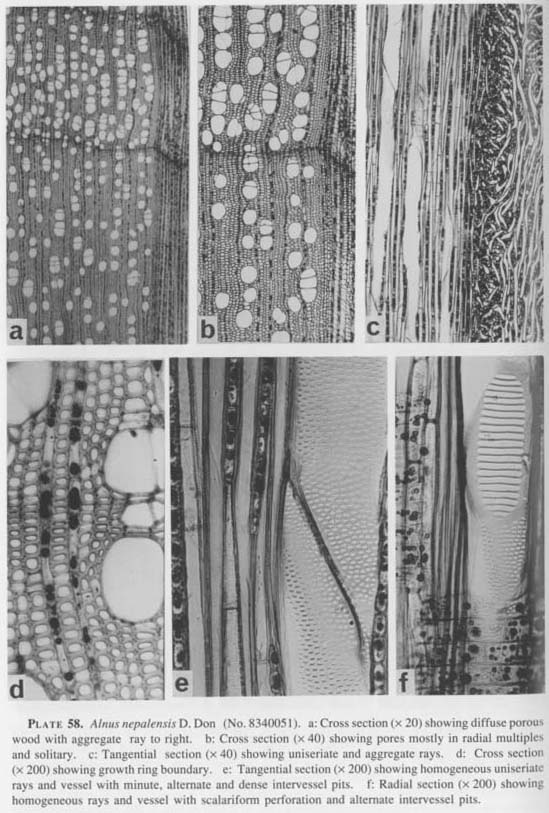
Huge deciduous trees on mesic mountain slopes from the upper subtropical to temperate zones.
SPECIMENS. No. 8340051*, alt. 1650 m: Gandaki Zone, Kaski Distr., Suiket (1230 m) -Pothana (1970 m), H. Ohba et al., July 7, 1983. No, 8540144, d=22 cm, h=12 m, alt. 2240 m: Bagmati Zone, Ramechap Distr., Shivalaya (1800 m) - Deorali (2700 m), H. Ohba et al., July 5, 1985. No. 8840007, d=20 cm, h=9 m, alt. 1770 m: Koshi Zone, Dhankuta Distr., Hile (1910 m) - Pakhribas (1700 m), M. Suzuki et al., July 2, 1988.
DESCRIPTION. Wood diffuse porous with aggregate rays. Growth rings present but undulate, 1.5-3.3 mm width, defined by parenchymatous cells and 2-3 layers of tangentially flattened vascular tracheids at margin. Pores dense and evenly distributed, smaller at growth ring boundary, 17-31/mm2, solitary or in radial multiple of 2-4; solitary pores oval or round in outline and not uniform in size, 52-133 × 44-118 µm, thin-walled, about 2 µm thick. Pith flecks absent.
Vessel elements long, 281-1006 µm; perforation plates exclusively scalariform with 5-27 fine bars. Intervessel pits alternate and minute, compactly arranged round or slightly horizontally long elliptical in outline, 4-10 µm in diameter, with slit-like apertures. Tyloses and helical thickenings not observed.
Non-perforated tracheal elements of vascular tracheids and fiber-tracheids. Vascular tracheids paratracheal and marginal at the growth rings, polygonal or rectangular in cross section, 15-44 µm in diameter, thick-walled, about 4 µm; pits round and similar to intervessel pits; helical thickenings not observed. Fiber-tracheids constituting ground mass of the wood, square or polygonal in cross section, 15-33 µm in diameter; bordered pits sparsely arranged and round in outline, about 4 µm in diameter, with slit-like apertures.
Wood parenchyma apotracheal diffuse, oval in cross section, 15-30 µm in diameter, thin-walled, 1.9 µm thick. Crystals invisible.
Rays homogeneous, uniseriate and aggregate. Uniseriate rays of wholly procumbent cells, 1-34 cells (48-829 µm) tall and 15-25 µm wide; ray cells 25-38, 15-25 × 75-155 µm. Aggregate rays 400-800 µm wide and more than 10 mm tall. Ray-vessel pits numerous and dense, oval or horizontally elliptical, 2.5-6 µm in diameter, with horizontally long slit-like apertures. Crystals invisible.
Betula alnoides Buch.-Ham. ex D. Don [Plate 59]
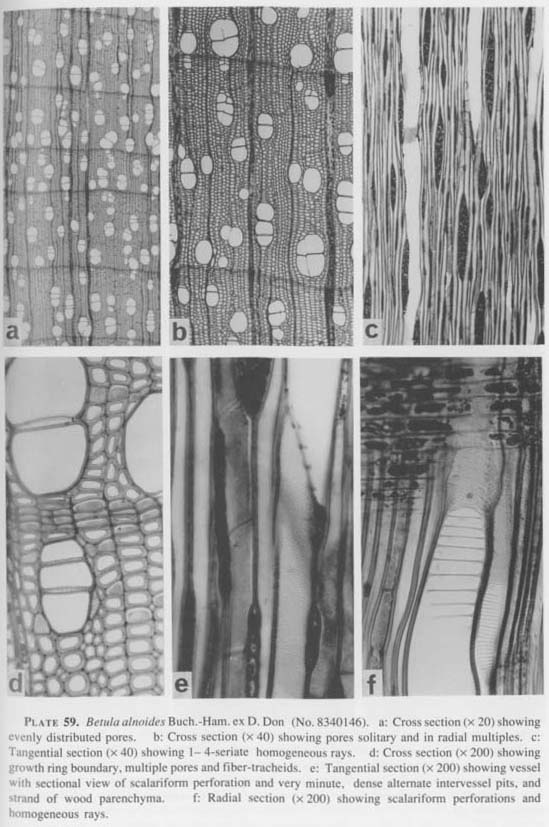
Very large deciduous trees in the temperate zone; one of the main elements in temperate deciduous forests.
SPECIMENS. No. 8340146*, d=80 cm, h=20 m, alt. 2880 m: Gandaki Zone, Kaski Distr., Banthanti (2600 m) - Deorali (3050 m), H. Ohba et al., July 12, 1983. No. 8340153, d=25 cm, h=12m, alt. 3130 m: Dhawalagiri Zone, Myagdi Distr., Deorali (3050 m) - Ghorepani Deorali (2830 m), H. Ohba et al., July 12, 1983. No. 8340202, d=80 cm, h=18 m, alt. 2180 m: Dhawalagiri Zone, Mustang Distr., Ghansa (2030 m) - Lete (2470 m), H. Ohba et al; July 17, 1983. No. 8340321, d=60 cm, h=15 m, alt, 2670 m: Gandaki Zone, Manang Distr., Chame (2630 m) - Thangjo (2580 m), H. Ohba et al., Aug. 6, 1983. No. 8340441, d=30 cm, h=15 m, alt. 2200 m: Janakpur Zone, Dolakha Distr., Simigaon (1950 m) - Kyalche (2700 m), H. Ohba et al., Aug. 31, 1983. No. 8540032, d=40 cm, h=20 m, alt, 2130 m: Bagmati Zone, Rasuwa Distr., Syabru (2240 m) - Lama Hotel (2480 m), M. Suzuki & S, Noshiro, May 24, 1985. No. 8840539, d=70 cm, h=20 m, alt. 2200 m; Dhawalagiri Zone, Mustang Distr.,Ghansa (2030 m) - Lete (2470 m), M. Suzuki et al., Aug. 28, 1988.
DESCRIPTION. Wood diffuse porous. Growth rings distinct, defined by 2-3 layers of flattened elements, fairly narrow, 0.09-0.6 mm. Pores evenly distributed without any specific pattern, sparse, 12-30/mm2, solitary or in radial multiples of 2-4; solitary pores oval in outline, medium, 37-185 × 35-160 µm, a little thick walls, about 3 µm. Pith flecks absent.
Vessel elements 532-888 µm long; perforation plates exclusively scalariform with 5-33 fine bars. Intervessel pits alternate and dense, circular and minute, about 4 µm in diameter, with slit-like apertures. Helical thickenings invisible. Tyloses absent.
Non-perforated tracheal elements of vascular tracheids and fiber-tracheids. Vascular tracheids at boundary of the growth rings, oval or polygonal in cross section, 15-38 µm in diameter, thick-walled, about 4 µm; pits similar to the intervessel pits; helical thickenings not observed. Fiber-tracheids constituting ground mass of the wood, square, angular or polygonal in cross section, 10-36 µm in diameter, thick-walled (about 4 µm); pits sparse, minute and round in outline, about 2.5 µm in diameter, with slit-like apertures; non-septate.
Wood parenchyma apotracheal, sparse, oval or polygonal in cross section, 12-30 µm, thin-walled, 2 µm. Crystals invisible.
Rays nearly homogeneous, uniseriate and multiseriate. Uniseriate rays 1-10 cells and 30-326 µm tall. Multiseriate rays narrow, low, fusiform, 2-5 cells or 30- 74 µm wide and 207-888 µm tall with uniseriate wings of 2-13 cells tall, consisting of procumbent cells, small oval in tangential section, 20-32, 10-22 × 45-170 µm; marginal cells nearly square cells. Ray-vessel pits dense, oval to horizontally elongated in outline, 2.5-7 µm in diameter, with horizontally long apertures. Crystals invisible.
Betula utilis D. Don [Plate 60]
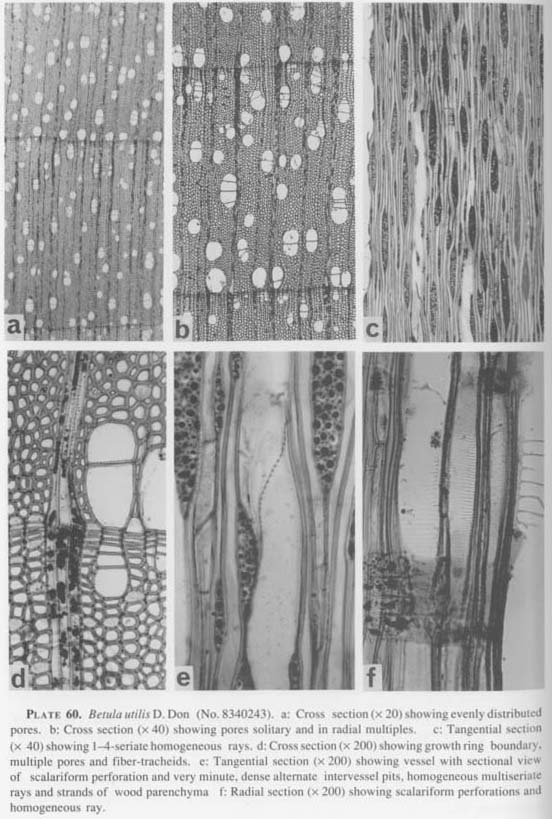
Large to small deciduous trees mainly in the subalpine and lowermost alpine zones.
SPECIMENS. No. 8340143, d=10 cm, h=8 m, alt. 2790 m; Gandaki Zone, Kaski Distr., Banthanti (2600 m) - Deorali (3050 m), H. Ohba et al., July 12, 1983. No. 8340236, d=30 cm, h=8 m, alt. 3600 m; Gandaki Zone, Manang Distr., Manang (3550 m) - Khangsar (3650 m), H. Ohba et al., July 29, 1983. No. 8340241, d=30 cm, h=6 m, alt, 3710 m: Gandaki Zone, Manang Distr., Khangsar (3650 m) - Tilicho Base Camp (4000 m), H. Ohba et al., July 30, 1983. No.8340243*, d=25 cm, h=8 m, alt. 4000 m: Gandaki Zone, Manang Distr., Tilicho Base Camp (4000 m) - Khangsar (3650 m), H. Ohba et al,, Aug. 1, 1983. No. 8340253, d=30 cm, h=8 m, alt. 3450 m; Gandaki Zone, Manang Distr., Manang (3550 m) - Humde (3320 m), H. Ohba et al., Aug. 3, 1983. No. 8340263, d=50 cm, h=10 m, alt. 3340 m: Gandaki Zone, Manang Distr., Humde (3320 m) - Pisang (3130 m), H. Ohba et al., Aug. 4, 1983. No. 8340478, d=35 cm, h=12m, alt. 3230 m: Janakpur Zone, Dolakha Distr., Thandingma (3200 m) - Becling(3600 m), H. Ohba et al., Sept. 2, 1983. No. 8340489, d=30 cm, h=8 m, alt. 3650 m: Janakpur Zone, Dolakha Distr., Beding (3600 m) - Na (4050 m), H. Ohba et al., Sept. 4, 1983. No. 8540114, d=25 cm, h=7 m, alt. 3460 m: Bagmati Zone, Rasuwa Distr., Gosainkund (4300 m) - Surjakund Pass(4530 m) - Gopte(3350 m), M. Suzuki & S. Noshiro, June 3,1985. No. 8540167, d=40 cm, h=12 m, alt. 3380 m: Bagmati Zone, Ramechap Distr., Serdingma (3400m)-Dubi Kharka (3720m), H. Ohba.et al., July 7,1985. No. 8840278. d=40 cm, h=17 m, alt. 3200 m: Koshi Zone, Sakuwasabha Distr., Mumbuk (3500 m) - Bamn Khora (3170 m), M. Suzuki et al., July 18, 1988. No. 8840574, d=30 cm, h=6.5 m, alt. 3770
m: Dhawalagiri Zone, Mustang Distr.,Yak Kharka (3850 m) - Marpha (2650 m), M. Suzuki et al., Sept. 1, 1988.
DESCRIPTION. Wood diffuse porous. Growth rings distinct, delineated by 1-3 layers of flattened elements, a little wide, 0.1-2.3 mm. Pores quite evenly distributed, sparse, 16-28/mm2, solitary and in radial multiples of 2-4, round or oval in outline, 30-126 × 30-104 µm; walls about 3 µm thick. Pith flecks absent.
Vessel elements 429-1036 µm long; perforationplates exclusively scalariform with 4-33 fine bars. Intervessel pits dense, alternate, small, 4 µm in diameter. Helical thickenings invisible. Tyloses absent.
Non-perforated tracheal elements of vascular tracheids and fiber-tracheids. Vascular tracheids apotracheal and marginal, round or polygonal in cross section, 15-37 µm in diameter, a little thick-walled, about 3 µm; bordered pits similar to the intervessel pits; helical thickenings not observed. Fiber-tracheids constituting ground mass of the wood, oval, hexagonal or polygonal in cross section, 12-30 µm in diameter, a little thick-walled, 3 µm; pits small and round with slit-like apertures; non-septate.
Wood parenchyma apotracheal, sparse, oval or polygonal in cross section, 15-30 µm in diameter. Crystals invisible.
Rays nearly homogeneous, uniseriate and multiseriate. Uniseriate rays 7-14 µm wide, and 1-15 cells and 44-400 µm tall. Multiseriate rays small, fusiform, 2-4 cells (20-45 µm) wide and usually 120-450, sometimes up to 600 µm tall; procumbent cells oval in tangential section, 10-30, 10-20 × 40-180 µm; marginal cells of the multiseriate rays nearly square cells. Ray-vessel pits minute, dense, alternate. Crystals absent.
Carpinus viminea Lindl. [Plate 61]

Medium-sized deciduous trees in the temperate zone.
SPECIMEN. No, 8340026, alt. 1850 m: Bagmati Zone, Kathmandu Valley, Mt. Pluchoki, H. Ohba et al., June 30, 1983.
DESCRIPTION. Wood diffuse porous with aggregate rays. Growth rings distinct and undulate, delineated by 2-3 layers of flattened elements, narrow to a little wide, 0.2-2 mm. Pores evenly distributed with tendency to be radially, 20-38/mm2, mostly in radial multiples of 2-6 or solitary; solitary pores oval in outline, small, 37-107 × 22-104 µm, a little thick-walled, 4-6 µm. Pith flecks occasionally present.
Vessel elements 296-814 µm long; perforation plates exclusively simple; intervessel pits alternate, dense, a little large polygonal in outline, 9-11 µm in diameter, with slit-like apertures. Helical thickenings not observed. Tyloses absent.
Non-perforated tracheal elements fiber-tracheids, constituting ground mass of the wood, oval or polygonal in cross section, 8-23 µm in diameter, thick-walled, 4 µm; bordered pits small round with slit-like apertures; non-septate; helical thickenings not observed.
Wood parenchyma apotracheal banded and paratracheal; banded in one or two tangential layers, oval or polygonal in cross section, 12-27 µm in diameter. Crystals absent.
Rays heterogeneous, uniseriate, multiseriate and aggregate. Uniseriate rays 2-35 cells or 44-636 µm tall. Multiseriate rays slender distorted fusiform, 2-4-(6) cells or 22-59(-178) µm wide and 89-1184 µm tall, with uniseriate wings of 1-19 cells tall. Uniseriate rays and uniseriate wings consisting of upright and square cells, which slender triangle or rectangle in tangential section, 20-40, 8-28 × 10-30 µm; central core of multiseriate portions of procumbent cells, which oval or vertically elliptical in tangential section, 12-20, 5-13 × 30-140 µm . Aggregate rays wide and very tall. Ray-vessel pits dense and alternate, oval or horizontally elliptical in outline, 5-12.5 µm m in diameter, with horizontally long apertures. Rhomboidal crystals occasionally present in swollen cells.
Corylus ferox Wall. [Plate 62]

Small to medium-sized deciduous trees; one of the main elements of deciduous forests from the upper temperate to lower sub-alpine zones.
SPECIMENS. No. 8340455*, d=8 cm, h=3.5 m, alt, 2670 m: Rolwaring Khora, Simigaon(1950m) - Sekpa (2300 m) - Kyarche (2700 m), H. Ohba et al., Aug. 31, 1983. No. 8540087, d=35 cm, h=7 m, alt. 2760 m: Bagmati Zone, Rasuwa Distr., Ghora Tabela (3000 m) - Lama Hotel (2480 m), M. Suzuki & S. Noshiro, May 29, 1985. No. 8540213, d=25 cm, h=6 m, alt. 2770 m: Bagmati Zone, Ramechap Distr., Neju (3650 m) - Choarma (2760 m), H. Ohba et al., Aug. 2, 1985. No. 8840634, d=35 cm, h=14 m, alt. 2560 m: Bagmati Zone, Kathmandu Valley, Shiwapuri Danda, M. Suzuki et al., Sept. 14, 1988.
DESCRIPTION. Wood diffuse porous with aggregate rays. Growth rings distinct, delineated by 2-4 layers of flattened elements width narrow, 0.37-0.9 mm wide. Pores evenly distribute, dense, 36-61/mm2, mostly in radial multiples of 2-5 or sometimes solitary; solitary pores oval or round in outline, 30-67 × 28-59 µm, thin-walled (2 ×). Pith flecks present.
Vessel elements 252-918 × long. Perforation plates exclusively scalariform with rather fewer, 2-27, thin bars. Intervessel pits dense, alternate, polygonal to horizontally long elliptical in outline, 4-13 ×m in diameter. Helical thickenings not observed. Tyloses absent.
Non-perforated tracheal elements fiber-tracheids, constituting ground mass of the wood, oval, elliptical or square in cross section, 8-27 µm in diameter, fairly thick-walled (4 µm), with slit-like apertures; non-septate; helical thickenings not observed.
Wood parenchyma apotracheal, sparse, angular or oval in cross section, 11-27 µm in diameter, thin-walled. Crystals absent.
Rays heterogeneous, uniseriate, multiseriate and aggregate. Uniseriate rays numerous, consisting of upright and square cells, 2-33 cells or 89-814 µm tall. Multiseriate rays narrow fusiform, 2-3 cells or 22-59 µm wide and 104-1036 µm tall; multiseriate portions consisting of procumbent cells; uniseriate wings 2-19 cells or more tall, consisting of upright and square cells. Aggregate rays loose, fairly wide and very tall. Upright and square cells triangular slender-elliptical in tangential section, 20-95, 15-45 × 17-45 µm; procumbent cells oval or vertically elliptical in tangential section, 15-20, 5-15 × 20-100 µm. Ray-vessel pits minute, dense and alternate. Crystals absent.

























































